Primates Using Tools Funny Political Cartoons
Edmund S. Valtman // Library of Congress
Political cartoons from the last 100 years
Cartoons have long caught the public's attention, featuring social or political overtones, and intending to highlight a pressing issue. The nature of these cartoons has changed over the centuries, accommodating a widespread appetite for vitriolic humor or even propaganda. In the case of Martin Luther's pamphlet "Passional Christi und Antichristi," drawn by Lucas Cranach the Elder, the issue was the opposition to the Roman Catholic church in 16th-century Germany. Cartoons have since evolved to caricatural, abstract, punchline-based, and many other styles.
In America's first-ever cartoon in 1754, " Join or Die," Benjamin Franklin called for the unity of the 13 colonies. Even though Franklin's cartoon did not fulfill its intended purpose, it was reused by colonists protesting British rule.
The word itself comes from the Italian word cartone, referring to a kind of cardboard used in the 17th century to transfer images onto fresco or a wall. And though political cartoons continue to represent social and political reform, they continue to evolve in a way that accentuates the artists' talent and wit. They're integral to news and media outlets worldwide and have been a necessary catalyst to change and political dialogue.
Stacker went through the Library of Congress, newspapers, magazine archives, and art and photo libraries to find the most compelling 100 political cartoons over the last 100 years.
You may also like: Former jobs of the governor of every state
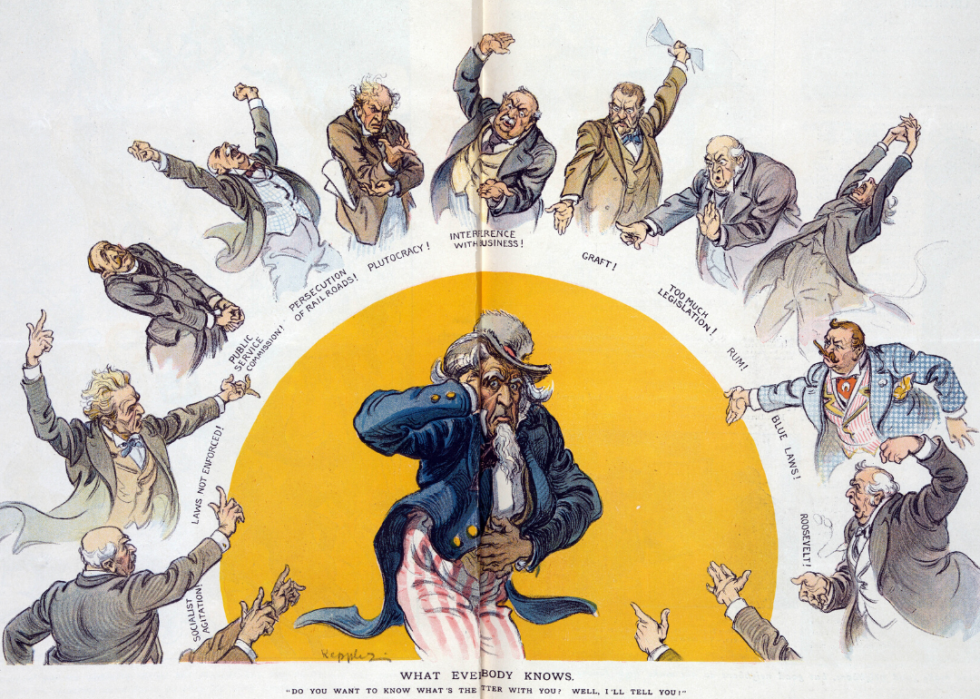
1 / 100
Photo12/Universal Images Group // Getty Images
1911: 'What Everybody Knows'
In "What everybody knows," artist Udo J. Keppler draws Uncle Sam surrounded by men bemoaning the woes of the United States. At the time, the death rate from cirrhosis was nearly 30 per 100,000 men. This rate dropped to about 11 per 100,000 by 1929, when Prohibition had been in effect for nearly a decade.
[Pictured: "What everybody knows" by Udo J. Keppler for Puck Magazine dated Jan. 25, 1911.]
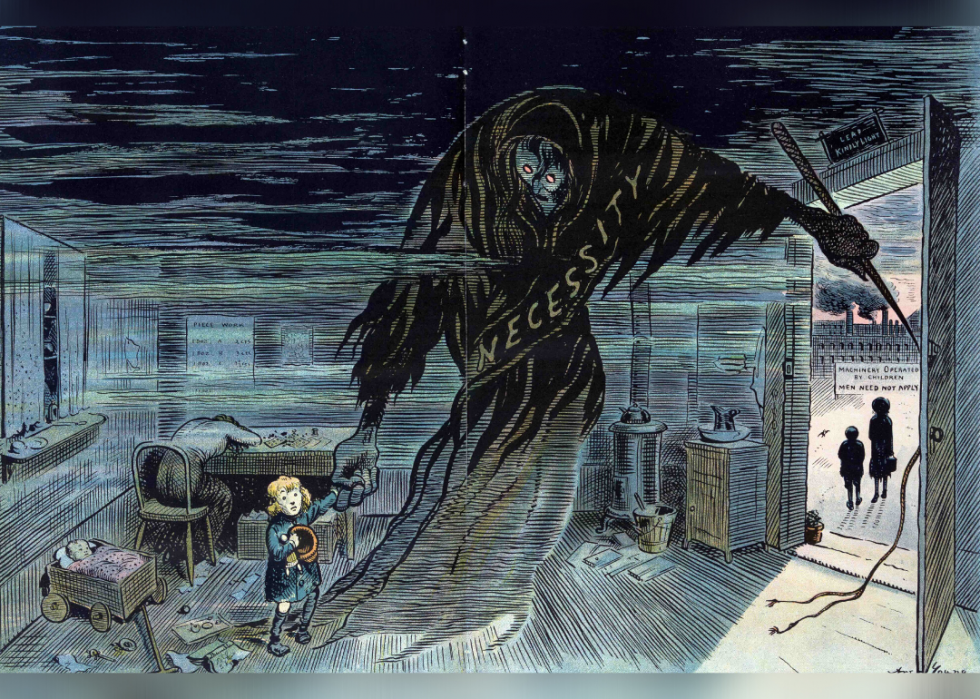
2 / 100
Photo12/Universal Images Group // Getty Images
1912: 'Next From Cradle to the Mill'
"Next From Cradle to the Mill" is a brutal portrayal of child labor early in the 20th century. A monsterous figure with "Necessity" written on it takes a child by the hand menacingly. In the background, a man's head is down on a desk, while two children walk toward a factory that says "Machinery Operated by Children." The cartoon brings to mind the public hearing of Camilla Teoli, who worked as a child at a wool factory and experienced a disfiguring accident.
[Pictured: "Next! From Cradle to the Mill" by Art Young for Puck Magazine dated April 1912.]
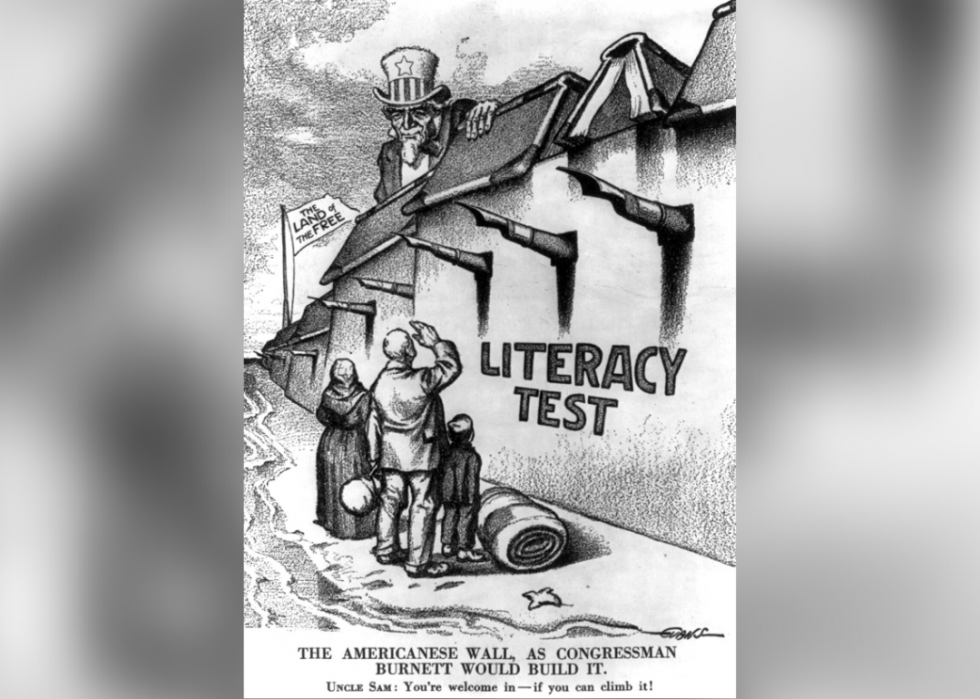
3 / 100
Evans/Library of Congress/Interim Archives // Getty Images
1916: 'The Americanese Wall, As Congressman Burnett Would Build It'
"The Americanese Wall, As Congressman Burnett Would Build It" satirizes the 1917 immigration act imposed by Congressman John Lawson Burnett by drawing literacy tests as a wall. Evans drew the wall with pens sticking out of it, while Uncle Sam looks on.
[Pictured: "The Americanese Wall, As Congressman Burnett Would Build It" by Raymond O. Evans for Puck Magazine.]
You may also like: Countries that have mandatory voting
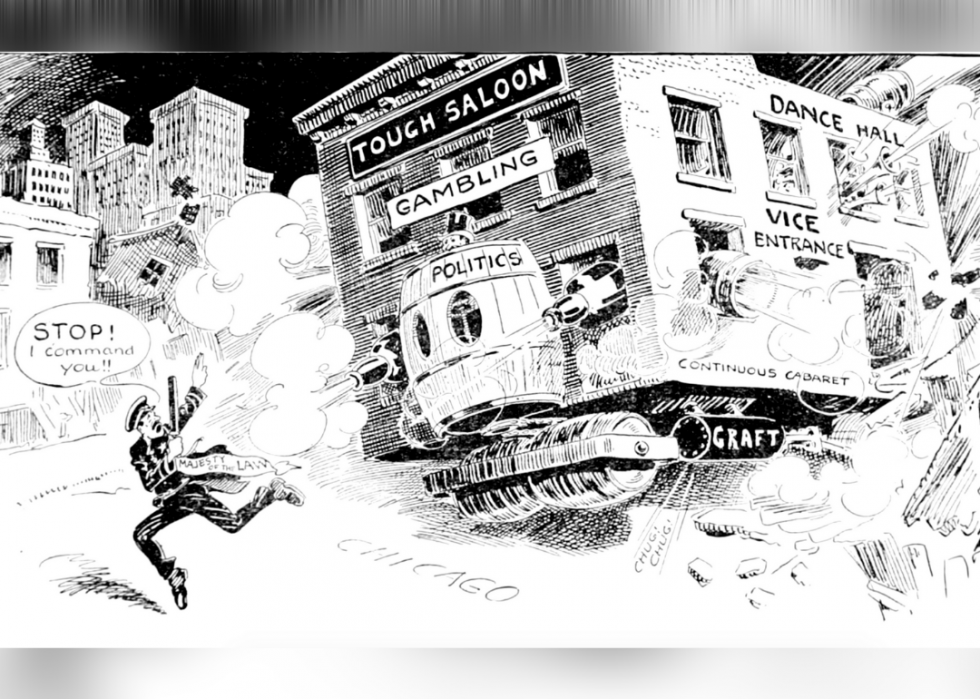
4 / 100
Luther Daniels Bradley // Wikimedia Commons
1917: 'Not All the Tanks Are in Europe'
"Not All the Tanks Are in Europe" shows how a law enforcer is alone in fighting crime and corruption, symbolized by an army tank on the streets of Chicago. At the time, it was common practice for politicians to be in alliance with criminals in Chicago. At times, these politicians protected Chicago's mob bosses and outlaws.
[Pictured: "Not all the Tanks are in Europe" by Luther Daniels Bradley.]
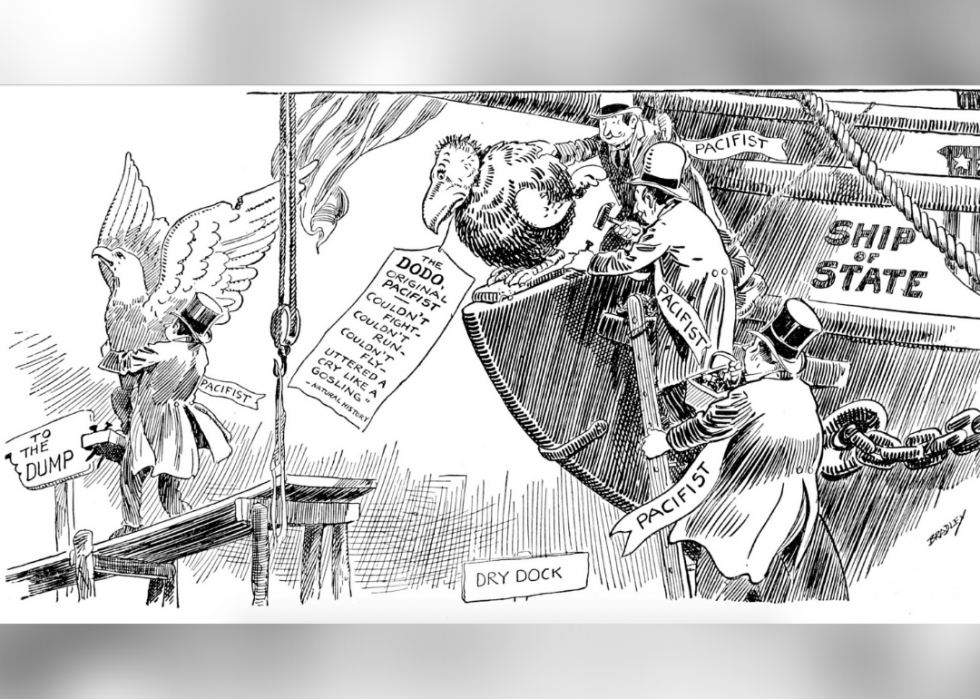
5 / 100
Luther Daniels Bradley // Wikimedia Commons
1917: 'Perhaps They Would Like It for a Figurehead?'
In "Perhaps They Would Like It for a Figurehead," Luther Daniels Bradley mocks America's lack of action in World War I by replacing the famous American eagle. Three pacifists can be seen in the cartoon removing the eagle with a sign that says "The Dodo Doesn't Work."
[Pictured: "Perhaps they would like it for a figurehead?" by Luther Daniels Bradley.]
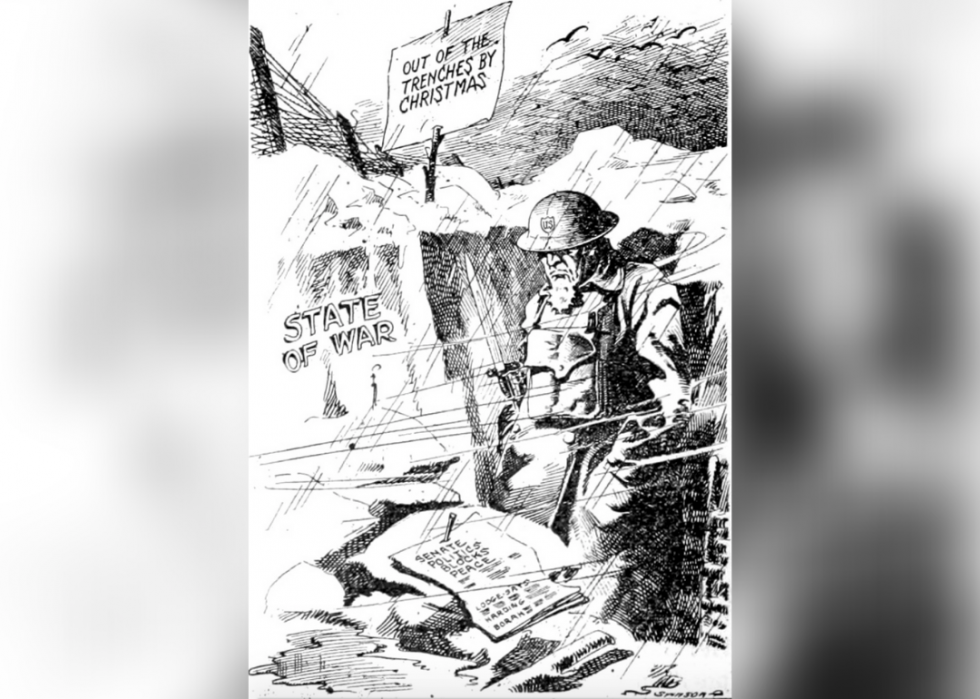
6 / 100
Homer Stinson/Dayton Daily News // Wikimedia Commons
1920: 'Christmas of What Year?'
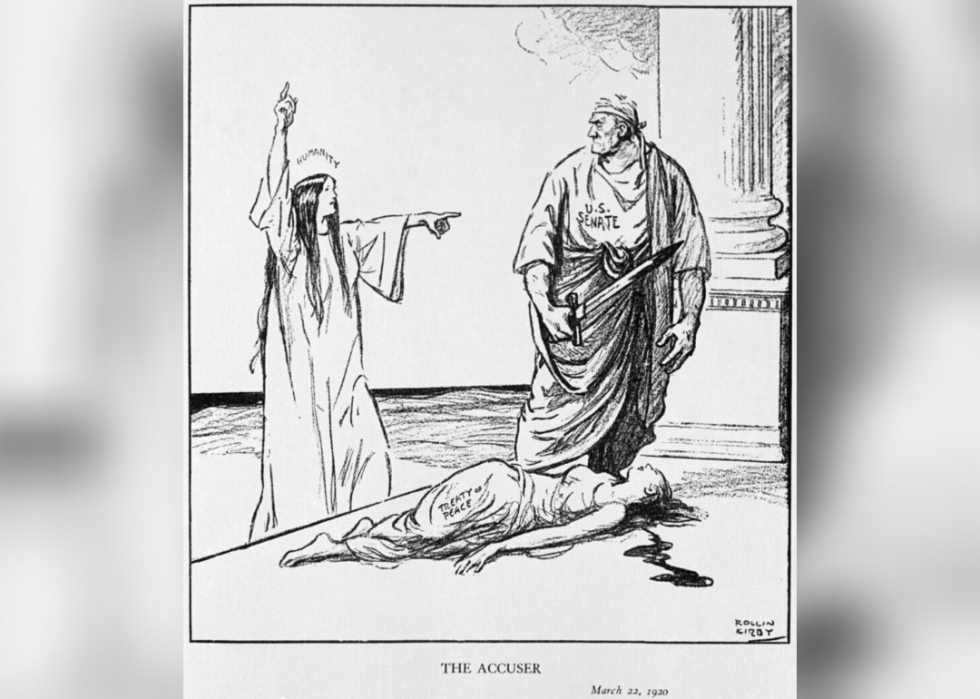
7 / 100
Rollin Kirby/Bettmann // Getty Images
1920: 'The Accuser'
"The Accuser" shows a woman reprimanding the U.S. Senate for killing what's lying on the ground: " The treaty of peace." This referred to the Treaty of Versailles, which brought to an end to the war between the Allied Powers and Germany.
[Pictured: "The Accuser" by Rollin Kirby for New York World dated March 20, 1920.]
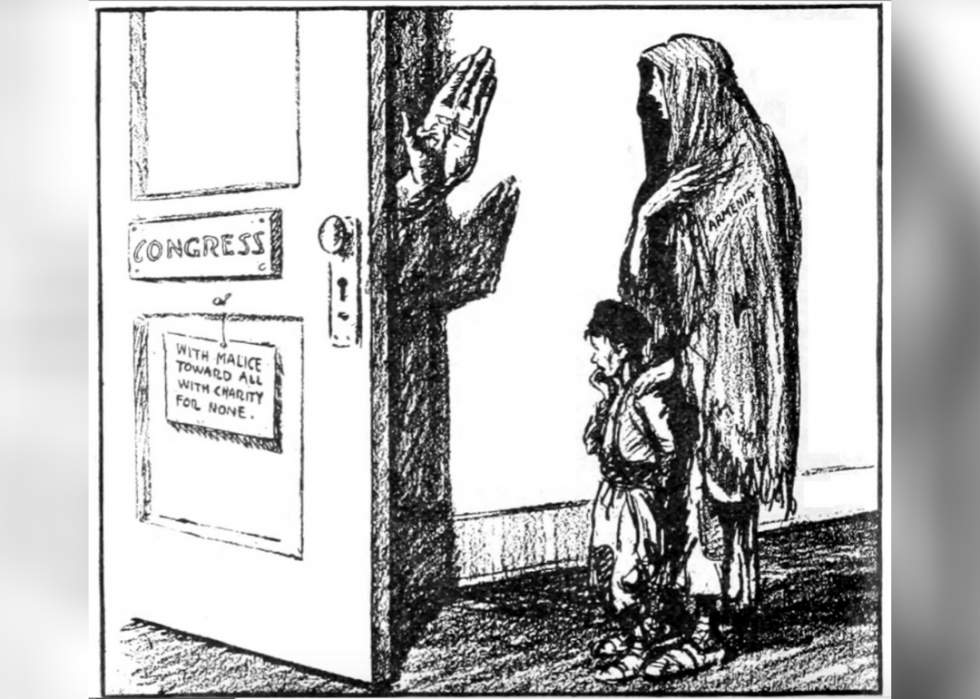
8 / 100
Rollin Kirby/New York World // Wikimedia Commons
1920: 'Go Away!'
In "Go Away!" Rollin Kirby drew Congress from behind doors gesturing to Armenia with a sign that says "With malice towards all, with charity towards none." This cartoon represents America's non-recognition of the Armenian Genocide.
[Pictured: "Go Away!" by Rollin Kirby for New York World dated June 12, 1920.]
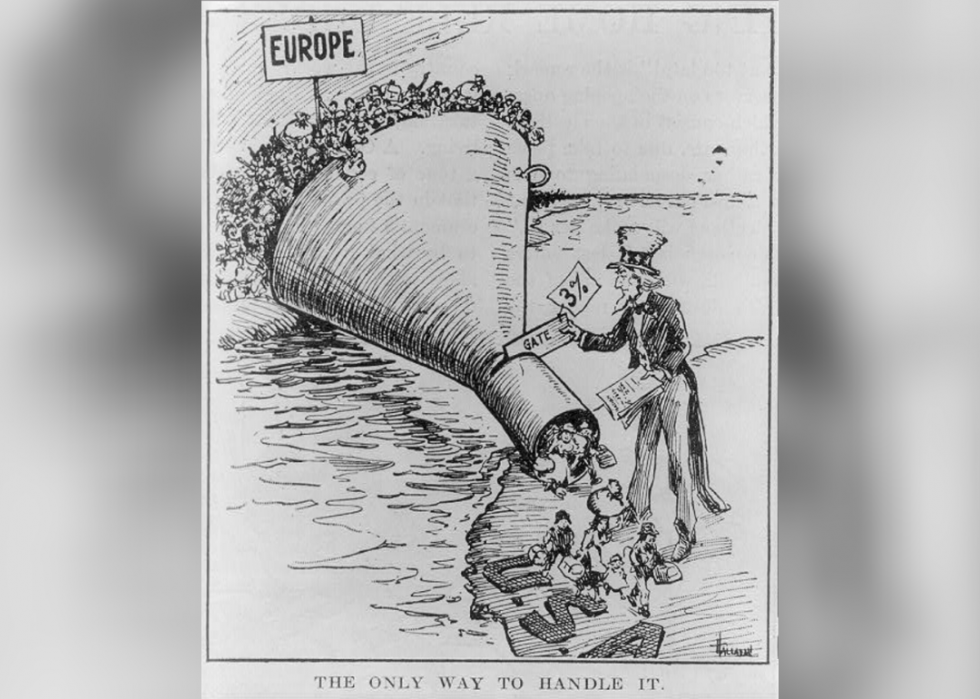
9 / 100
Hallahan/Providence Evening Bulletin // Library of Congress
1921: 'The Only Way to Handle It'
This cartoon shows America's reluctance at the time to take in refugees. "The Only Way to Handle It" portrays Uncle Sam using a funnel to let in refugees, with an influx from the top.
[Pictured: "The Only Way to Handle It" by Hallahan for Providence Evening Bulletin dated May 7, 1921.]
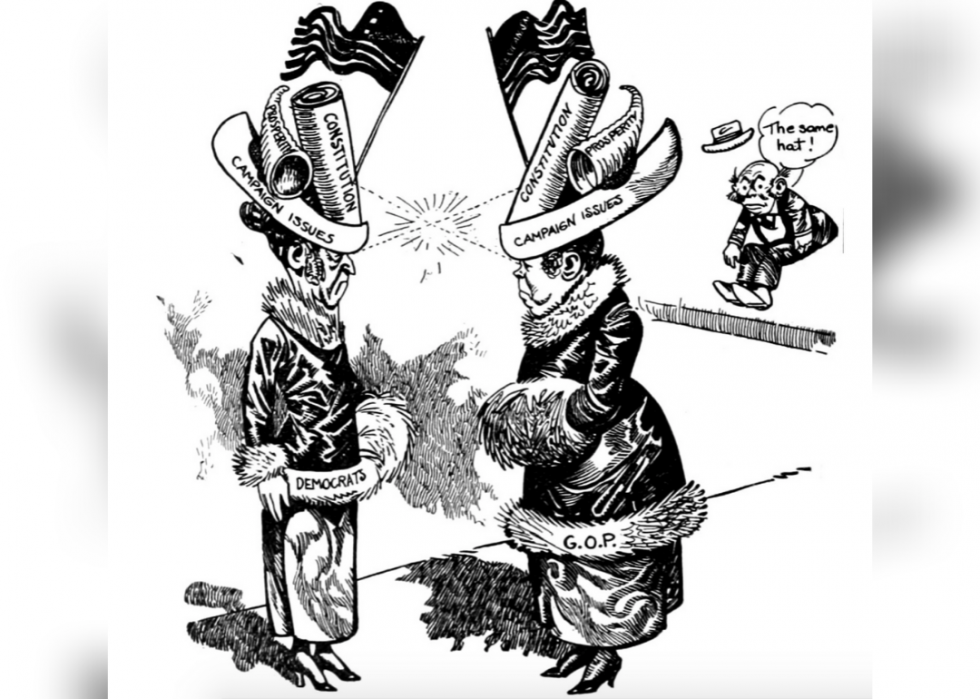
10 / 100
Burt Thomas/The Detroit News // Wikimedia Commons
1920: 'Why They Hate Each Other'
Burt Thomas drew the GOP and the Democrats wearing matching hats and toting the same issues, with a citizen watching on. The cartoon mocks the striking similarities between the two parties.
[Pictured: "Why They Hate Each Other" by Burt Thomas for The Detroit News dated March 6, 1920.]
You may also like: Highest-paid employees in the White House
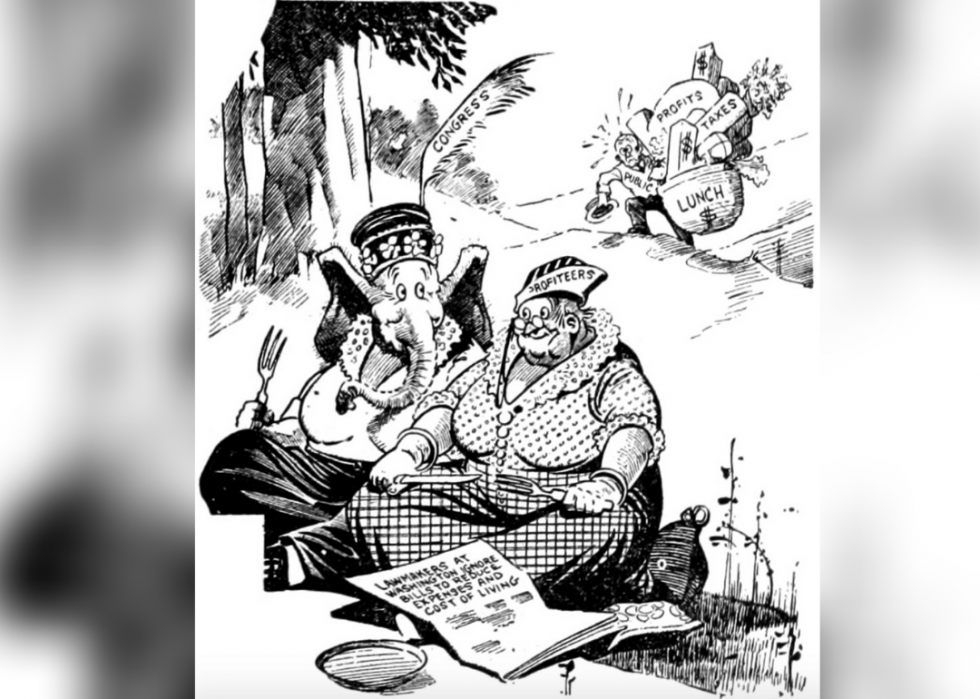
11 / 100
Homer Stinson/Dayton Daily News // Wikimedia Commons
1920: 'Dontcha Just Love These Little Informal Picnics?'
Homer Stinson stunned his readers by drawing Congress and profiteers preparing for a hearty meal, while the public is in the background carrying taxes, profits, and lunch to them. The cartoon was part of an editorial called "Where the Money Is."
[Pictured: "Doncha just love these little informal picnics?" by Homer Stinson for Dayton Daily News dated June 5, 1920.]
You may also like: Most and least popular senators in America
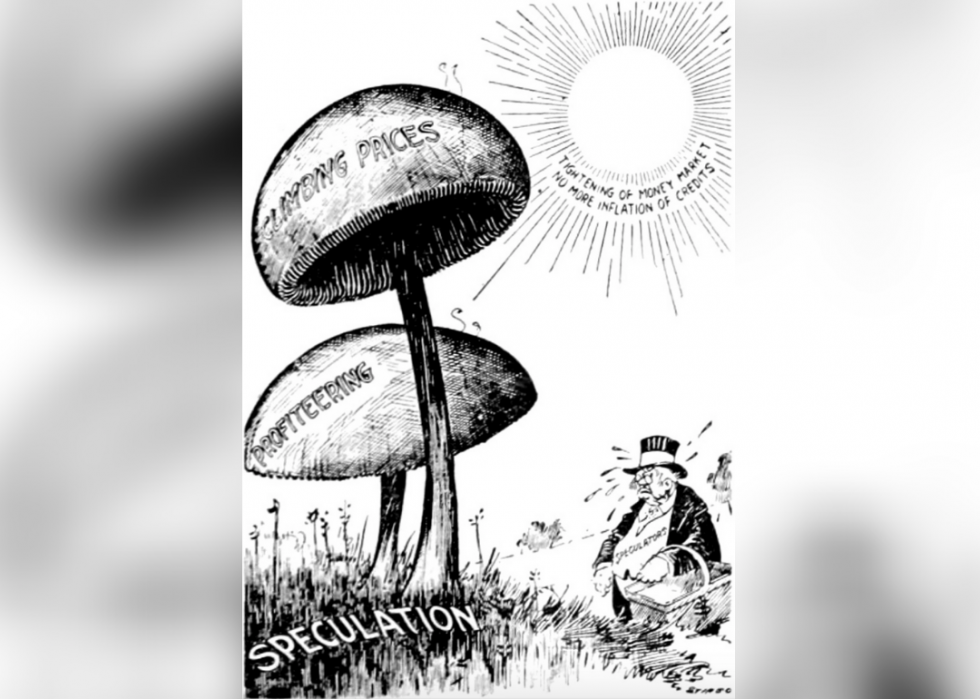
12 / 100
Homer Stinson/Dayton Daily News // Wikimedia Commons
1920: 'Hot Sunshine is Ruinous For Mushrooms'
In ''Hot Sunshine is Ruinous for Mushrooms," Stinson shows mushrooms as climbing prices and profits, while the sun rays tighten the money market. This ruins the mushrooms, referring to the Great Depression.
[Pictured: "Hot sunshine is ruinous for mushrooms" by Homer Stinson for Dayton Daily News dated June 12, 1920.]
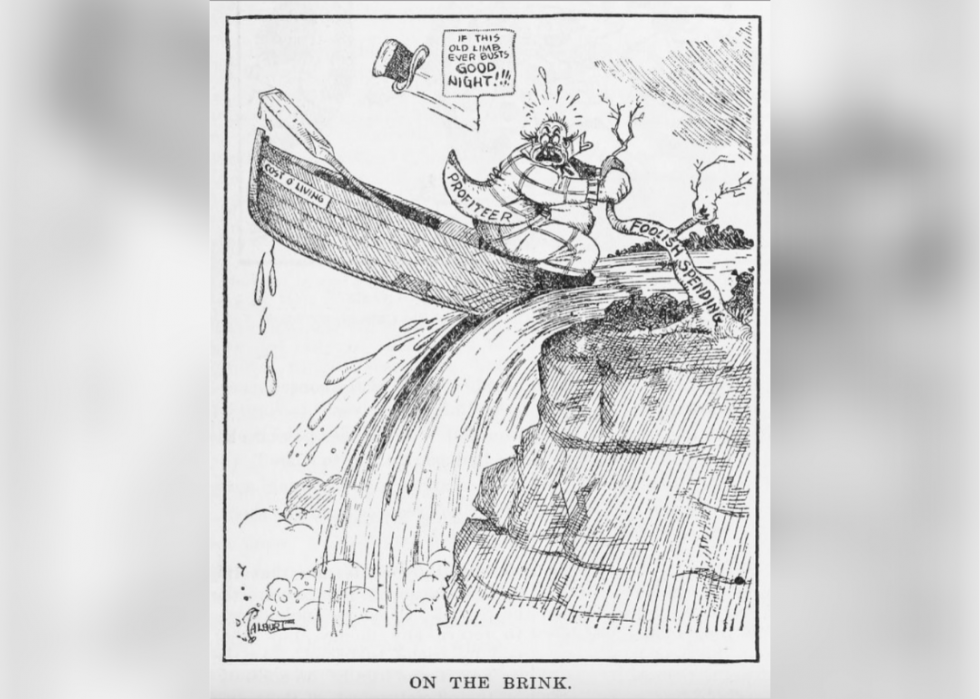
13 / 100
H.M. Talburt // Wikimedia Commons
1920: 'On the Brink'
Another cartoon about the Great Depression is H. M. Talbur's depiction of an obese profiteer rowing a boat titled "Cost of Living" while holding a wilting branch ("foolish spending").
[Pictured: "On the brink" by H.M. Talburt for the Literary Digest dated Oct. 9, 1920.]
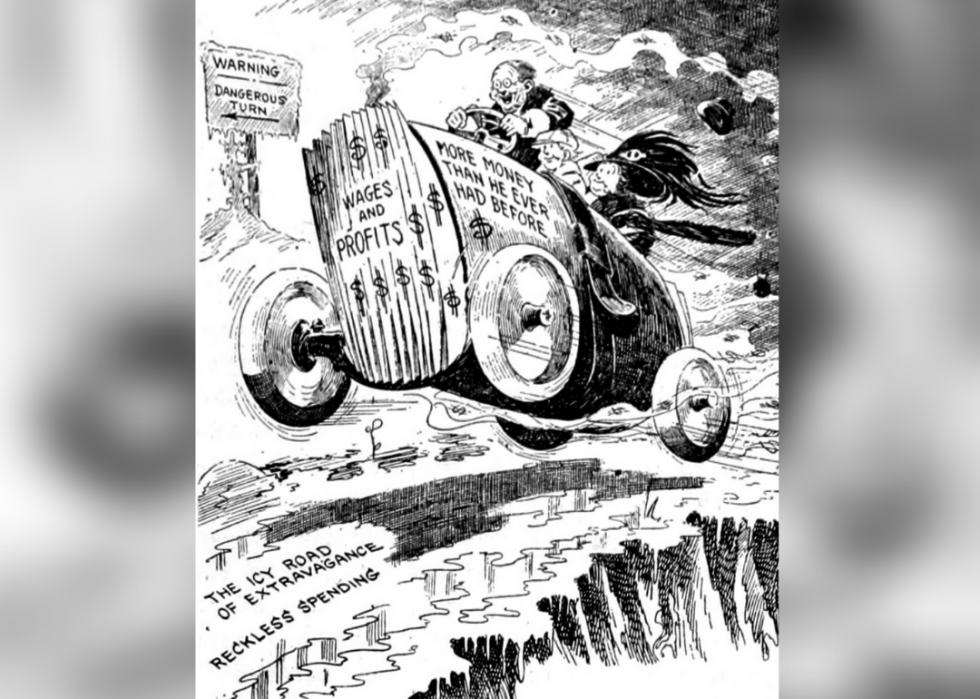
14 / 100
Homer Stinson/Dayton Daily News // Wikimedia Commons
1920: 'Better Put On Chains'
Americans in the 1920s spent money on expensive clothes and other ready-made items. Such extravagance was referred to as "The Roaring Twenties." " Better Put on Chains" shows a speeding car with wages and profits on it. Ahead is a wrong turn, following an icy road of reckless spending.
[Pictured: "Better put on chains!" by Homer Stinson for Dayton Daily News dated May 29, 1920.]
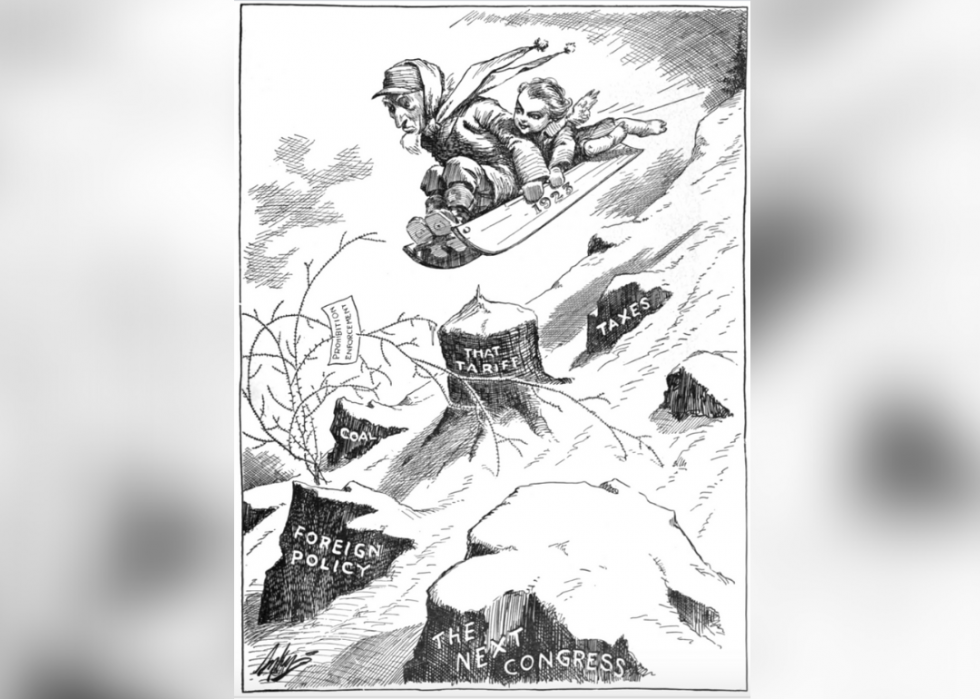
15 / 100
Charles H. Sykes // Wikimedia Commons
1923: 'At That, We'll Get Some Fun Out of It'
"At That, We'll Get Some Fun Out of It" shows a rugged Uncle Sam with a cherub on a sled, gliding down issues like taxes, foreign policy, and Prohibition enforcement.
[Pictured: "At that, we'll get some fun out of it" by Charles H. Sykes for Life Magazine dated Dec. 28, 1922.]
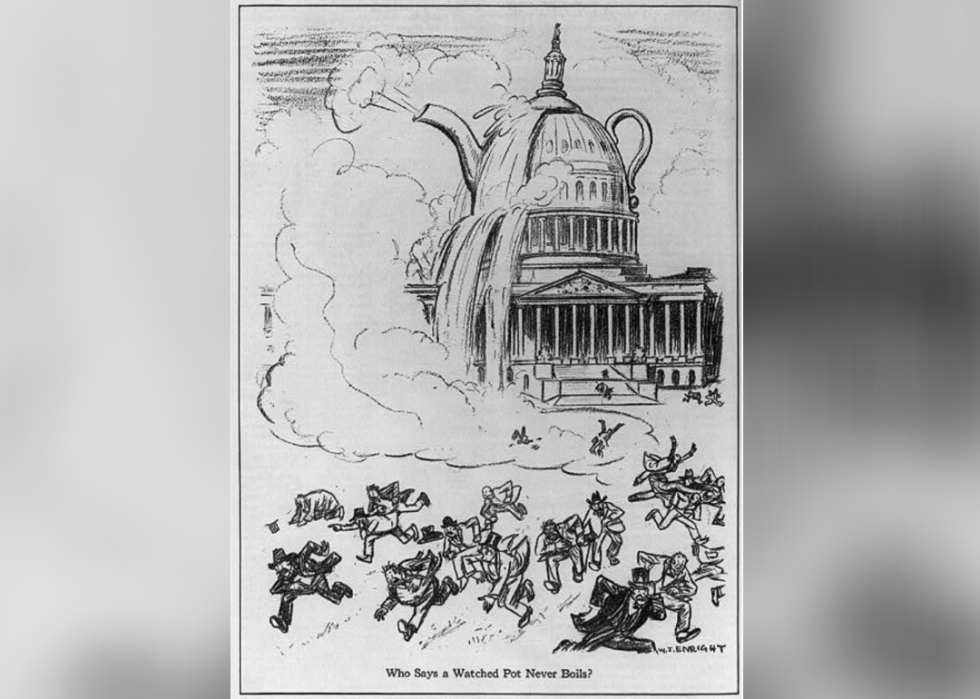
16 / 100
W.T. Enright // Library of Congress
1924: 'Who Says a Watched Pot Never Boils?'
After the Teapot Dome scandal, which shook the Harding administration, W. T. Enright illustrated this cartoon showing a teapot overspilling while people flee.
[Pictured: "Who says a watched pot never boils?" by W.T. Enright for Judge Magazine dated Feb. 23, 1924.]
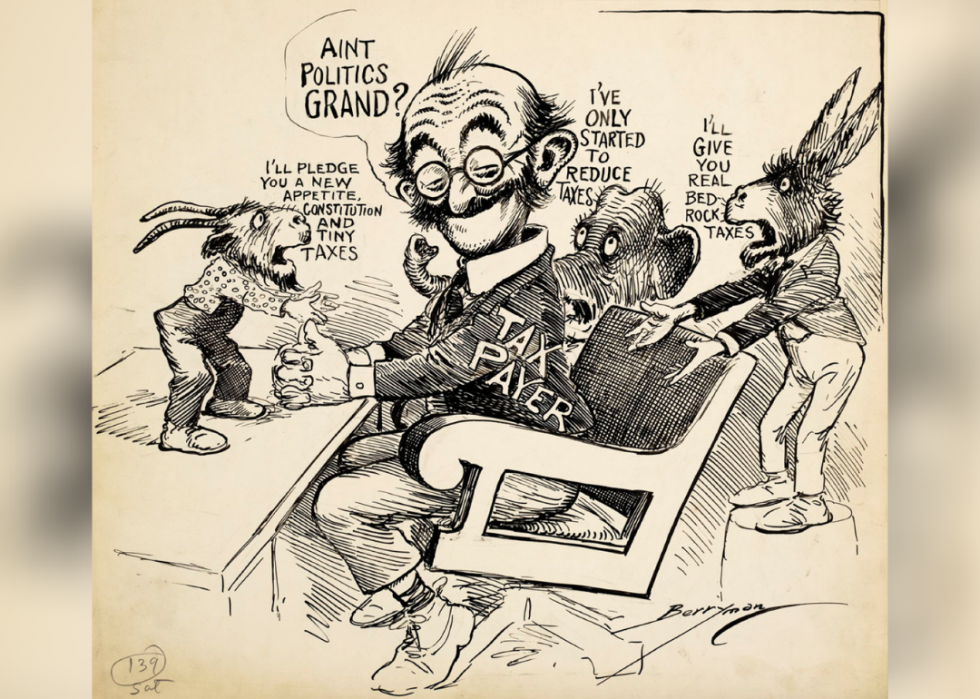
17 / 100
Clifford Kennedy Berryman // U.S. National Archives
1924: 'Ain't Politics Grand?'
"Ain't Politics Grand?" depicts the fight Democrats, the GOP, and Progressives were having in 1924. The cartoon shows three animals representing three factions, while the taxpayer sits in the middle, marveling.
[Pictured: "Ain't politics grand?" by Clifford Kennedy Berryman dated Oct. 18, 1924.]
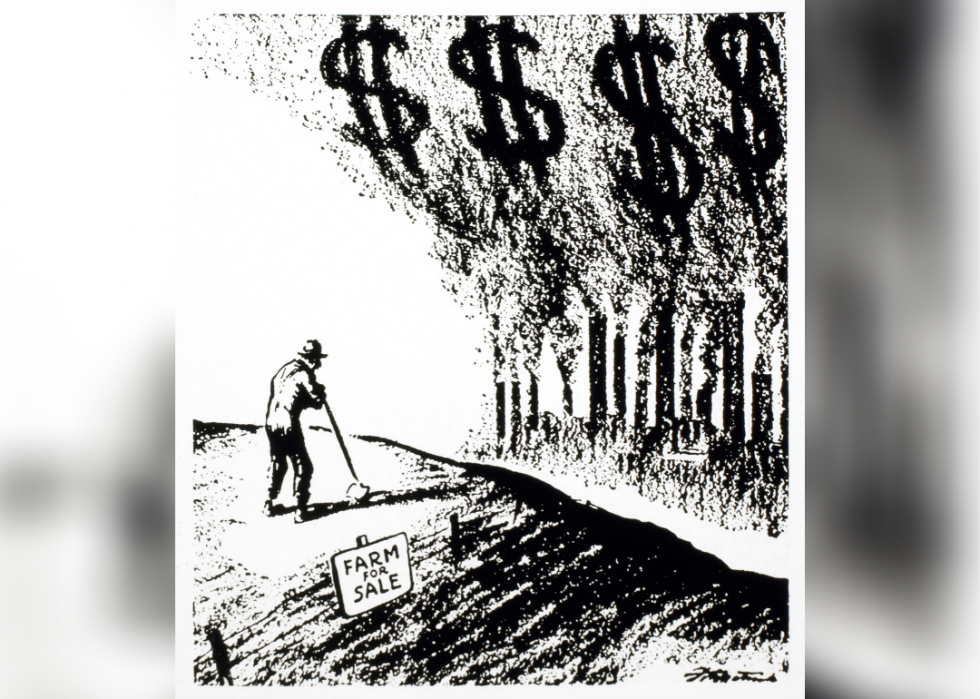
18 / 100
Universal History Archive/Universal Images Group // Getty Images
1925: 'Farm for Sale'
This cartoon shows dollar signs burning down a farm for sale, as a helpless farmer looks on. The cartoon illustrated the fall in farm prices during these years and the struggles farmers faced.
[Pictured: "Farm for Sale" by unidentified artist dated 1925.]
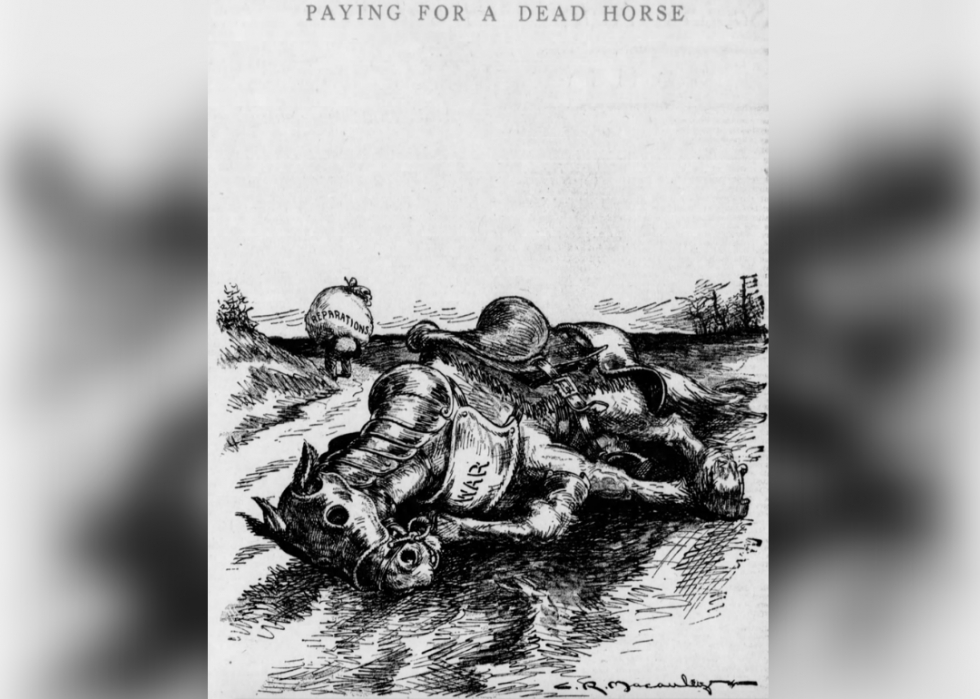
19 / 100
Charles R. Macauley/Brooklyn Daily Eagle // Wikimedia Commons
1929: 'Paying for a Dead Horse'
Charles R. Maccauley's 1930 commentary on reparations following World War I won the Pulitzer Prize for editorial cartooning. The powerful imagery depicts the consequences of war in the image of a dead horse, while provisions and reparations are carried by one man in the background. While the Treaty of Versaille, which stipulated such reparations, was signed in 1919, hyperinflation and defaulted payments left Allied relations with Germany fraught. The Young Plan, written in August 1929, effectively reduced the reparations owed by Germany by 17% but was quickly thrown into flux by the onset of the Great Depression.
[Pictured: "Paying for a Dead Horse" by Charles R. Maccauley for the Brooklyn Daily Eagle dated Feb. 23, 1929.]
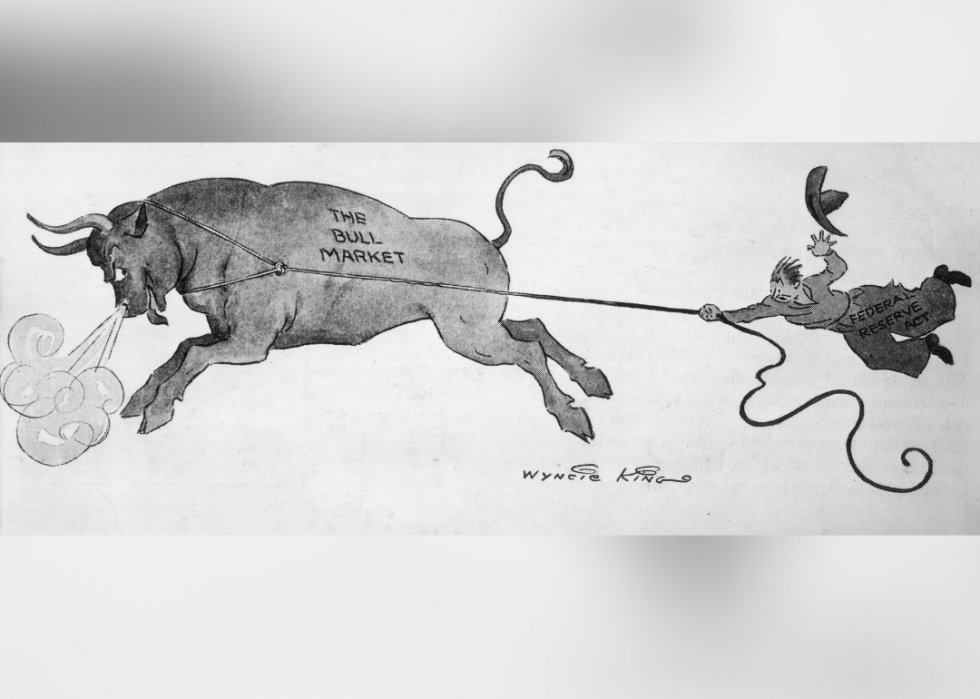
20 / 100
Henry Guttmann/Hulton Archive // Getty Images
1929: 'The Bull Market'
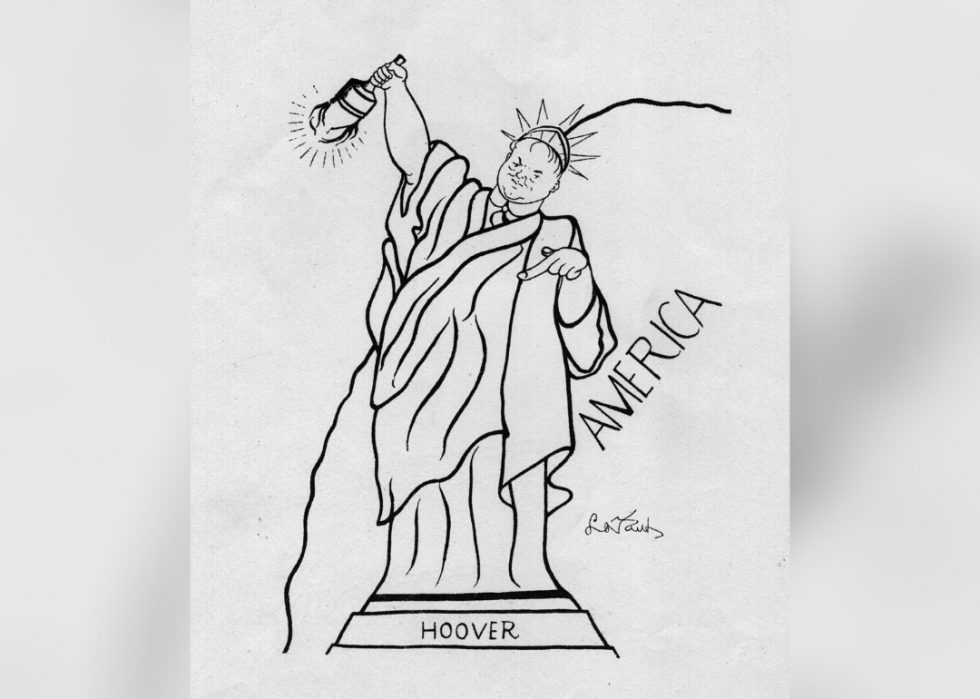
21 / 100
Hulton Archive // Getty Images
1929: 'Cartoon Hoover'
In "Cartoon Hoover," the Statue of Liberty is replaced by President Herbert Hoover, who can be seen lowering his torch. The cartoon refers to the Hoover administration's big-spending policy, which led to the collapse of Wall Street.
[Pictured: Cartoon by unknown artist circa 1929.]
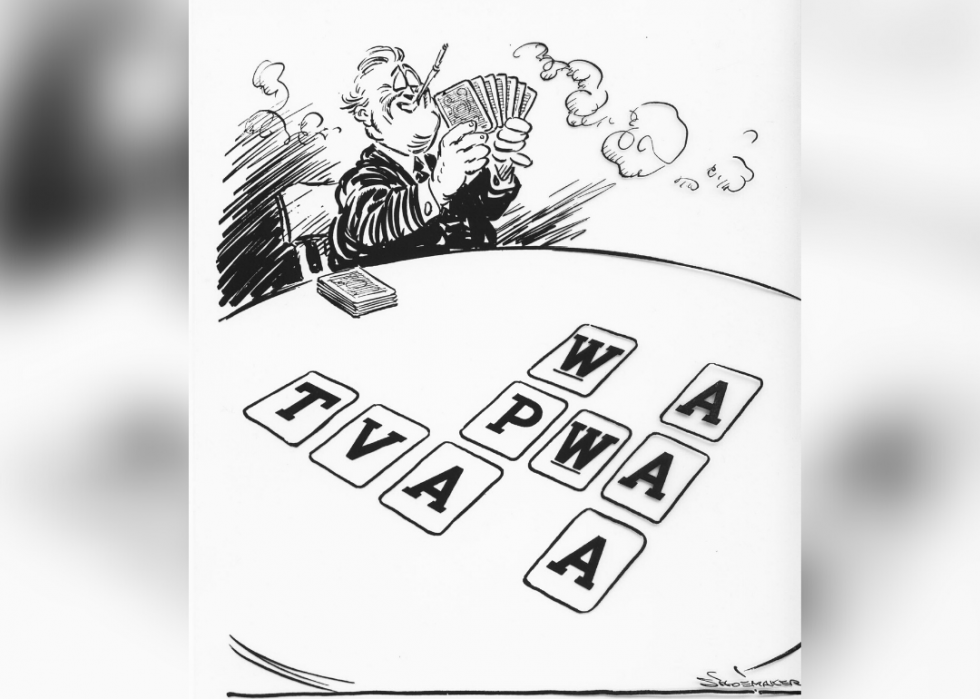
22 / 100
Vaughn Shoemaker/Photo 12/Universal Images Group // Getty Images
1930: 'FDR's Alphabet Cards'
President Franklin D. Roosevelt created "alphabet agencies," which were part of his signature set of policies to provide relief during the Great Depression. This cartoon mocked his "New Deal," likening it to a set of cards that teach children the alphabet. People at the time said the programs were reminiscent of "alphabet soup."
[Pictured: FDR's Alphabet agencies by Vaughn Shoemaker for Chicago Daily News dated 1935.]
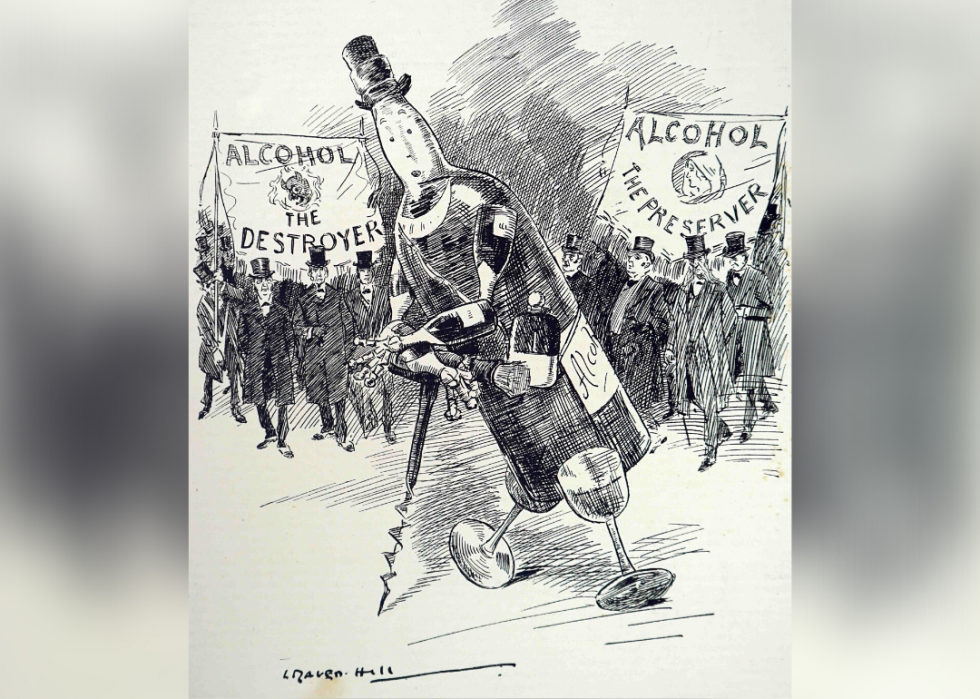
23 / 100
Universal History Archive/Universal Images Group // Getty Images
Prohibition Era: 'The Temperance Movement'
This Prohibition-era cartoon depicts a bottle being alternately vilified and defended by each side of the issue. The Temperance Movement proved to be a divisive era, with pro and anti-alcohol citizens speaking out.
[Pictured: Cartoon by Leonard Raven-Hill circa 1920s or early 1930s.]
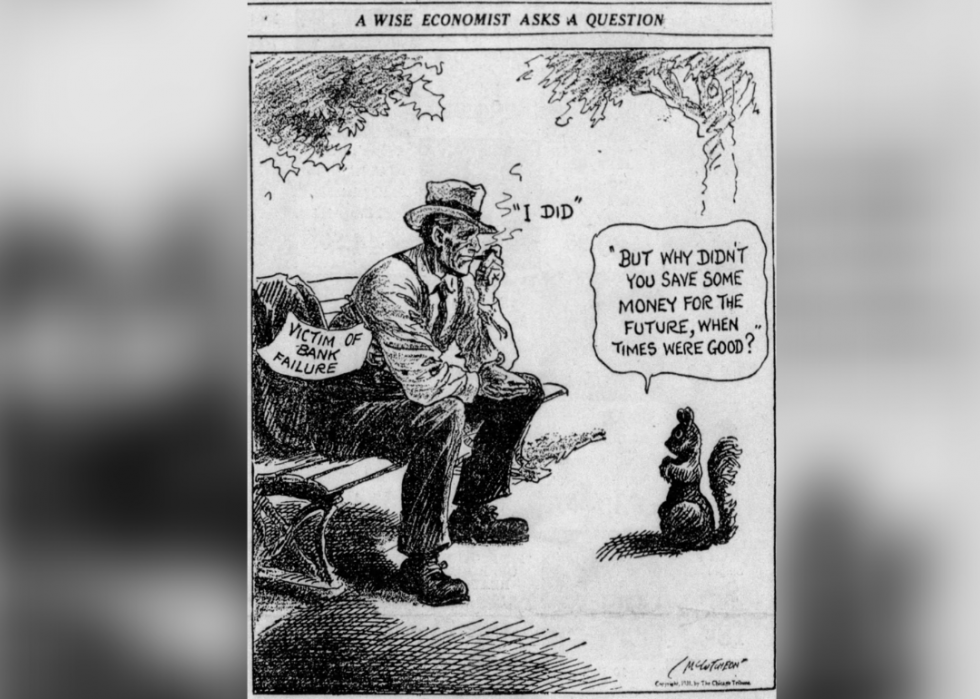
24 / 100
John T. McCutcheon/Chicago Tribune // Wikimedia Commons
1931: 'A Wise Economist Asks a Question'
In "A Wise Economist Asks a Question," which won a Pulitzer in 1932, John T. McCutcheon describes bank failures during the Great Depression. The economist in this cartoon is a squirrel asking a new victim of bank failure if he had saved for a bad day.
[Pictured: "A Wise Economist Asks a Question" by John T. McCutcheon for the Chicago Tribune dated Aug. 19, 1931.]
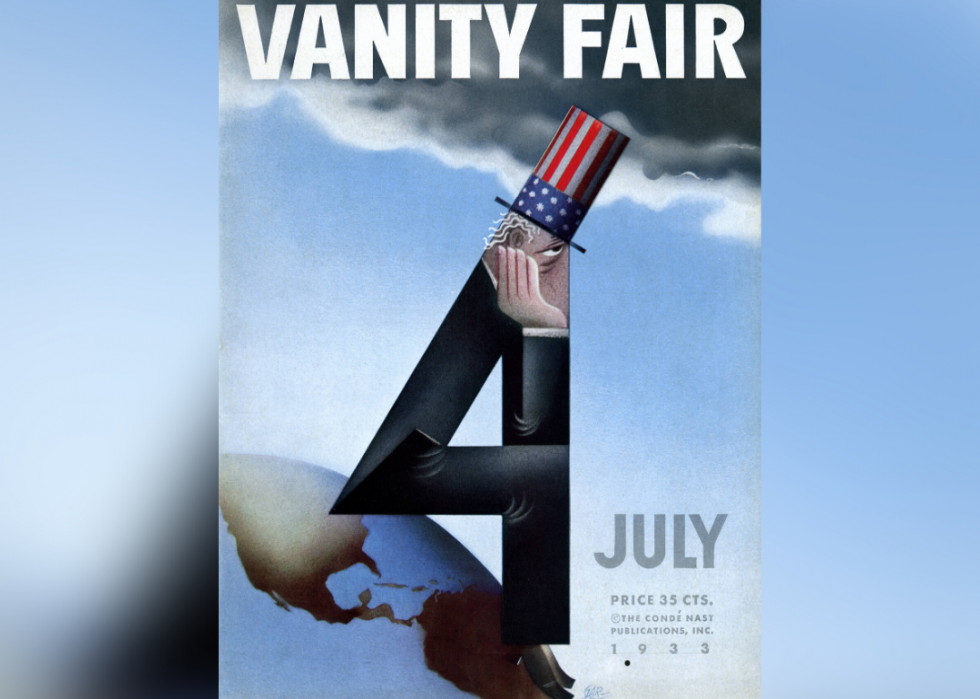
25 / 100
Garretto/Condé Nast // Getty Images
1933: 'The Fourth of July's Uncle Sam'
A frustrated Uncle Sam sits on a massive globe in "The Fourth of July's Uncle Sam." The cartoon was drawn by Paolo Garretto, who helped shape Vanity Fair's refined style.
[Pictured: "The Fourth of July's Uncle Sam" by Paolo Garretto for Vanity Fair dated July 1933.]
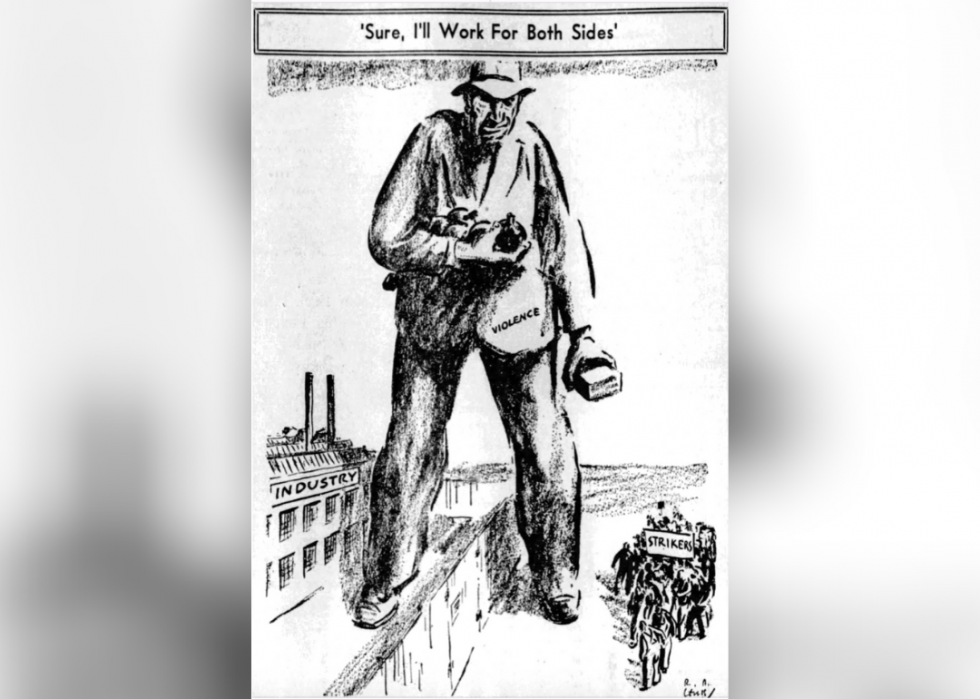
26 / 100
Ross A. Lewis/Milwaukee Journal // Wikimedia Commons
1934: 'Sure, I'll Work for Both Sides'
A wave of violent strikes broke out from Maine to Alabama in 1934. Ross A. Lewis painted a picture of violence on both sides: strikers and anti-unionists. In 1935, the cartoon won a Pulitzer Prize.
[Pictured: "Sure, I'll Work for Both Sides" by Ross A. Lewis for the Milwaukee Journal dated Sept. 1, 1934.]
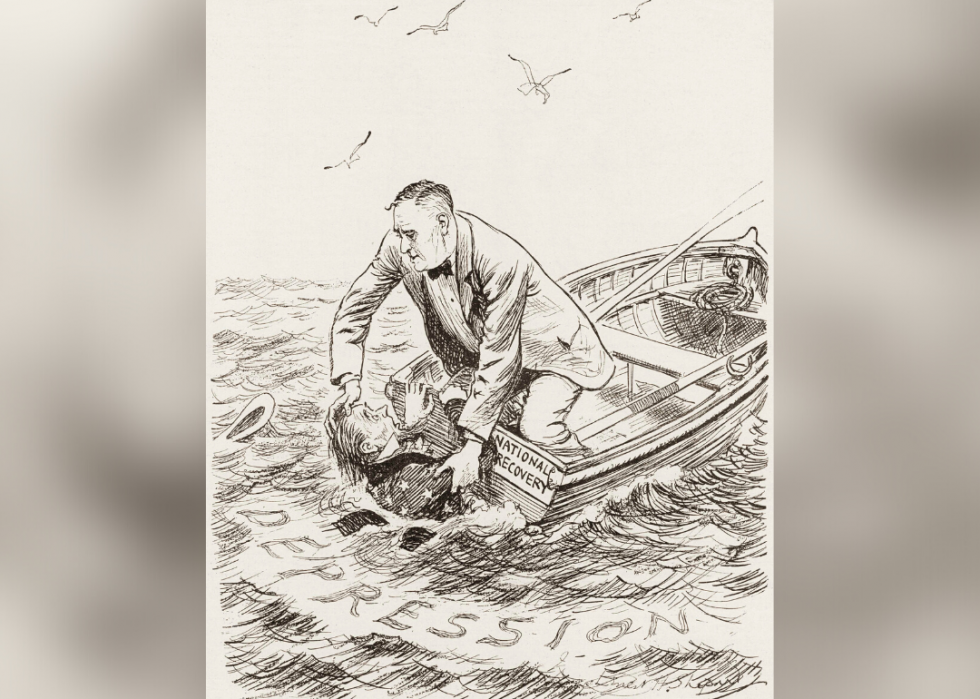
27 / 100
Ernest H. Shepard/Stock Montage // Getty Images
1935: 'The Illegal Act'
"The Illegal Act" shows Uncle Sam drowning in the Great Depression while President Franklin Roosevelt tries to save him from the "National Recovery." The National Recovery Administration was FDR's response to the Great Depression, later deemed by the Supreme Court to be unconstitutional.
[Pictured: "The Illegal Act" by E.H. Shepard for Punch Magazine dated 1935.]
You may also like: Defining historical moments from the year you were born
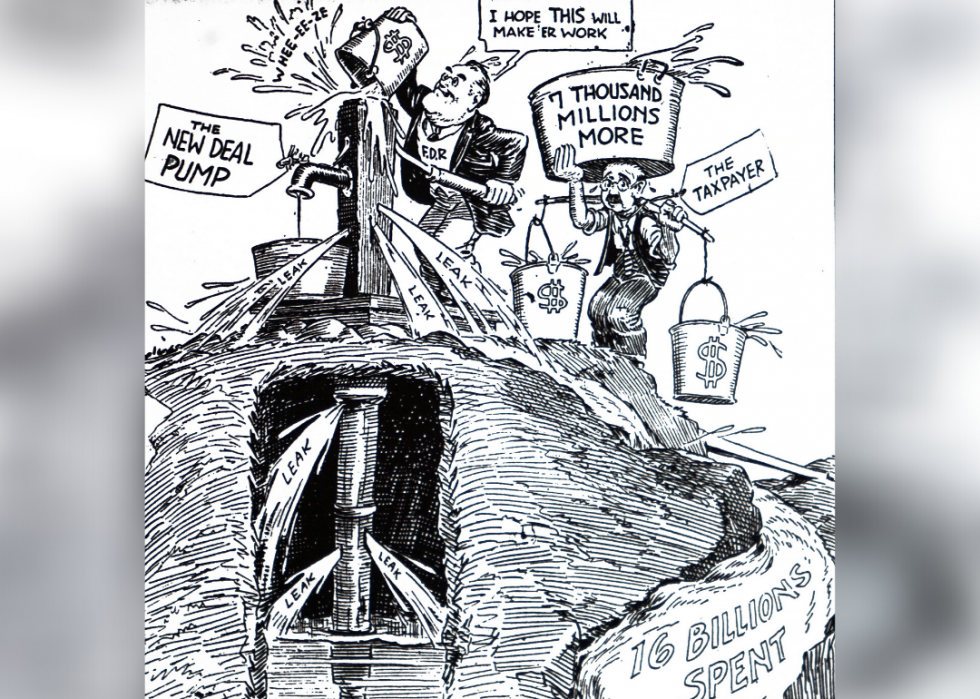
28 / 100
Evans/Universal History Archive/Universal Images Group // Getty Images
1930s: 'What We Need is Another Pump'
"What We Need is Another Pump" is another critique of FDR's "New Deal." The cartoon depicts FDR attempting to force money into a leaky economy.
[Pictured: "What we need is another pump" by Ray Evans for the Columbus Dispatch circa 1930s.]
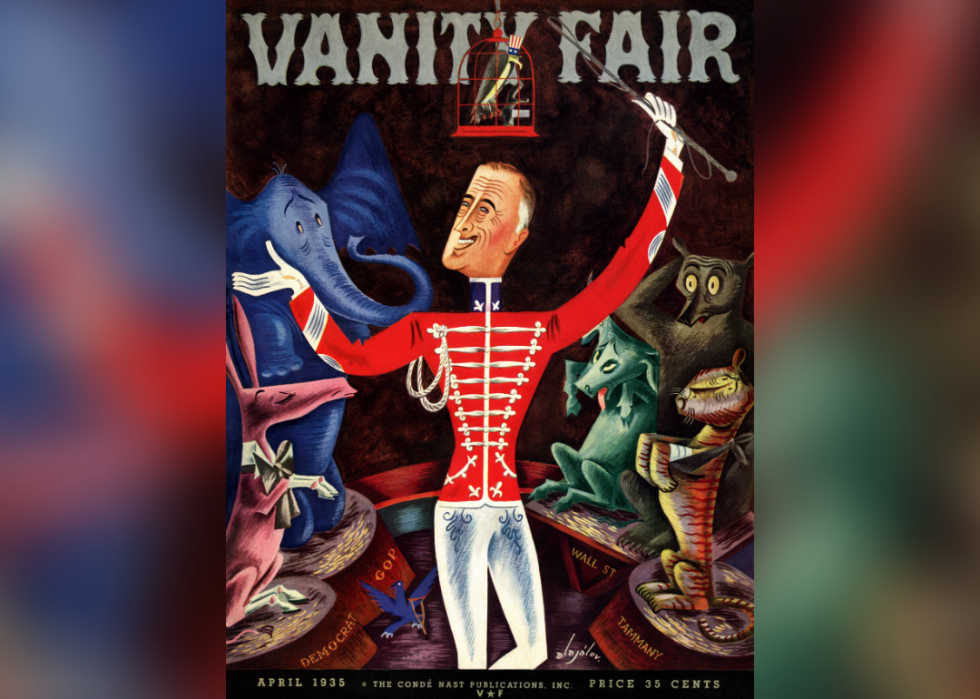
29 / 100
Constantin Alajalov/Condé Nast // Getty Images
1935: 'Roosevelt the Ringleader'
Constantin Alajalov drew President Roosevelt pulling the strings for circus animals. Each animal represents a different political faction following Roosevelt's lead.
[Pictured: "Roosevelt The Ringleader" by Constantin Alajalov for Vanity Fair dated April 1, 1935.]
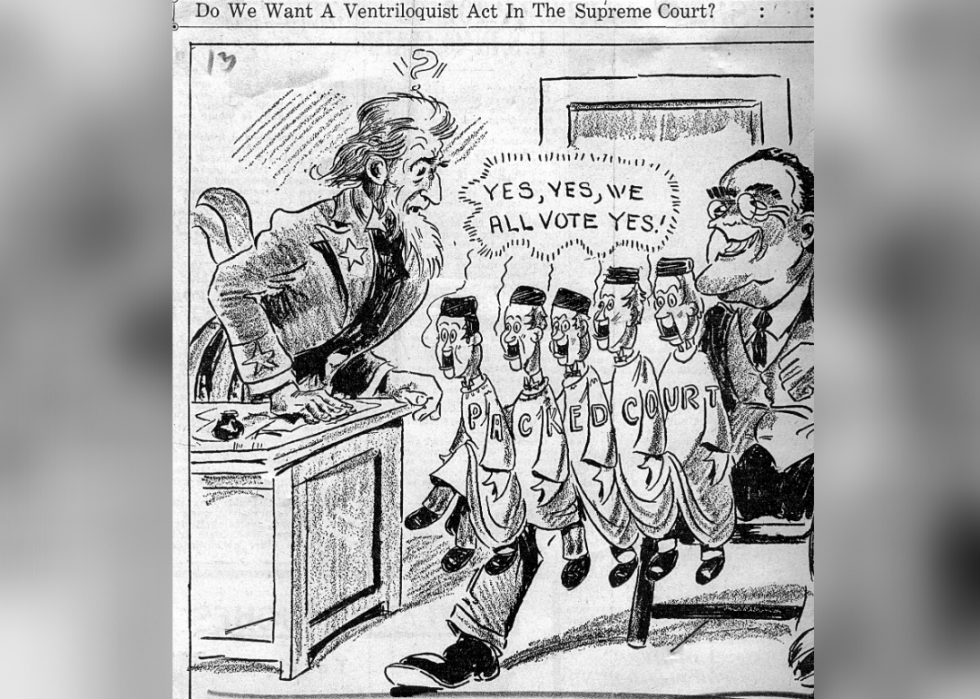
30 / 100
Fotosearch // Getty Images
1937: 'Do We Want a Ventriloquist Act in the Supreme Court?'
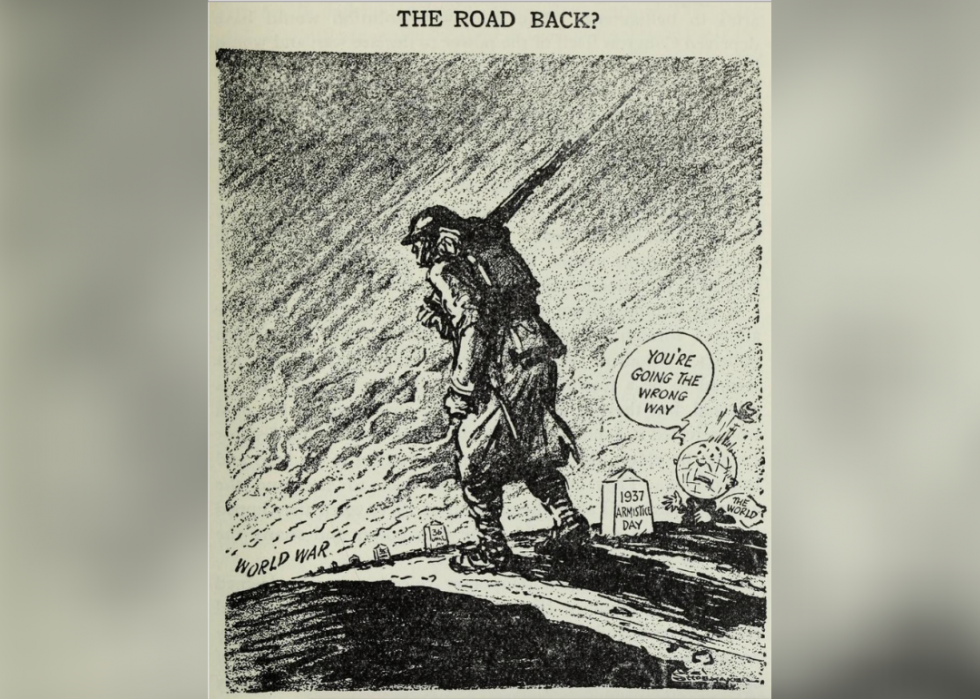
31 / 100
Vaughn Shoemaker/Chicago Daily News // Wikimedia Commons
1937: 'The Road Back?'
Another winner of the Pulitzer Prize, "The Road Back?" anticipated a second global-scale war, given a number of attacks by the Japanese. The cartoon shows the world talking a tired soldier out of conflict, while Armistice Day's tombstone lies in the background.
[Pictured: "The Road Back?" by Vaughn Shoemaker for Chicago Daily News dated Nov. 11, 1937.]
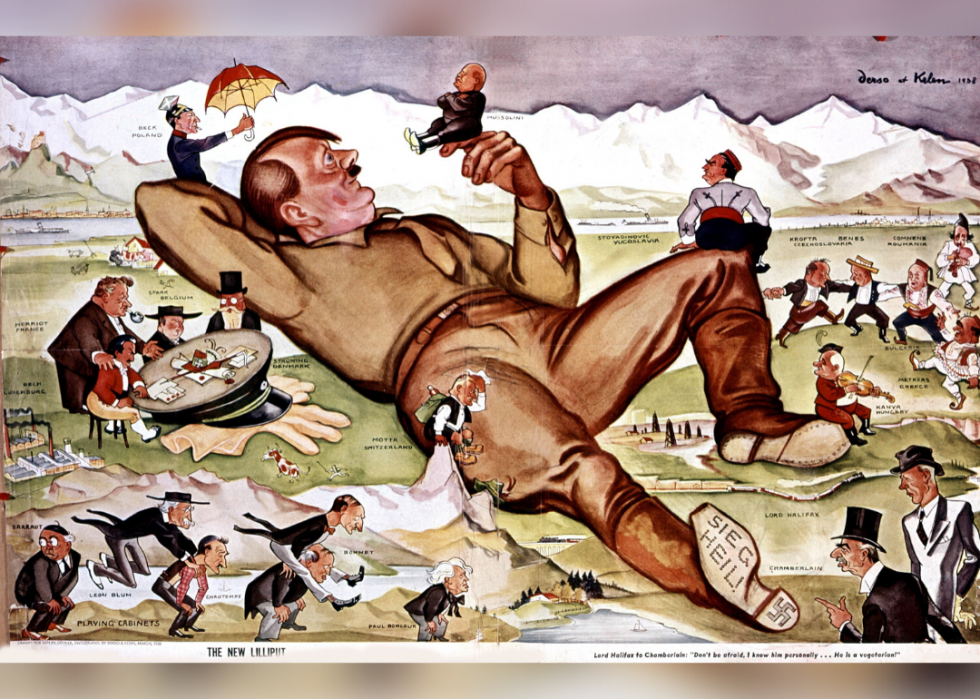
32 / 100
Derso et Kelen/Photo12/Universal Images Group // Getty Images
1938: 'The New Lilliput'
This cartoon shows a number of statesmen entertaining and comforting Adolf Hitler, who is reclining with a swastika on his shoe. The cartoon mocks the Munich Peace Agreement, which allowed Hitler to annex parts of Czechoslovakia.
[Pictured: "The New Lilliput" by Emery Kelen and Alois Derso for Ken Magazine dated June 1938.]
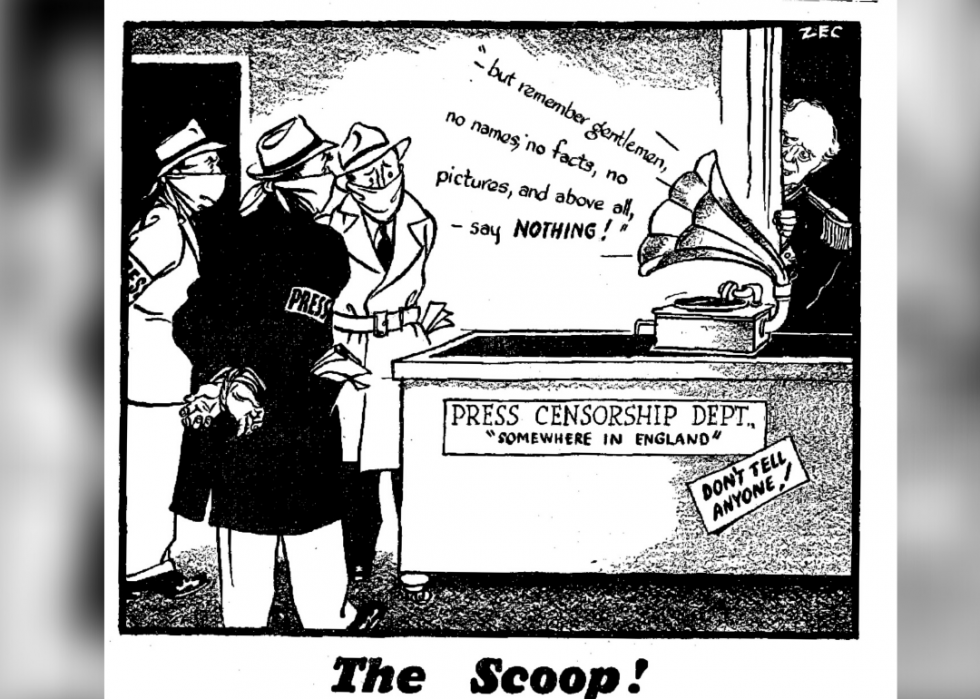
33 / 100
ZEC/Daily Mirror/Mirrorpix/Mirrorpix // Getty Images
1939: 'The Scoop!'
"The Scoop!" by Philip Zec depicts a group of bound and gagged journalists. The cartoon refers to the state of censorship during World War II.
[Pictured: "The Scoop!" by Philip Zec for The Daily Mirror dated Sept. 27, 1939.]
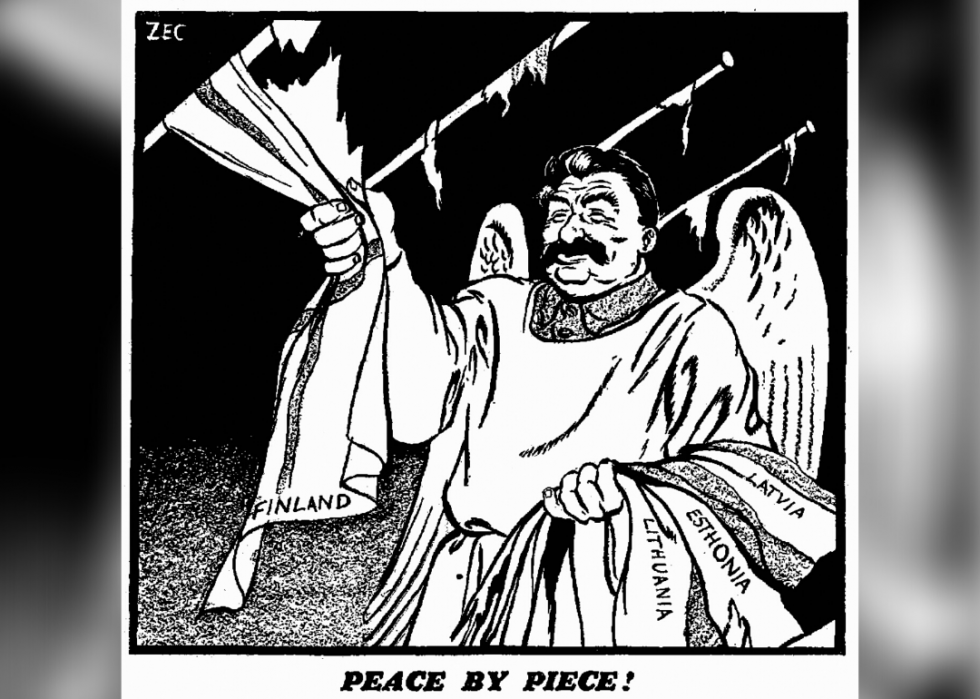
34 / 100
ZEC/Daily Mirror/Mirrorpix/Mirrorpix // Getty Images
1939: 'Peace by Piece!'
"Peace by Piece" depicts Soviet leader Joseph Stalin with angel wings. He can be seen tearing down the flags of neighboring states including Finland, Estonia, Latvia, and Lithuania one by one while smiling heartily. The cartoon was set in a time Soviet leaders promised peace with neighboring countries. This was called into question when leaders modified these objectives under the guise of stopping the spread of war, and their own military intentions became more apparent.
[Pictured: "Peace by Piece!" by Philip Zec for The Daily Mirror dated Dec. 1, 1939.]
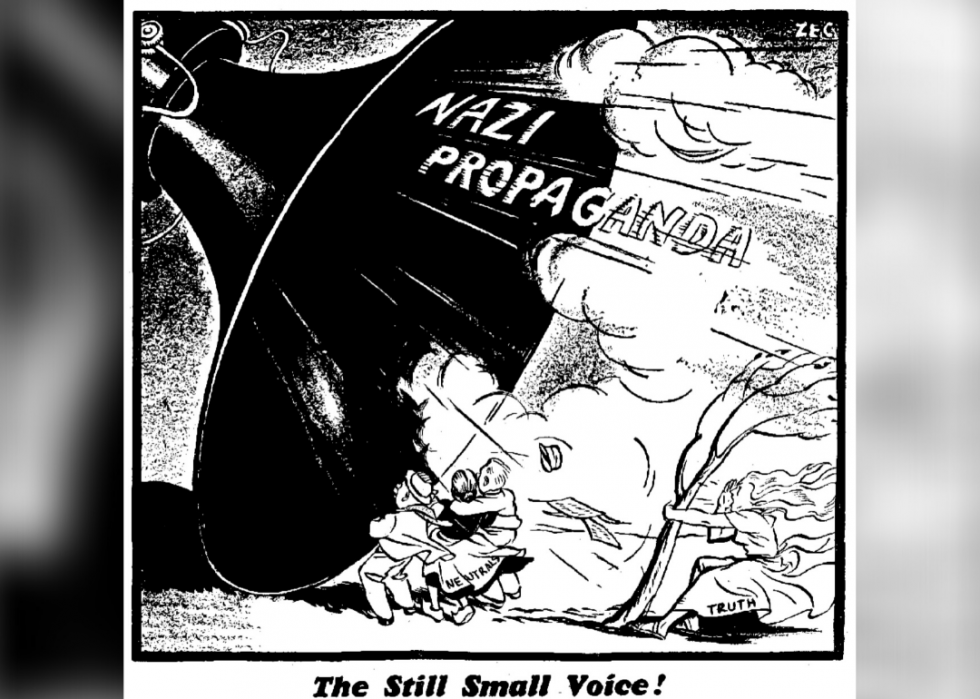
35 / 100
ZEC/Daily Mirror/Mirrorpix/Mirrorpix // Getty Images
1940: 'The Still Small Voice!'
"The Still Small Voice!" depicts a bullhorn with "Nazi propaganda" blaring from it. This reflected the general sentiment towards the party, published at a time when propaganda from Germany threatened to drive a wedge between Britain and France.
[Pictured: "The Still Small Voice! by Philip Zec for The Daily Mirror dated March 30, 1940.]
You may also like: Best-run cities in America
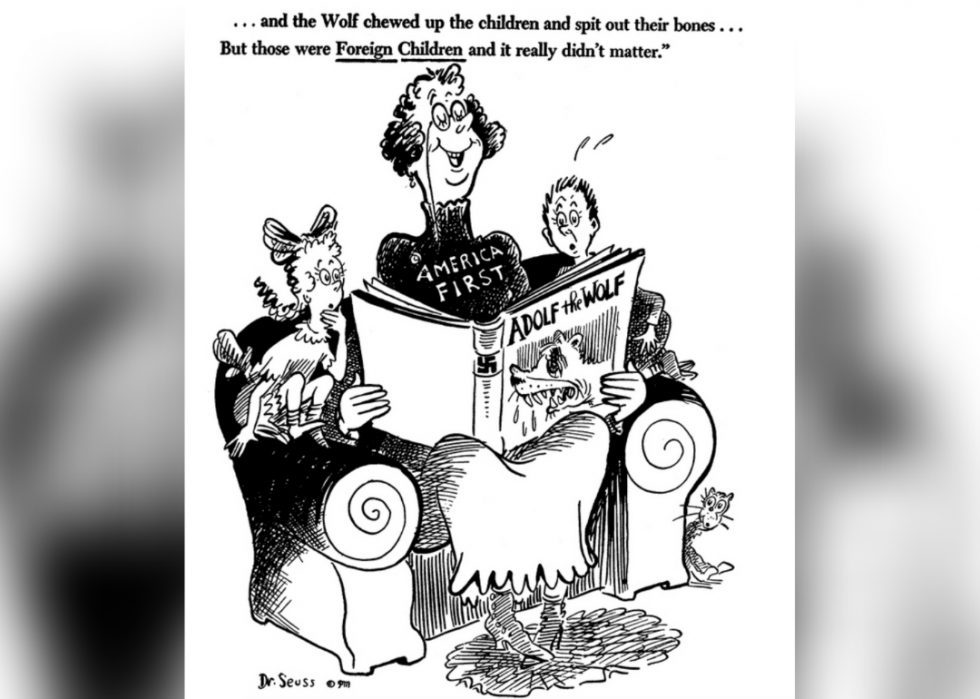
36 / 100
Dr. Seuss Political Cartoons/UC San Diego Library // Wikimedia Commons
1941: '...and the wolf…'
This cartoon shows an elderly woman in an "America First" sweater reading from "Adolf the Wolf," which bears a Nazi swastika. On her lap, two children sit listening as she reads the fate of two other children, showing the difference in opinion between the indoctrinated adult and the frightened young ones.
[Pictured: '... and the wolf…' by Dr. Seuss dated Oct. 1, 1941.]
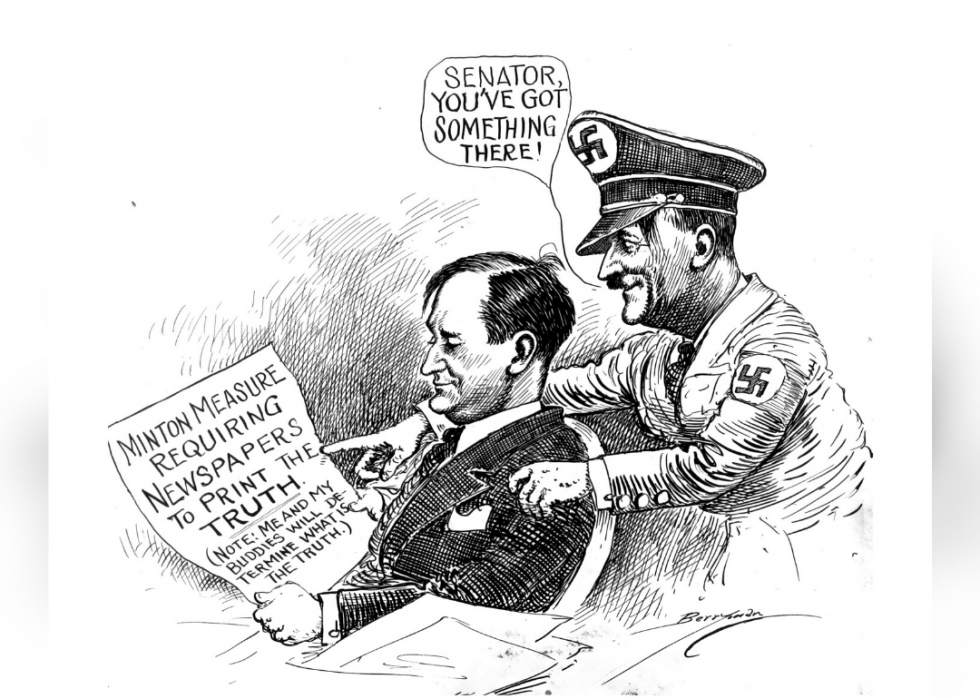
37 / 100
Berryman/Photo 12/Universal Images Group //Getty Images
1943: 'Adolf Hitler and Senator Sherman Minton'
Adolf Hitler is depicted in this cartoon showing U.S. Senator Sherman Minton the way news should be propagated. Hitler was known for tightly controlling his state-run media.
[Pictured: Cartoon by Clifford K. Berryman for the Washington Star dated 1943.]
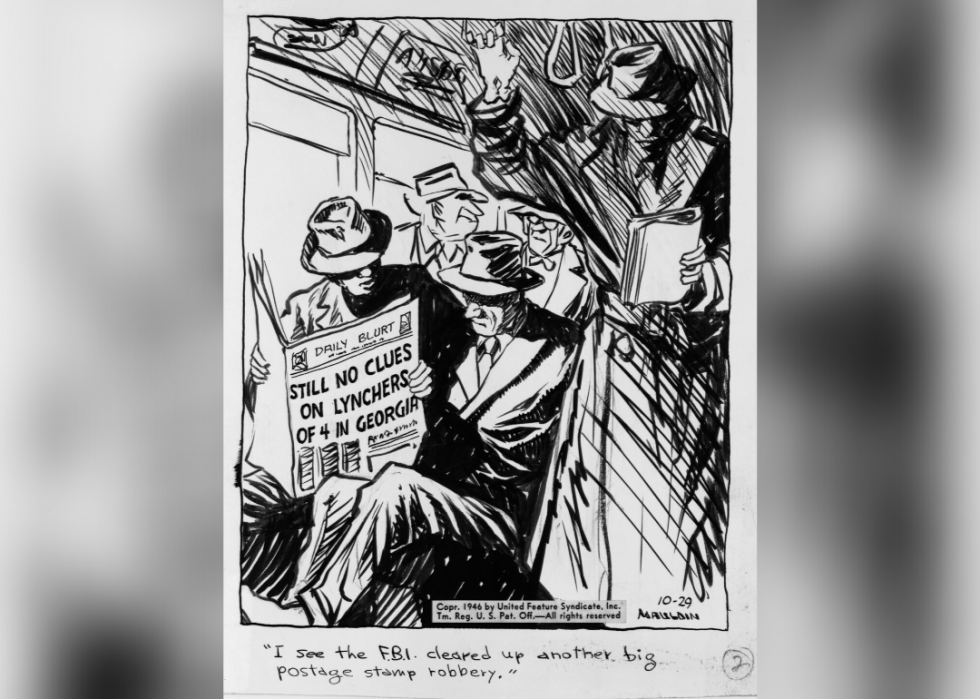
38 / 100
Bill Mauldin/Library of Congress/Corbis/VCG // Getty Images
1946: Commuters ignoring headlines
This cartoon shows two commuters with a newspaper whose headlines imply that a racist crime has gone unsolved. The man changes the subject, representing a criticism of the blindness to widespread racism.
[Pictured: "I see the F.B.I. cleared up another big postage stamp robbery" by Bill Mauldin for United Features Syndicate dated Oct. 29, 1946.]
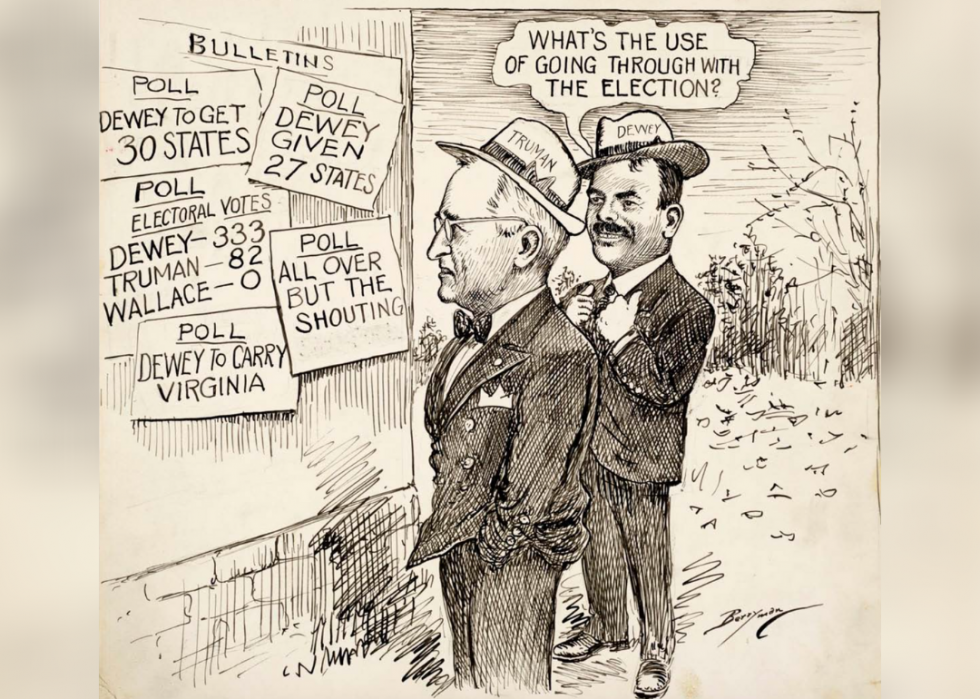
39 / 100
Clifford Kennedy Berryman // U.S. National Archives
1948: 'What's the Use of Going Through With This Election?'
This cartoon depicts former presidential candidate Thomas Dewey next to President Harry. The cartoon shows Dewey telling Truman "What's the use of going through with this election?" in a display of confidence.
[Pictured: "What's the use of going through with this election?" by Clifford Kennedy Berryman dated Oct. 19, 1948.]
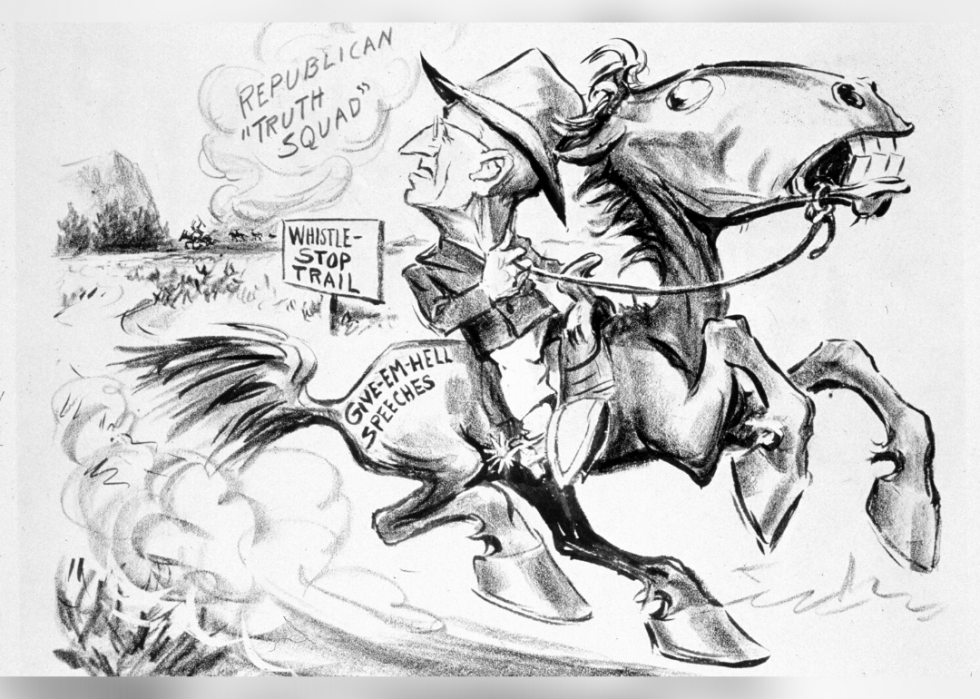
40 / 100
1948: 'Give 'em Hell Harry'
This cartoon satirizes Harry Truman's presidential campaign, during which he gave speeches across the country criticizing the opposition as the party of privilege. Truman was expected to lose the election but instead ended up winning by a margin of two million votes.
[Pictured: "Give 'em Hell Harry" by unidentified artist circa 1948.]
You may also like: 25 terms you should know to understand the gun control debate
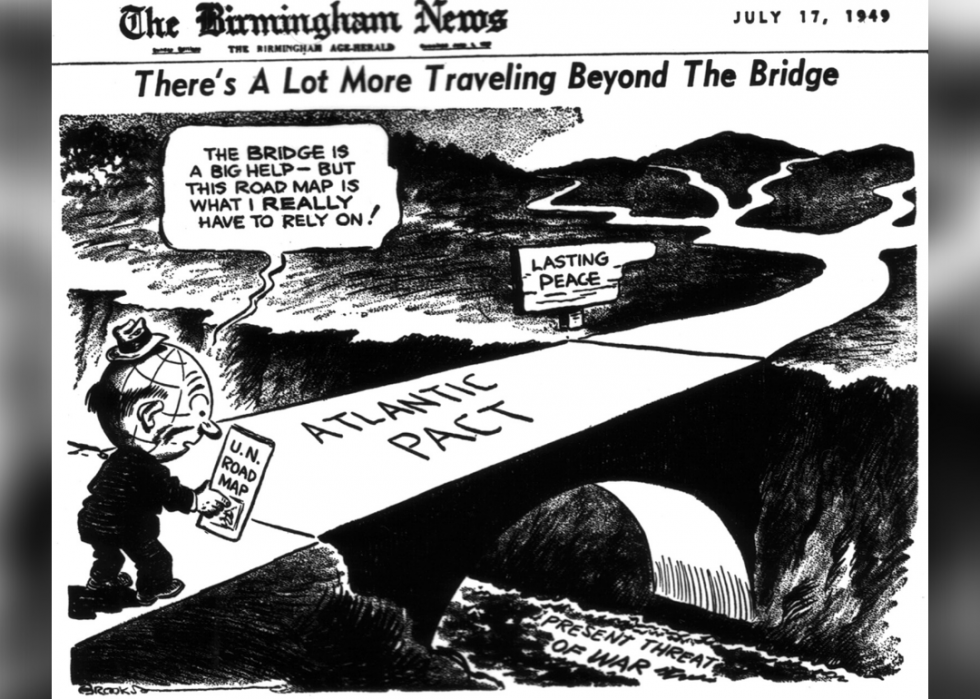
41 / 100
Photo12/Universal Images Group // Getty Images
1949: 'There's a Lot More Traveling Beyond the Bridge'
This cartoon depicts the world on a search for lasting peace, lamenting the ineffectiveness of the map. This cartoon satirizes the complex differences of opinion between global powers, despite their unity over the NATO treaty.
[Pictured: "There's a lot more traveling beyond the bridge" by Charles Brooks for The Birmingham News dated July 17, 1949.]
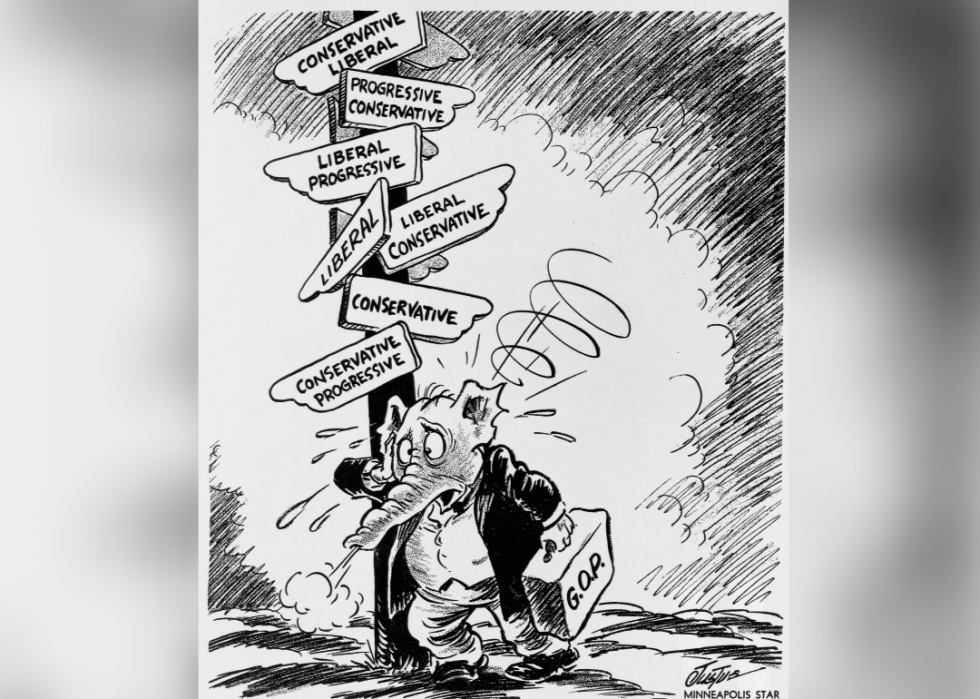
42 / 100
Justus/Library of Congress/Corbis/VCG // Getty Images
1950: 'The Confused Traveler'
Roy Justus' 1950 cartoon depicts an elephant (symbol of the Republican party) looking confused at a set of signposts pointing in different political directions. This is thought to represent confusion among the political party about its direction and stance on a range of issues at the time.
[Pictured: "The Confused Traveler" by Roy Justus for the Minneapolis Star dated 1950.]

43 / 100
Library of Congress/Corbis/VCG // Getty Images
1950: 'The Arms Race'
This cartoon depicts the arms race taking place between the U.S. and Russia in 1950. The sketch shows the world squashed between two bombs, one from either side. It illustrates how the world was caught in the grip of two major powers with military ambitions.
[Pictured: Cartoon by Art Wood dated circa 1950.]
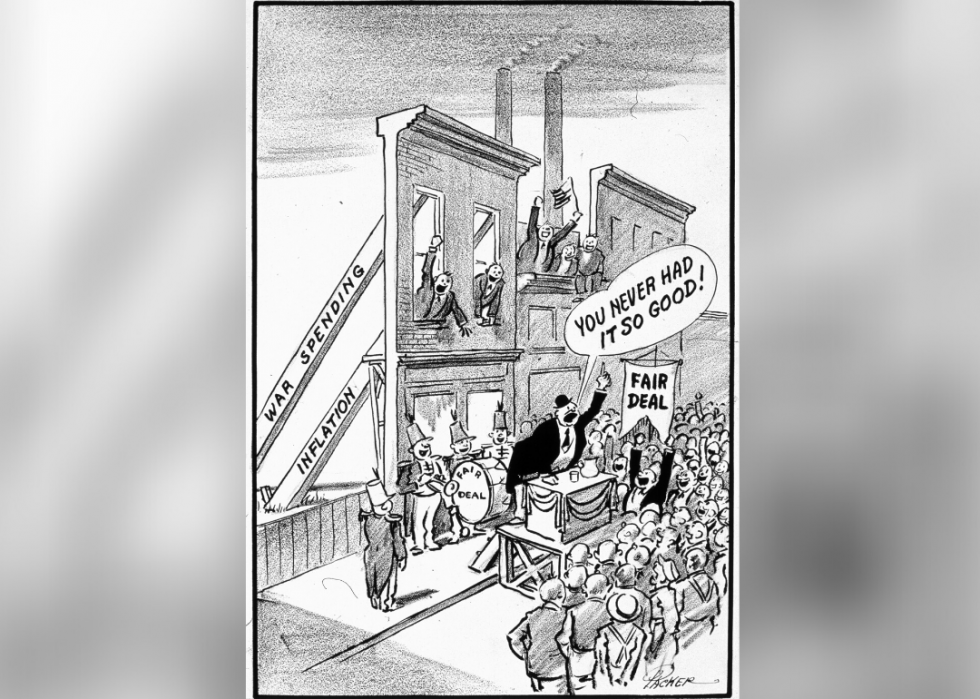
44 / 100
Packer/MPI // Getty Images
1952: 'Falsies!'
This sketch from Fred Packer takes aim at President Truman's Fair Deal program, which was widely criticized. This program was mirrored on President Roosevelt's New Deal.
[Pictured: "Falsies!" by Fred Packer for The New York Mirror dated Sept. 6, 1952.]
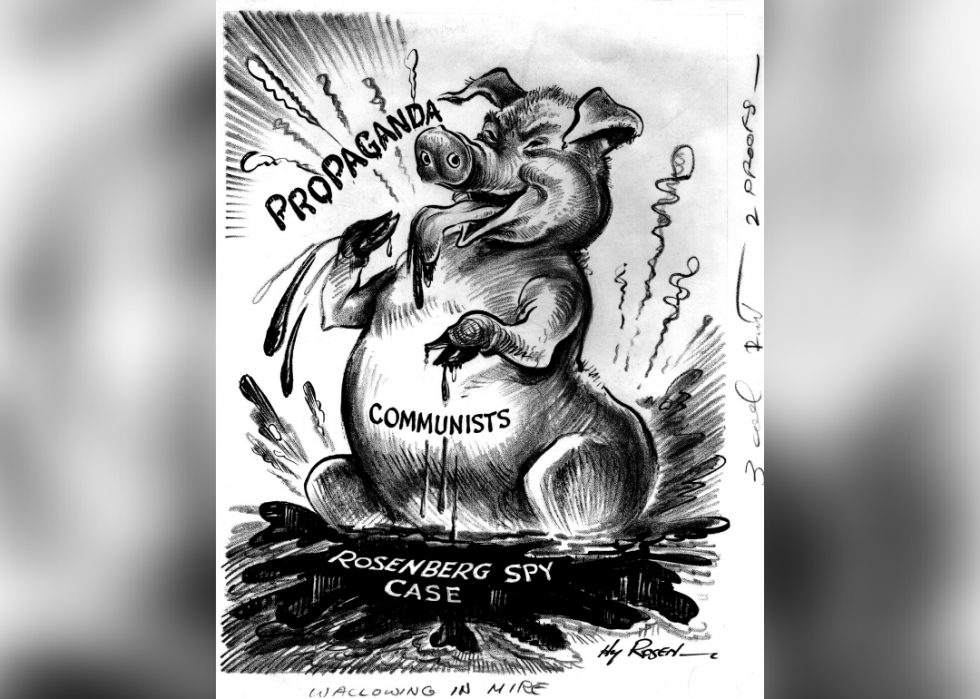
45 / 100
Rosen/Photo12/Universal Images Group // Getty Images
1952: 'Wallowing in Mire'
A pig is overjoyed in mud in this cartoon. The pig represents Communism and the mud symbolizes the Rosenberg spy case—anti-communist sentiment at a time when Julius and Ethel Rosenberg had been convicted of spying for the Soviet Union.
[Pictured: "Wallowing in Mire" by Hy Rosen dated 1952.]
You may also like: How America has changed since the first Census in 1790
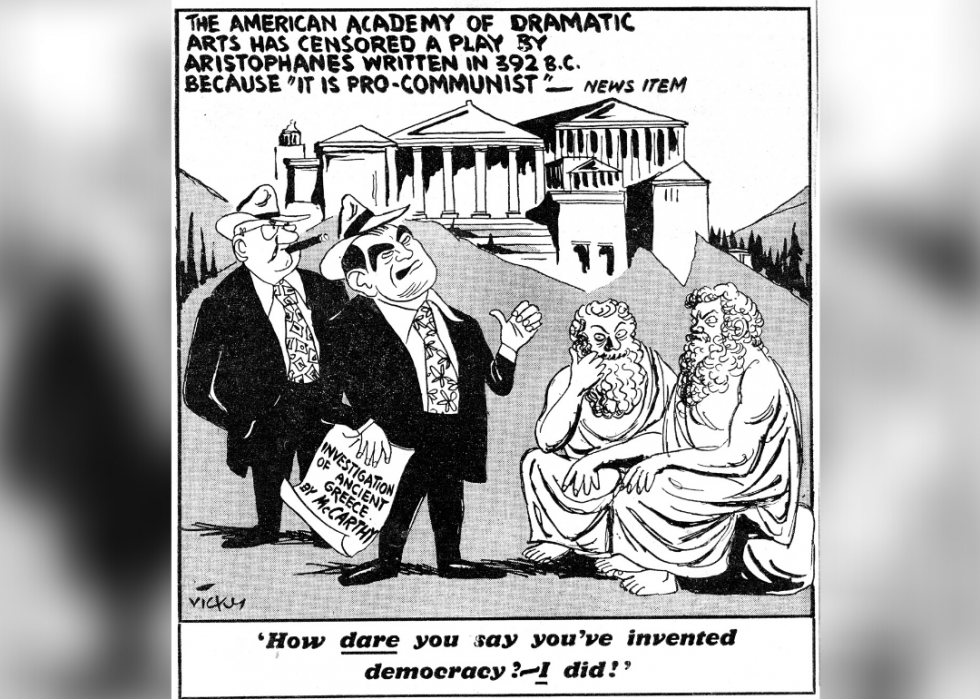
46 / 100
Victor Weisz/Daily Herald/Mirrorpix/Mirrorpix // Getty Images
1954: 'Vicky Cartoon'
Controversial U.S. Senator Joseph McCarthy attempts to censor two Greek philosophers for being pro-Communist in a sketch that pokes fun at the prevailing anti-Communist mood in the U.S.
[Pictured: Cartoon by Victor Weisz dated Feb. 5, 1954.]
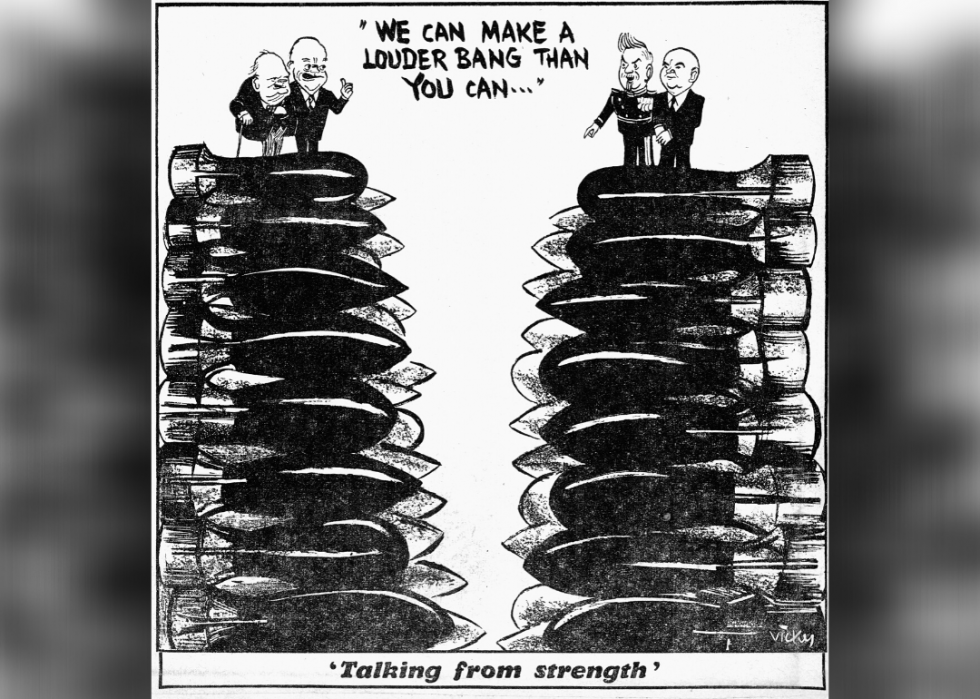
47 / 100
Victor Weisz/Daily Mirror/Mirrorpix/Mirrorpix // Getty Images
1954: 'Talking From Strength'
The western powers of Britain and the U.S. stand atop bombs in this cartoon. President Dwight Eisenhower and Prime Minister Winston Churchill look at the Soviet leadership, which stands atop an identical stack of explosives.
[Pictured: "Talking from Strength" by Victor Weisz for The Daily Herald dated Feb. 14, 1954.]
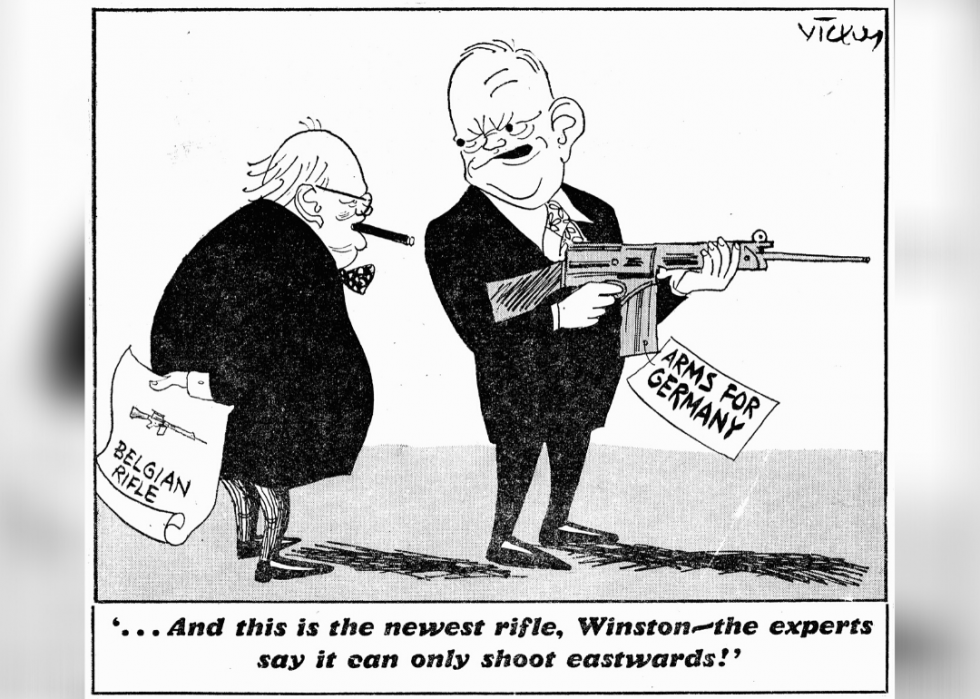
48 / 100
VICKY/Daily Mirror/Mirrorpix/Mirrorpix // Getty Images
1954: A new kind of rifle
U.S. President Dwight Eisenhower tries to convince a skeptical Winston Churchill to re-arm Germany. The trick? The rifles can only fire east.
[Pictured: Cartoon by Victor Weisz for the Daily Mirror dated Feb. 4, 1954.]
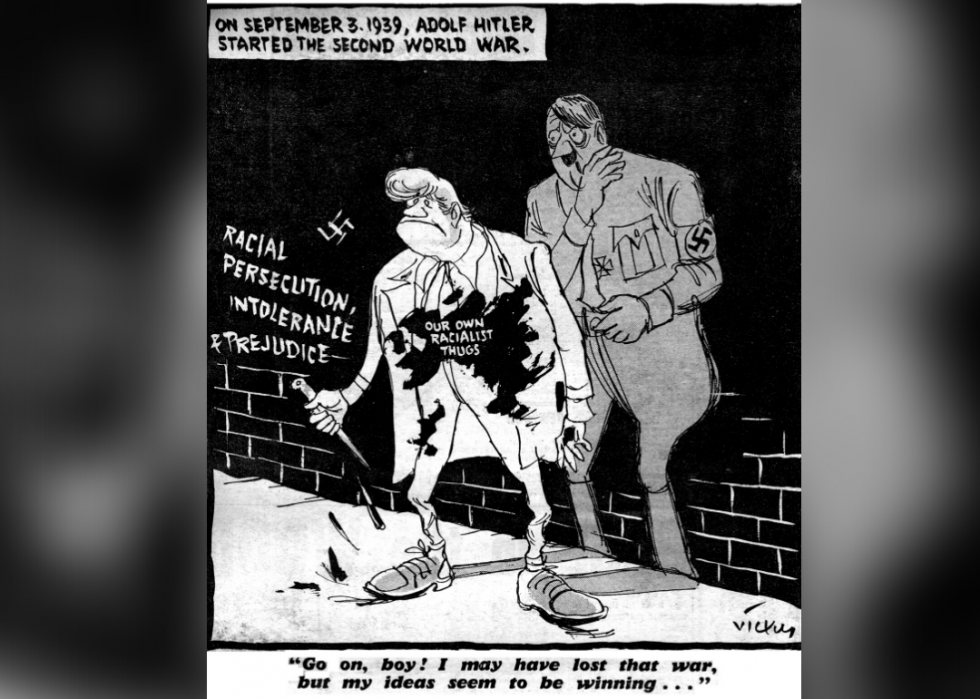
49 / 100
Victor Weisz/Daily Mirror/Mirrorpix/Mirrorpix via Getty Images
1958: 'Our Own Racialist Thugs'
Behind a man carrying a knife stands the spirit of Adolf Hitler, whispering into his ear encouragingly. This reflected the persistent racist violence around the country in the 1950s.
[Pictured: Cartoon by Victor Weisz for The Daily Mirror dated Sept. 2, 1958.]
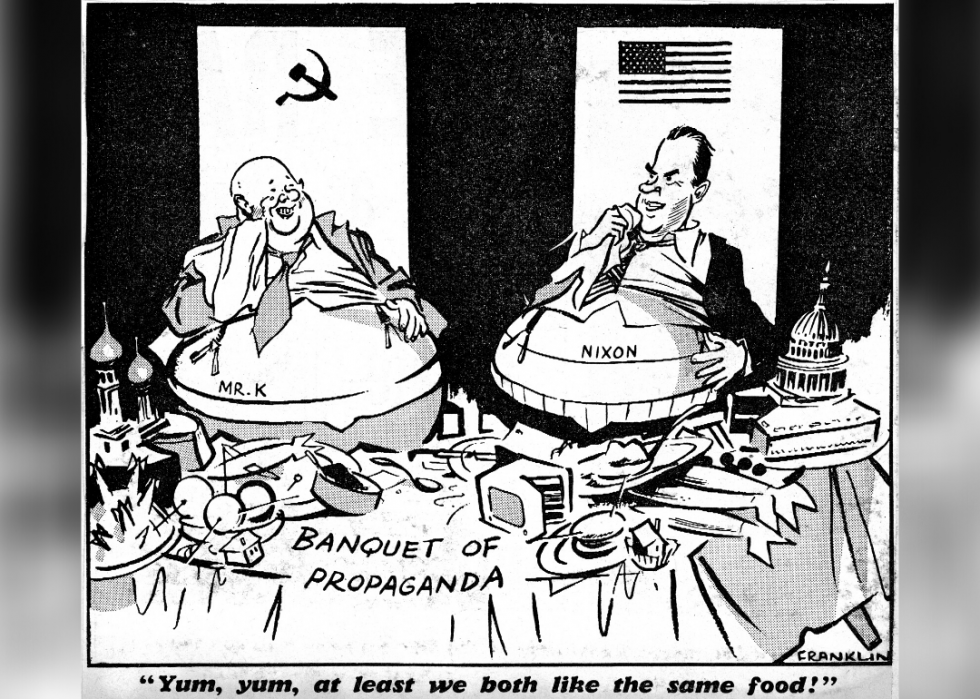
50 / 100
Franklin/Daily Mirror/Mirrorpix/Mirrorpix // Getty Images
1959: 'At least we both like the same food!'
Soviet leader Nikita Khrushchev and U.S. Vice President Richard Nixon sit next to each other at a banquet of propaganda in this cartoon. Stuffed with food, the leaders make a reference to their countries' mutual love for biased information.
[Pictured: Cartoon by Stanley Arthur Franklin for the Daily Mirror dated July 27, 1959.]
You may also like: How well do you remember 1969?
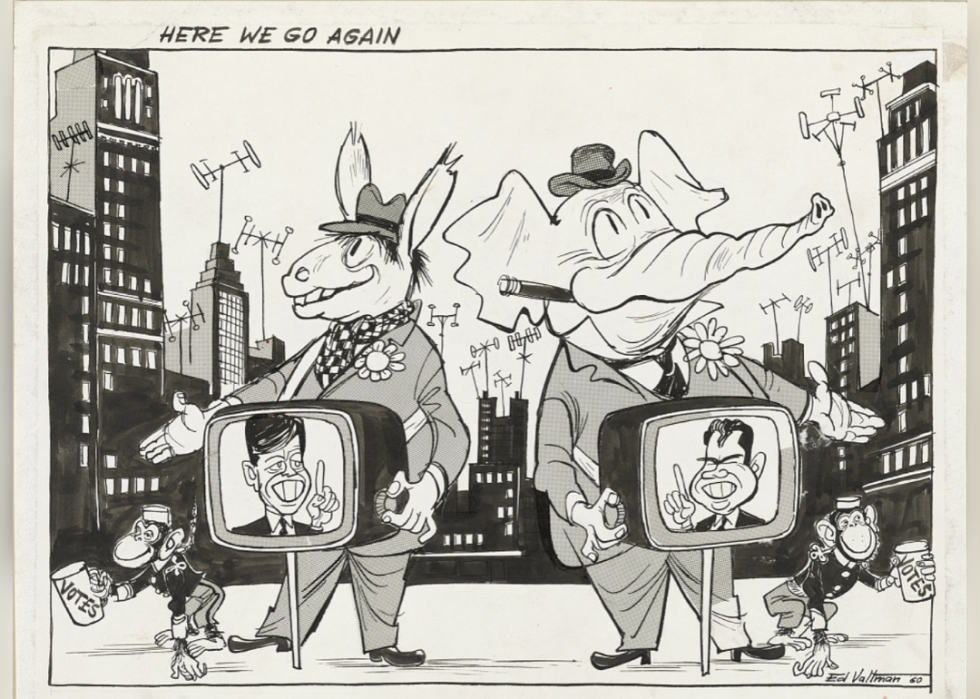
51 / 100
Edmund S. Valtman // Library of Congress
1960: 'Here We Go Again'
Two organ grinders on opposite sides send their monkeys to look for votes. On two TV sets are Democratic presidential nominee John F. Kennedy and Republican nominee Richard Nixon.
[Pictured: "Here we go again" by Edmund Valtman for the Hartford Times dated Sept. 12, 1960.]

52 / 100
Franklin/Daily Mirror/Mirrorpix/Mirrorpix // Getty Images
1961: 'Ready. . steady . .'
Soviet leader Nikita Khrushchev and President Kennedy stand beneath a race banner as missiles prepare to race off in front of them down a racetrack.
[Pictured: Cartoon by Stanley Arthur Franklin for the Daily Mirror dated Sept. 6, 1961.]
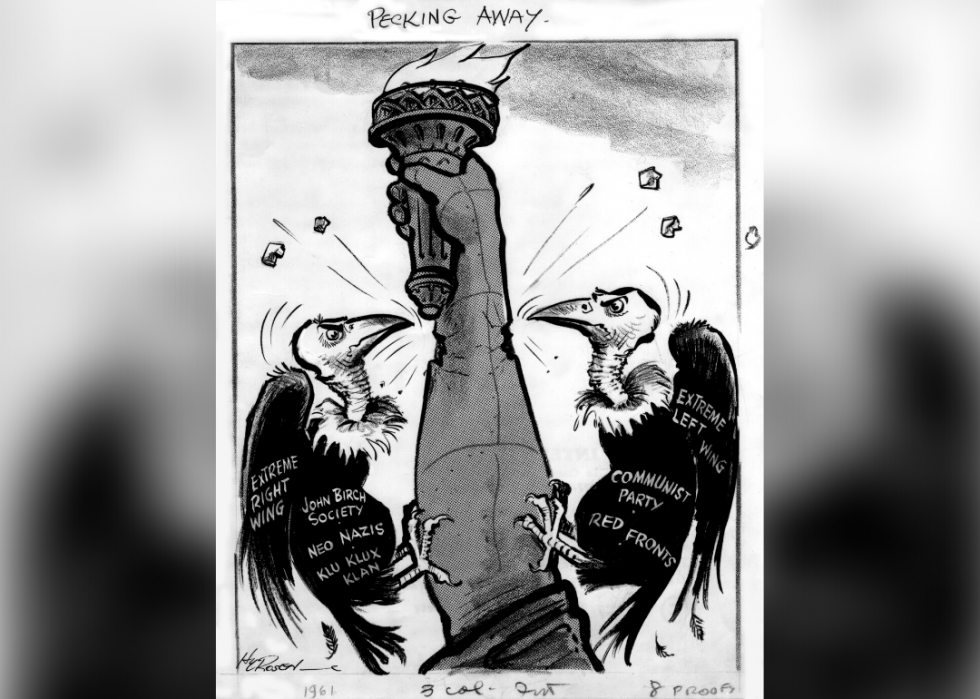
53 / 100
Rosen/Photo12/Universal Images Group // Getty Images
1961: 'Pecking Away'
The Statue of Liberty is pecked at by vultures in this cartoon. One bird signifies the far left, and the other the far right. The artist blames both for their negative effects on society.
[Pictured: "Pecking Away" by Hy Rosen dated 1961.]
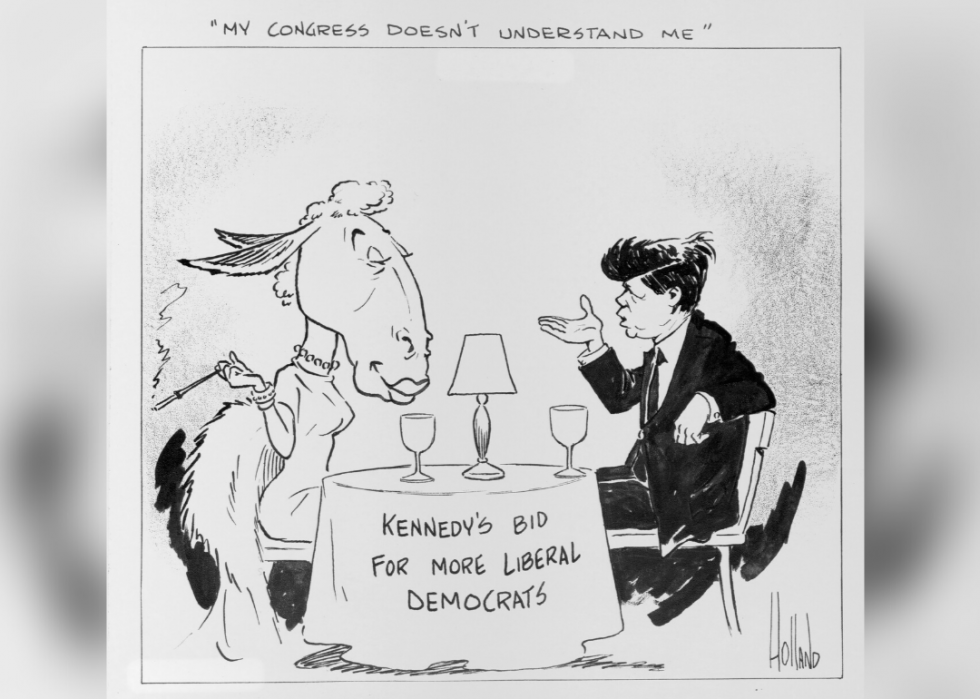
54 / 100
Holland/Library of Congress/Corbis/VCG // Getty Images
1962: 'My Congress Doesn't Understand Me'
John F. Kennedy sits across from a dressed-up donkey on a table that reads "Kennedy's Bid for More Liberal Democrats."
[Pictured: "My Congress Doesn't Understand Me" by Ed Holland dated 1962.]
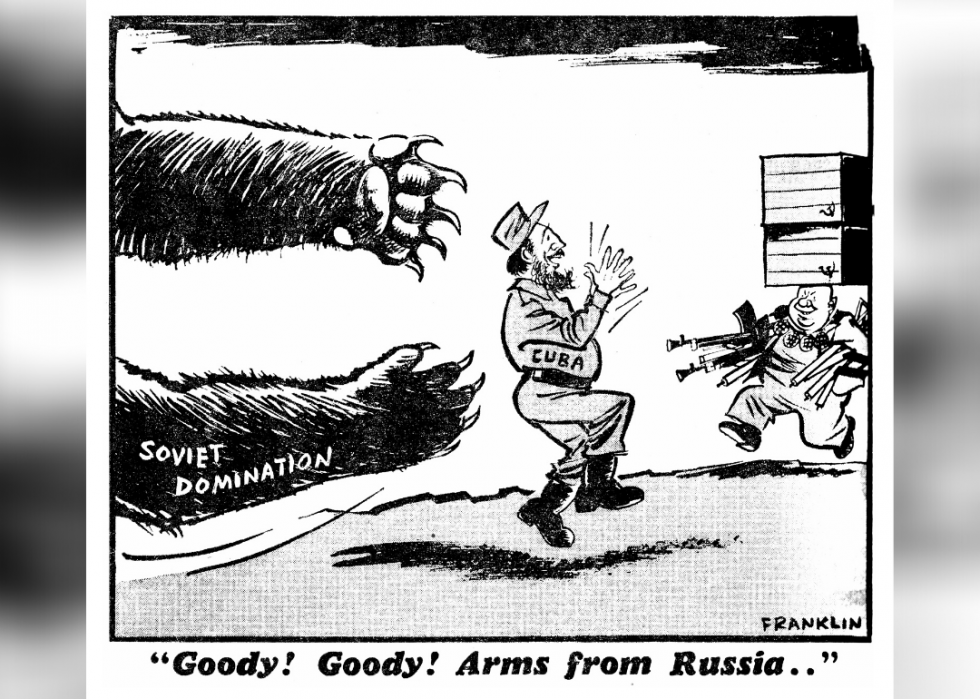
55 / 100
Franklin/Daily Mirror/Mirrorpix/Mirrorpix // Getty Images
1962: 'Goody! Goody! Arms From Russia'
The Cuban leadership dances for joy after receiving weapons from Russia in this cartoon from 1962. A bear representing Soviet dominance stands nearby, ready to swipe. This satirizes Communist influence during this period.
[Pictured: Cartoon by Stanley Arthur Franklin for The Daily Mirror dated Sept. 4, 1962.]
You may also like: A timeline of WWII, the most devastating conflict in history
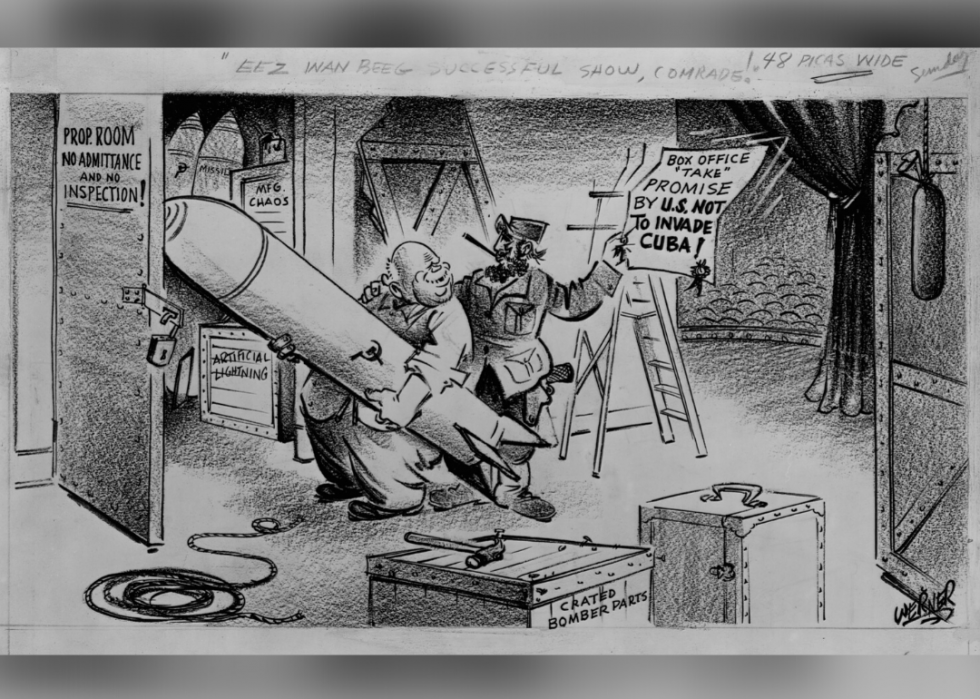
56 / 100
Werner/Library of Congress/Corbis/VCG // Getty Images
1962: 'Cuban Missile Crisis'
The theatrics of the missile crisis are depicted in this cartoon. Castro is seen holding a movie-style poster that declares the U.S. will not attack Cuba. His comrade hides a Soviet missile in a prop room.
[Pictured: Cartoon by Charles Werner dated Nov. 26, 1962. ]
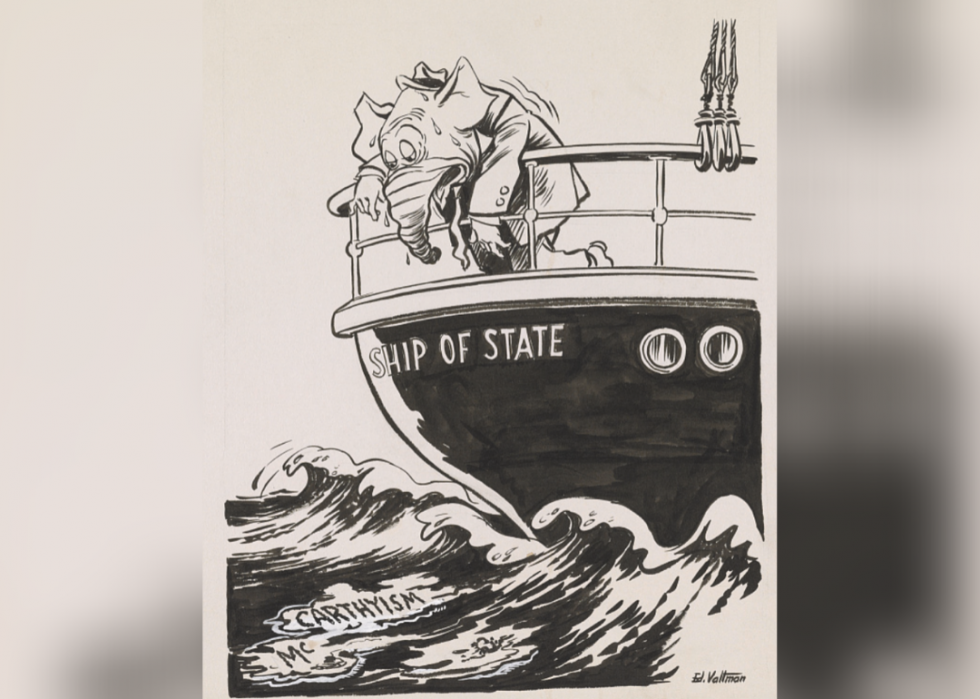
57 / 100
Edmund S. Valtman // Library of Congress
1967: 'Getting It Out of His System'
This drawing shows a Republican elephant looking over the edge of "The Ship of State" sailing on a less-than-pleasant ocean of McCarthyism. The GOP had moved past McCarthyism, and had therefore gotten this era "out of its system."
[Pictured: "Getting It Out of His System" by Edmund Valtman dated 1967.]
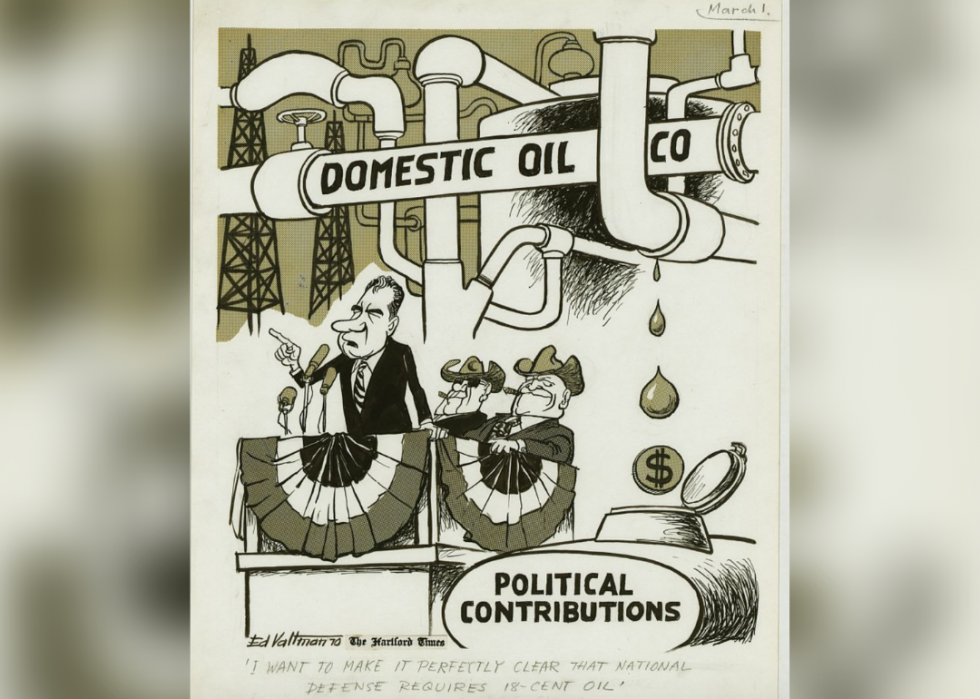
58 / 100
Edmund S. Valtman // Library of Congress
1970: 'National Defense'
Two men in cowboy hats stand next to President Nixon as he gives a speech above an array of "domestic" oil pipes. This sketch satirizes the relationship between Nixon and oil companies.
[Pictured: Cartoon by Edmund Valtman for the Hartford Times dated March 1, 1970.]
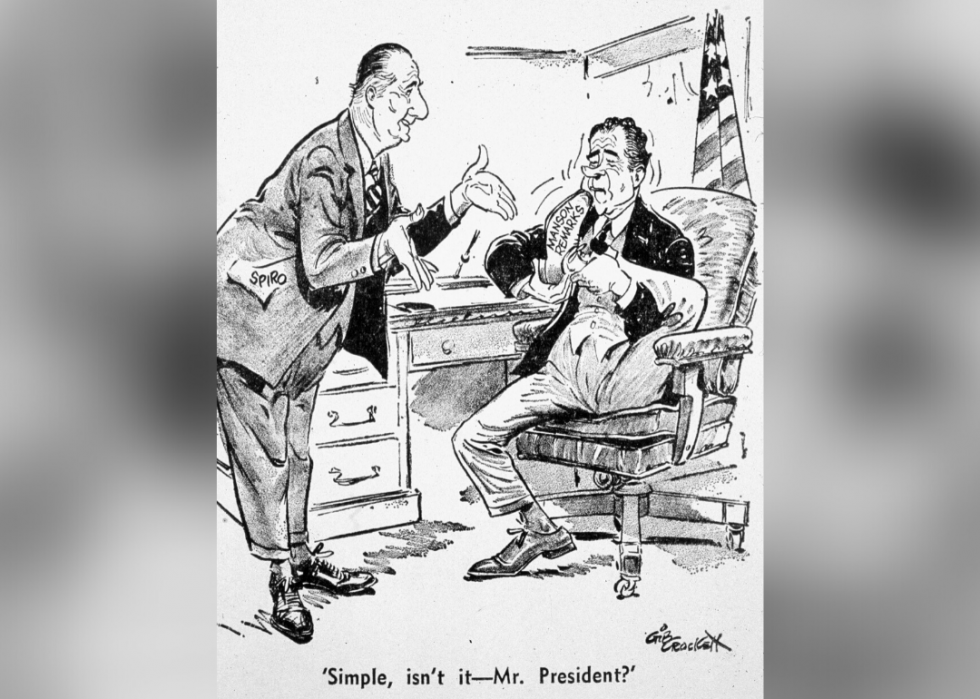
59 / 100
Gib Crockett/MPI // Getty Images
1970: 'Simple, isn't it—Mr. President?'
In this cartoon, Vice President Spiro Agnew is showing President Nixon how to put his foot in his mouth. The piece pokes fun at Nixon for weighing in on the Charles Manson trial prior to its conclusion. Nixon withdrew his remarks, but attorneys for Manson and his co-defendants Leslie Van Houten and Susan Atkins moved for a mistrial, which was denied. Trump drew a parallel to Nixon's remarks when he weighed in on Paul Manafort's 2018 trial .
[Pictured: Cartoon by Gib Crockett for the Evening Star dated Aug. 5, 1970.]
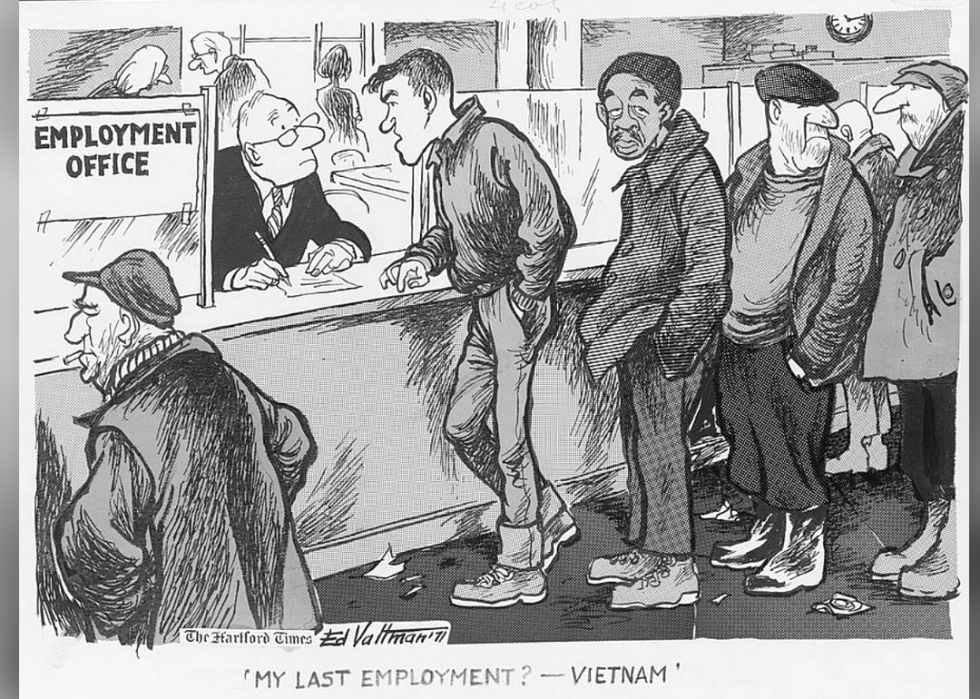
60 / 100
Edmund S. Valtman // Library of Congress
1971: 'My last employment?—Vietnam'
This sketch shows a Vietnam veteran queueing up for unemployment benefits upon returning to America. It highlighted the lack of opportunities for those returning home after war.
[Pictured: Cartoon by Edmund Valtman for The Hartford Times dated March 10, 1971.]
You may also like: Youngest and oldest presidents in U.S. history
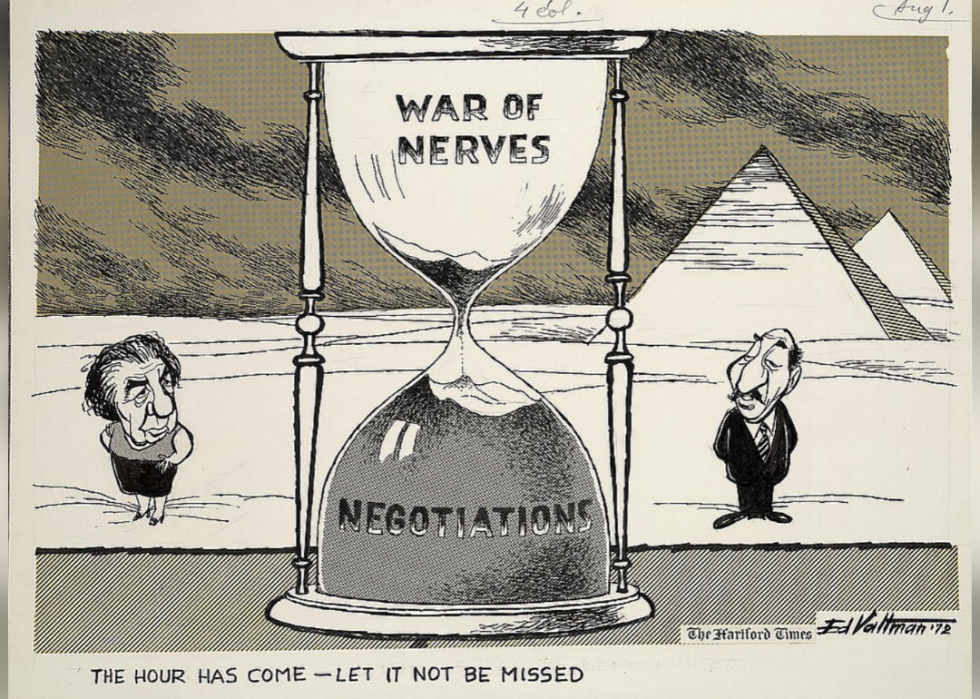
61 / 100
Edmund S. Valtman // Library of Congress
1972: 'The hour has come'
Egyptian president Anwar Sadat stands opposite Israeli Prime Minister Golda Meir with a hourglass between them. This pointed to the tension between the two countries, leading to the Camp David Accords in 1978.
[Pictured: Cartoon by Edmund Valtman for the Hartford Times dated Aug. 1,1972.]
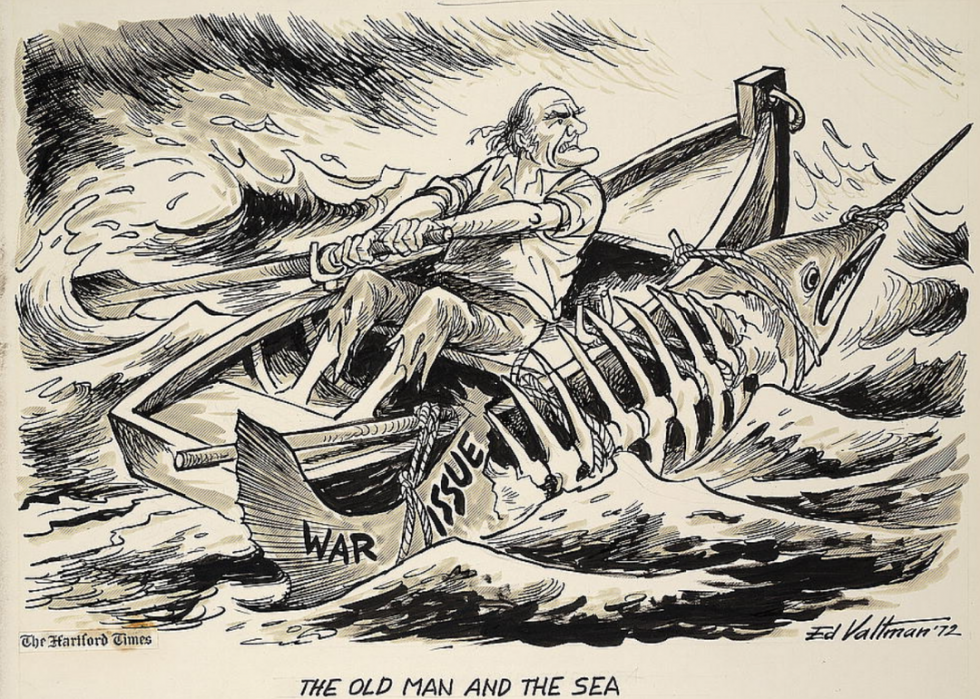
62 / 100
Edmund S. Valtman // Library of Congress
1972: 'The Old Man and the Sea'
Sen. George McGovern is depicted as a fisherman alongside the remains of a fish labeled "War Issue" as they battle against rocky seas. McGovern hoped to make his opposition to the Vietnam War part of his 1972 presidential campaign and eventually lost to Richard Nixon.
[Pictured: Cartoon by Edmund Valtman for the Hartford Times dated Oct. 31, 1972.]
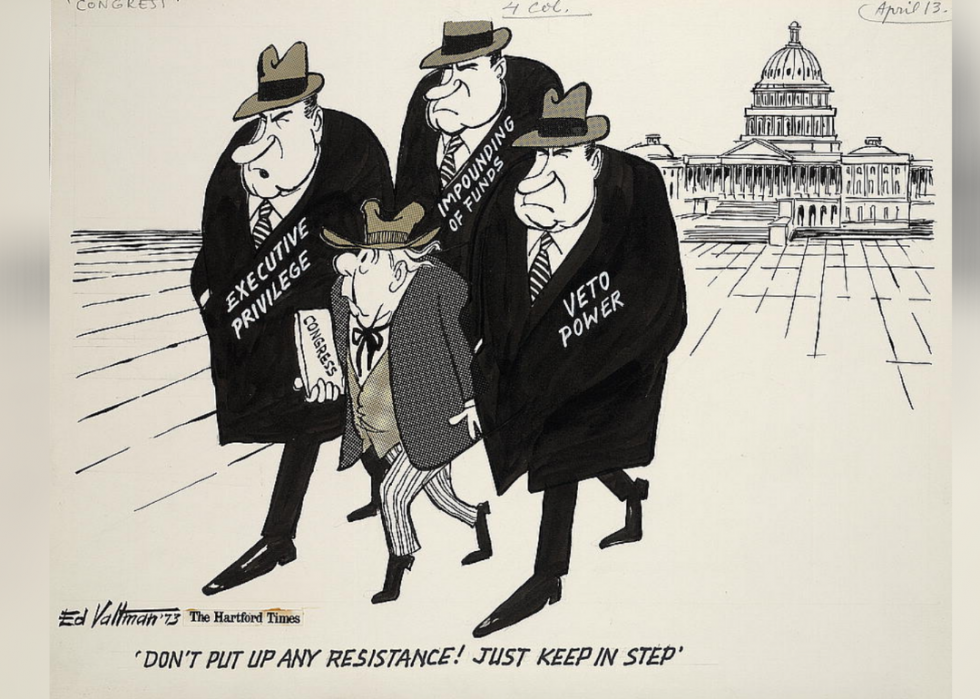
63 / 100
Edmund S. Valtman // Library of Congress
1973: 'Don't put up any Resistance! Just keep in step'
"Congress" is removed by three Richard Nixon lookalikes labeled "Executive Privilege," "Impounding of Funds," and "Veto Power." The cartoon is intended to satirize Nixon's "New American Revolution," which aimed to defeat the opposition following his re-election in 1972.
[Pictured: Cartoon by Edmund Valtman for the Hartford Times dated April 13, 1973.]
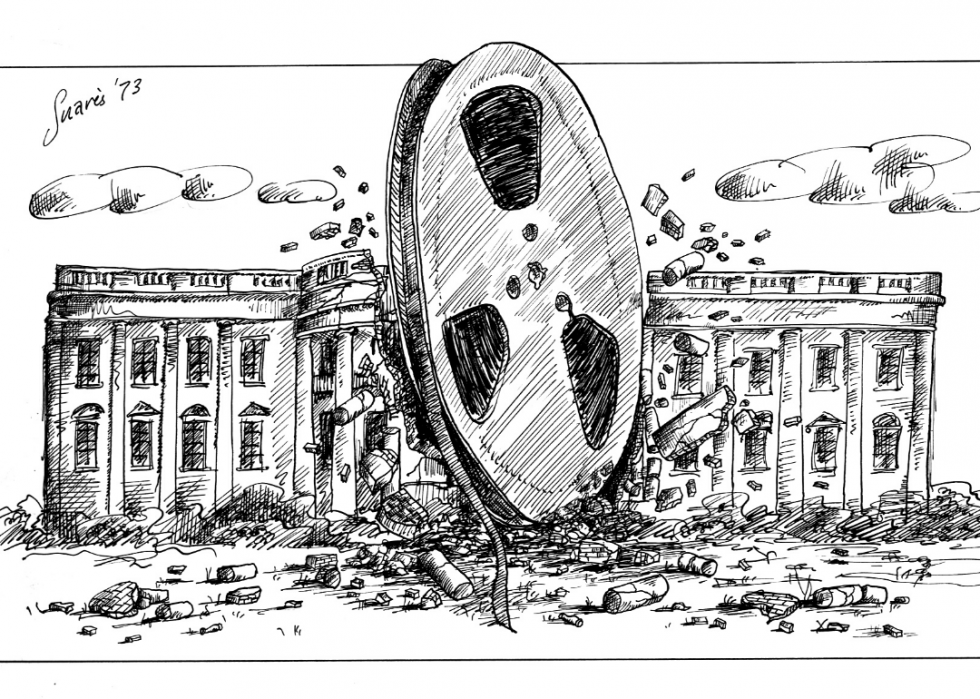
64 / 100
Jean-Claude Suares/Library of Congress/Corbis/VCG // Getty Images
1973: Watergate
A recording reel smashes through the White House at the height of the Watergate scandal in this cartoon, signifying how the Oval Office was affected by the controversy, eventually leading to Nixon's impeachment.
[Pictured: Cartoon by Jean-Claude Suares dated 1973.]
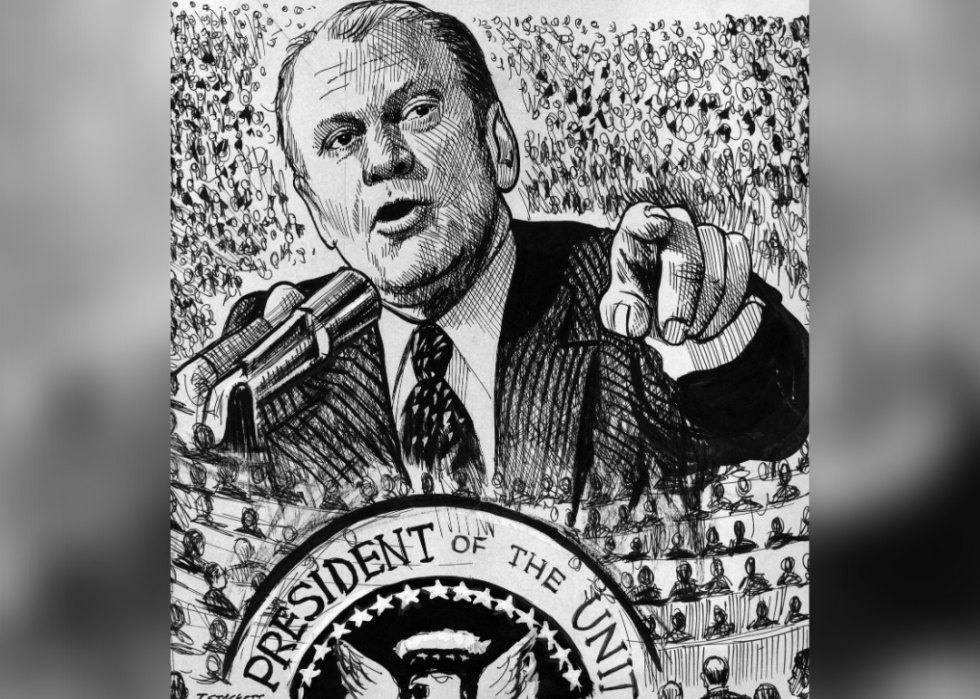
65 / 100
T. Stockett/Afro American Newspapers/Gado // Getty Images
1975: Gerald Ford faces the crowds
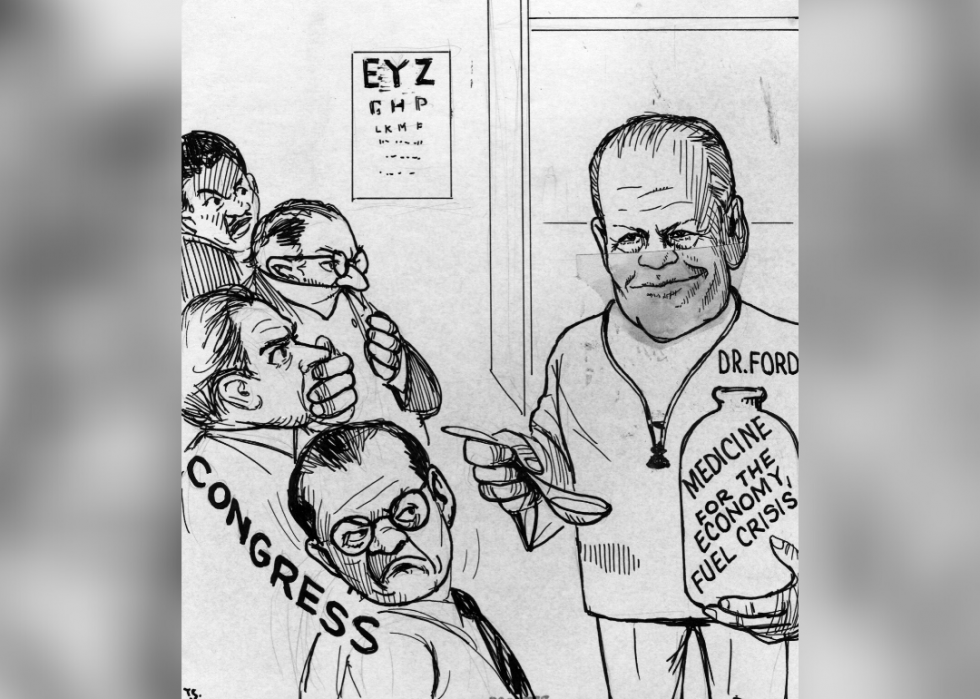
66 / 100
T. Stockett/Afro American Newspapers/Gado // Getty Images
1975: Gerald Ford feeds Congress a bitter remedy
Another Gerald Ford caricature shows the president trying to spoon-feed a number of unhappy congressmen. Ford's bitter medicine was to call on households to "spare a penny," and after lifting the embargo on OPEC oil, energy prices ultimately rose.
[Pictured: Cartoon by Thomas Stockett dated 1975.]
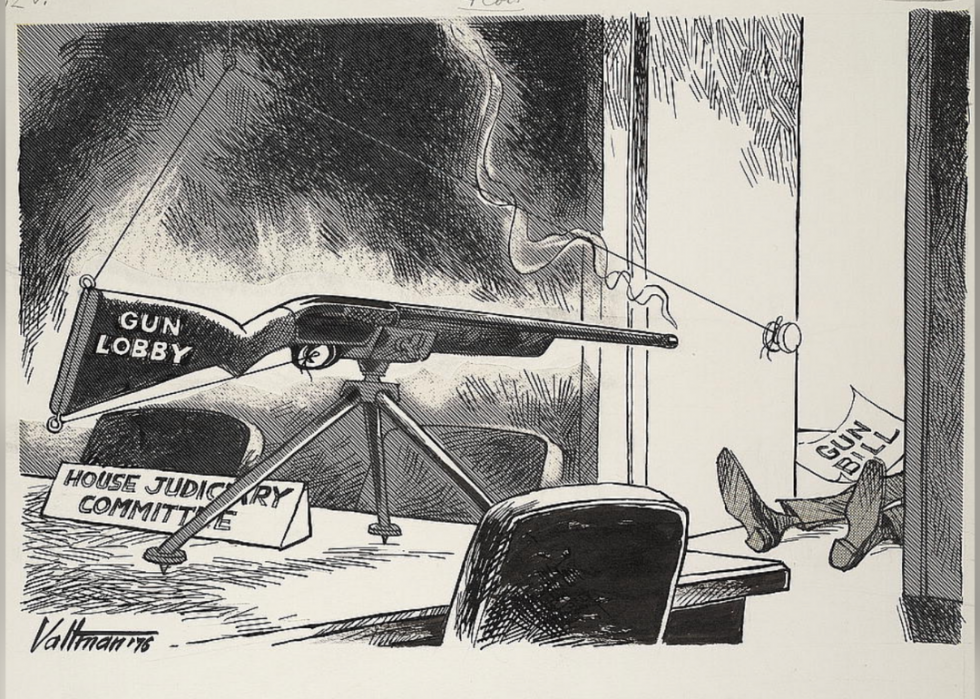
67 / 100
Edmund S. Valtman // Library of Congress
1976: Gun Lobby takes aim at the gun bill
This cartoon by Edmund Valtman illustrates how the gun lobby suppresses a bill that would have banned concealed arms. It shows a rifle on the House Judiciary Committee's desk, in a clear challenge to the weapons industry.
[Pictured: Cartoon by Edmund Valtman dated March 11, 1976.]
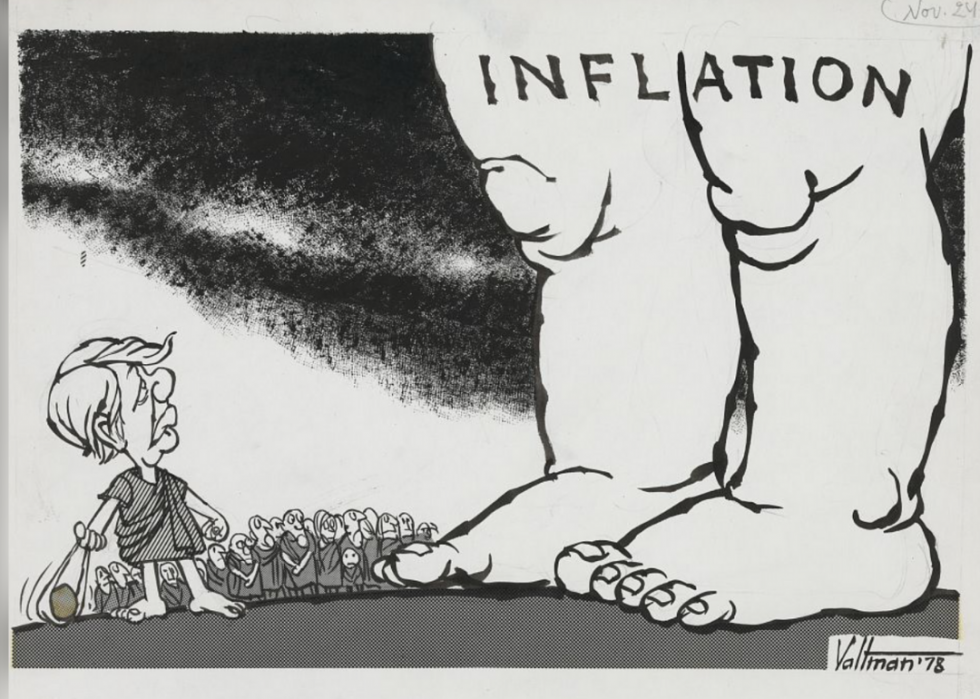
68 / 100
Edmund S. Valtman // Library of Congress
1978: 'Inflation'
Edmund Valtman uses biblical figures in this cartoon, drawing of President Jimmy Carter as David and inflation as Goliath. As president, Carter faced an intense period of "stagflation," or stunted economic growth and very high inflation.
[Pictured: Cartoon by Edmund Valtman dated 1978.]
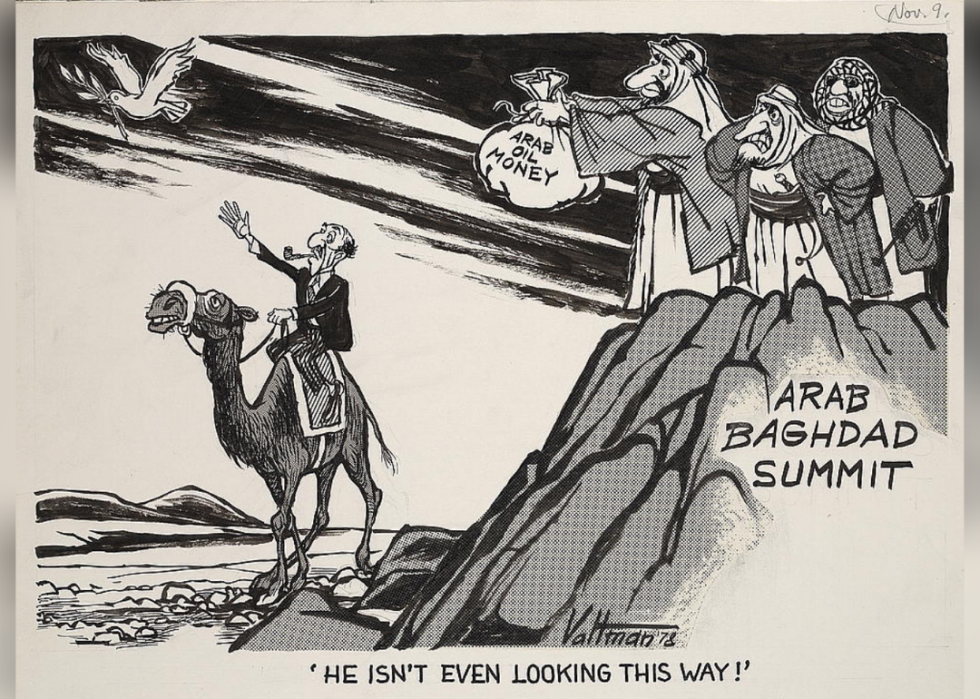
69 / 100
Edmund S. Valtman // Library of Congress
1978: 'He isn't even looking this way!'
Valtman depicted Egyptian President Anwar Sadat atop a camel heading towards a dove with an olive branch in its beak, ignoring Arab oil money being offered to him. Sadat chose to sign a peace treaty with Israeli Prime Minister Menachem Begin instead.
[Pictured: Cartoon by Edmund Valtman dated Nov. 9, 1978.]
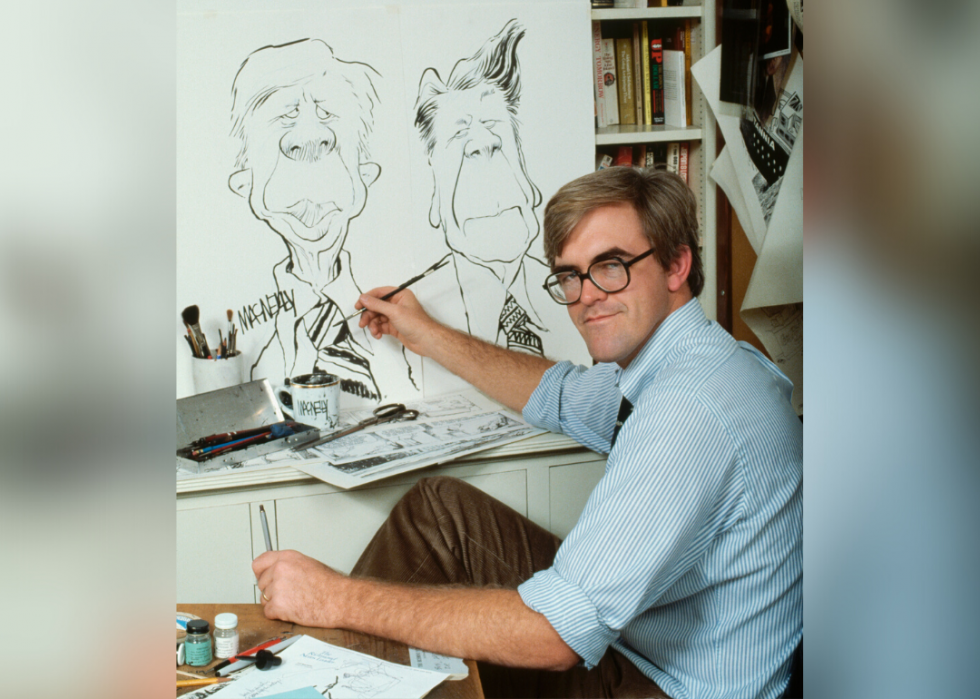
70 / 100
Wally McNamee/CORBIS/Corbis // Getty Images
1980: Political cartoonist Jeff McNelly
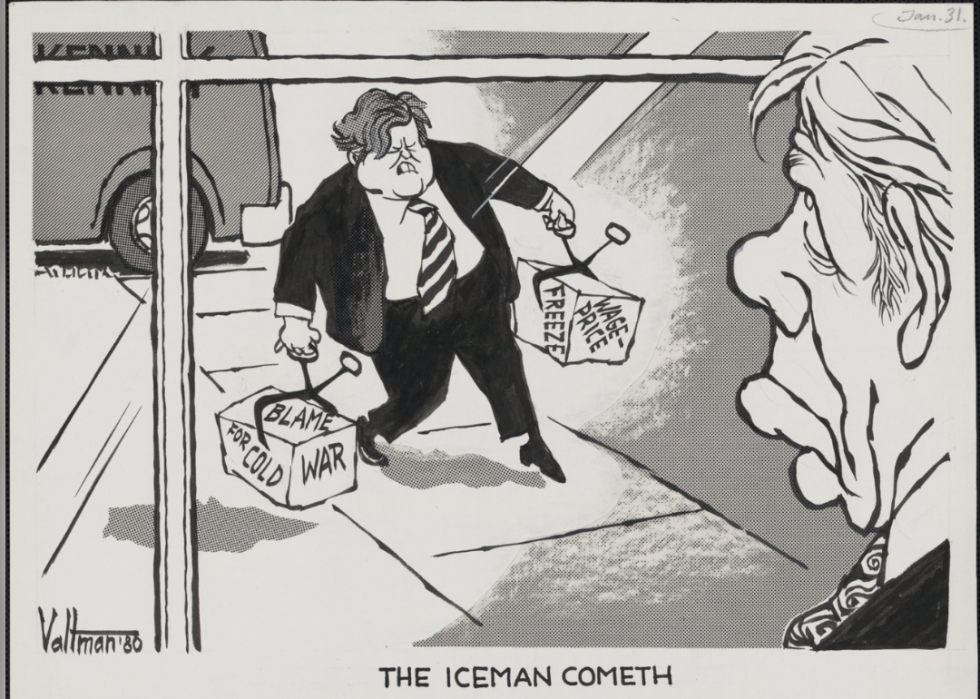
71 / 100
Edmund S. Valtman/LOC // Wikimedia Commons
1980: 'The Iceman Cometh'
Valtman depicts Sen. Ted Kennedy as a mad man with two ice blocks representing what he alleged President Jimmy Carter failed at, while Carter watches Kennedy struggle.
[Pictured: Cartoon by Edmund Valtman dated Jan. 31, 1980.]
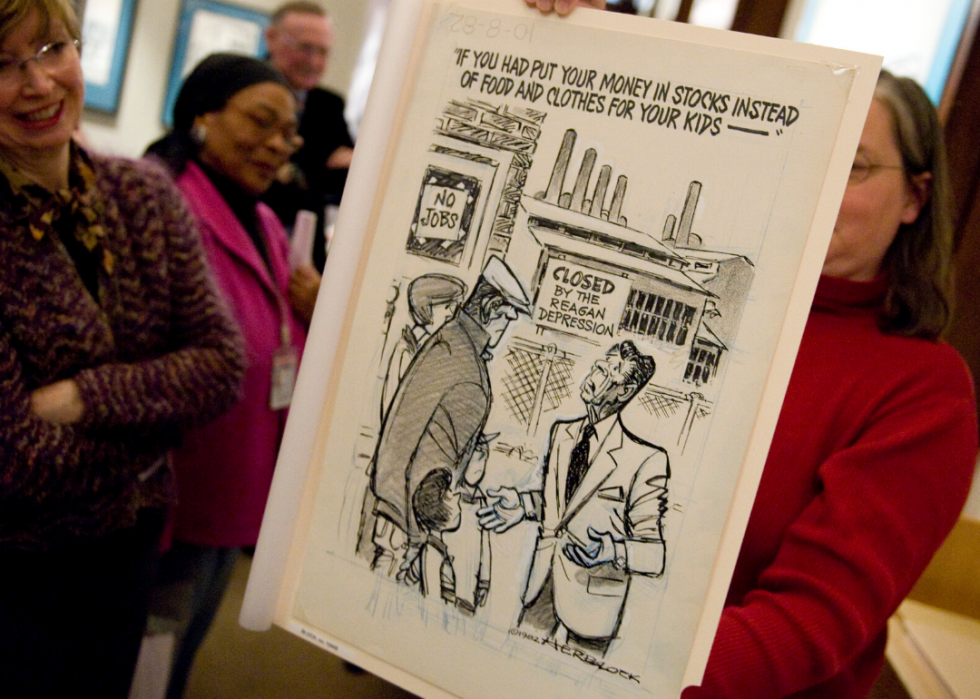
72 / 100
Tom Williams/Roll Call // Getty Images
1980s-era 'Reagan Depression' cartoon
Illustrating the toll the Reagan-era recession took on the economy, Herb Block drew a grim picture of a family being told they should have put their money in stocks instead of food.
[Pictured: Sara Duke of the Library of Congress holds a cartoon by Herb Block during a 2010 exhibition.]
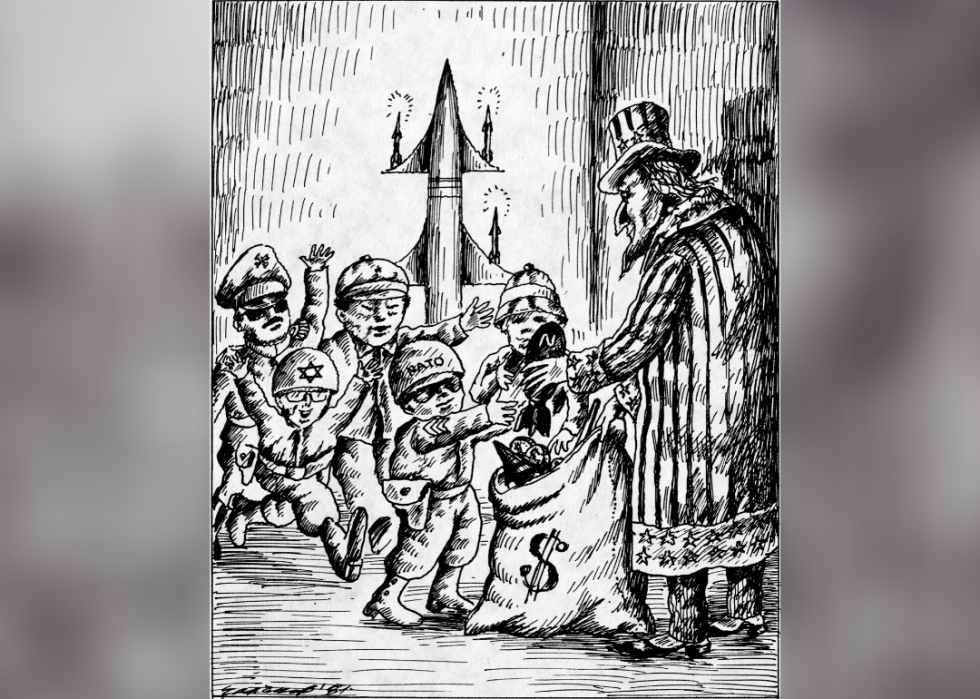
73 / 100
Michael Nicholson/Corbis // Getty Images
1981: Warheads for Christmas
- Artist: Unknown
- Published in: Unknown
Uncle Sam distributes nuclear warheads to children representing nations and entities like NATO, Iraq, and Israel. This refers to the U.S. arming Iraq to attack Iran, resulting in mass casualties.
[Pictured: Unidentified NATO Christmas cartoon dated 1981.]
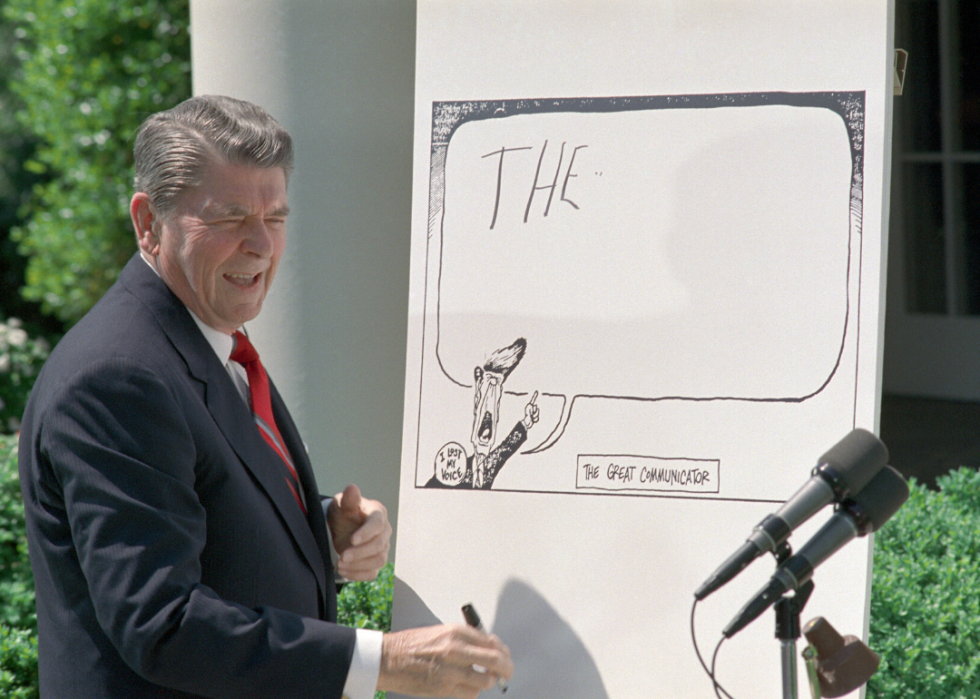
74 / 100
1987: Ronald Reagan
The picture shows President Ronald Reagan referring to a cartoon of himself. He had asked cartoonists to "take it easy" on him—a jab amidst the president regularly featuring into political cartoons.
[Pictured: President Ronald Regan at a ceremony of the American Association of Editorial Cartoonists at the White House on May 7, 1987.]
You may also like: Countries that have mandatory voting
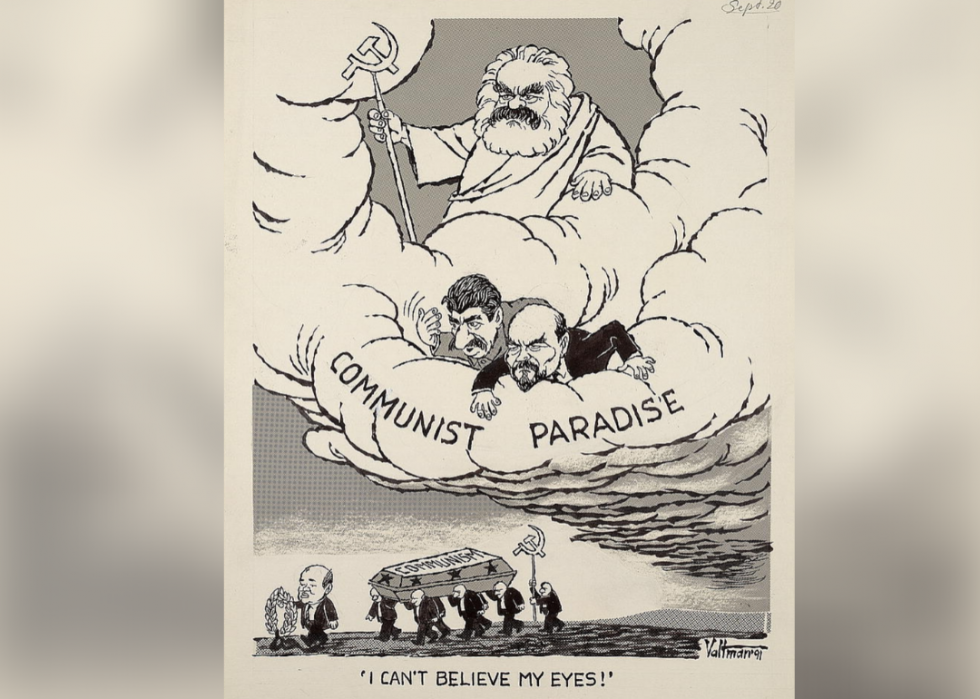
75 / 100
Edmund S. Valtman // Library of Congress
1991: 'I Can't Believe My Eyes'
Portrayed as a body in a coffin, Communism is lamented by Vladimir Lenin, Karl Marx, and Joseph Stalin at a funeral led by Mikhail Gorbachev. The cartoon referred to Gorbachev's foreign policy of appeasement, disarming the national Communist Party and hiring elected leaders.
[Pictured: Cartoon by Edmund Valtman, published in the Waterbury Republican and Middletown Press dated 1991.]
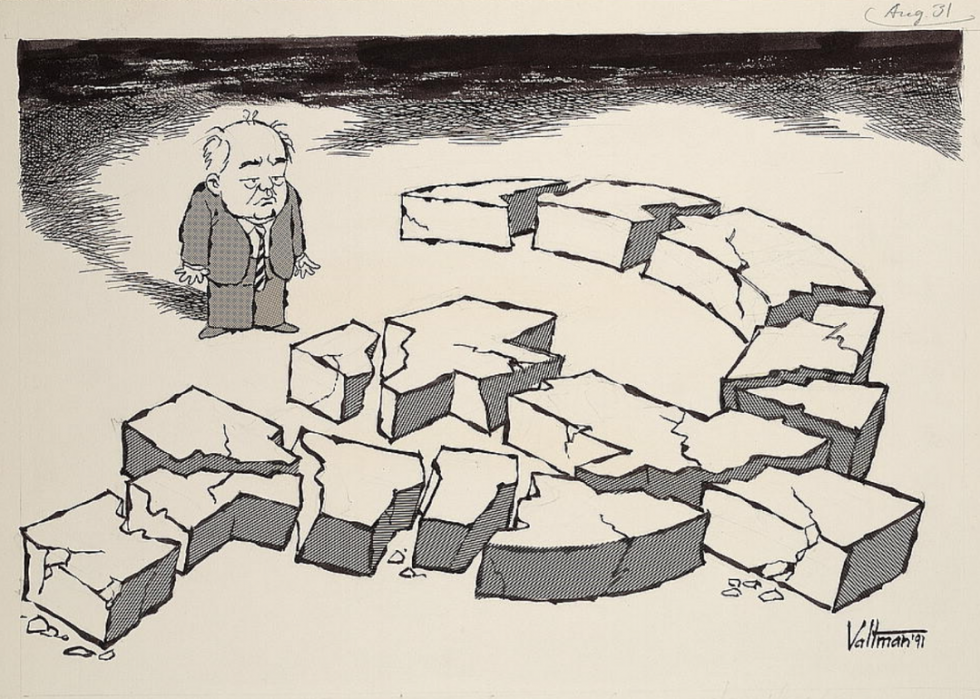
76 / 100
Edmund S. Valtman // Library of Congress
1991: Gorbachev beholds a shattered hammer and sickle
Valtman likens the new reforms implemented by Gorbachev to the fall of communism by drawing a broken sickle and hammer, the symbols of the ideology. The cartoon represents the ailing Russian economy.
[Pictured: Cartoon by Edmund Valtman for the Waterbury Republican and Middletown Press dated Aug. 31, 1991.]
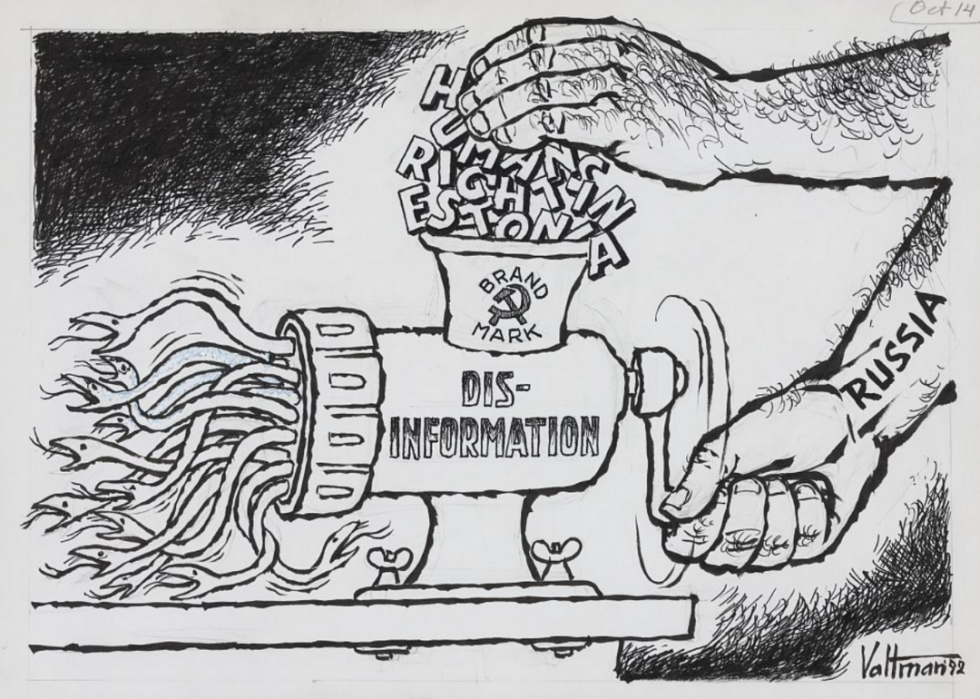
77 / 100
Edmund S. Valtman // Library of Congress
1992: 'Disinformation'
"Disinformation" suggests that Russia is feeding Estonia's human rights into a grinder with snakes coming out of the other side. The grinder itself features the hammer and sickle of communism.
[Pictured: Cartoon by Edmund Valtman dated 1991.]

78 / 100
Mario Tama // Getty Images
2002: 'The Bush Warriors, America's Battle Against Evil'
Prior to the Iraq invasion, President George W. Bush threatened retribution for the Sept. 11 attacks. This cartoon depicts the president's Cabinet, including Secretary of State Colin Powell and National Security Advisor Condoleezza Rice.
[Pictured: "The Bush Warriors, Americas battle against evil" cover of German Newsmagazine Der Spiegel dated Feb. 27, 2002.]
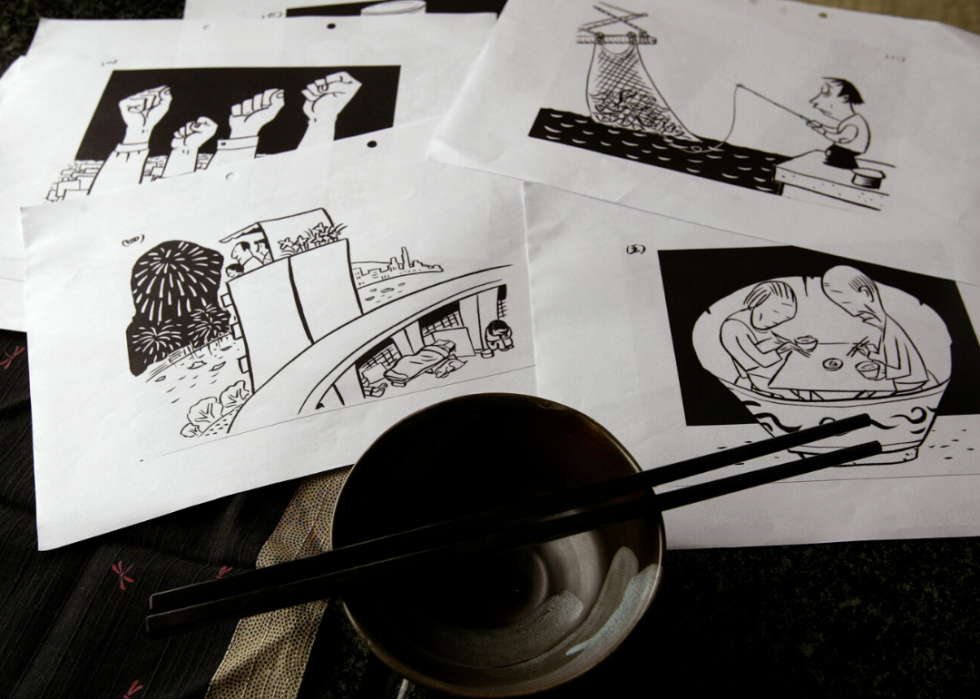
79 / 100
Dustin Shum/South China Morning Post // Getty Images
2004: Struggle to raise funds for an art center
Stacker found this picture of four cartoons, all drawn by Hong Kong cartoonist Zunzi, depicting the hardships art galleries face in collecting funding. One of the cartoons shows a man trying to fish, but all the fish have been caught in one net.
[Pictured: Cartoons by Hong Kong political cartoonist Zunzi for the South China Morning Post dated 2004. ]
You may also like: The original Woodstock, by the numbers
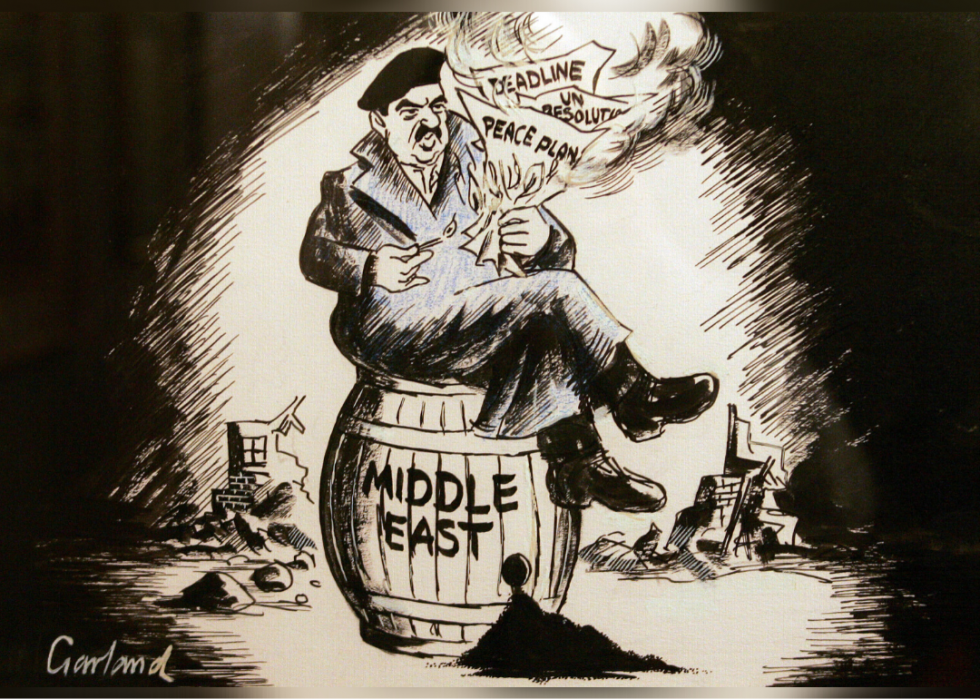
80 / 100
CARL DE SOUZA/AFP // Getty Images
2006: Saddam Hussein cartoon
Cartoonist Nicholas Garland recalls when former Iraqi leader Saddam Hussein invaded Kuwait despite threats from the United Nations Security Council. The cartoon shows Hussein sitting on an oil barrel, representing the Middle East, while burning the security council resolution and a peace plan.
[Pictured: Cartoon by Nicholas Garland as shown in a 2006 exhibition at the British Museum in London.]
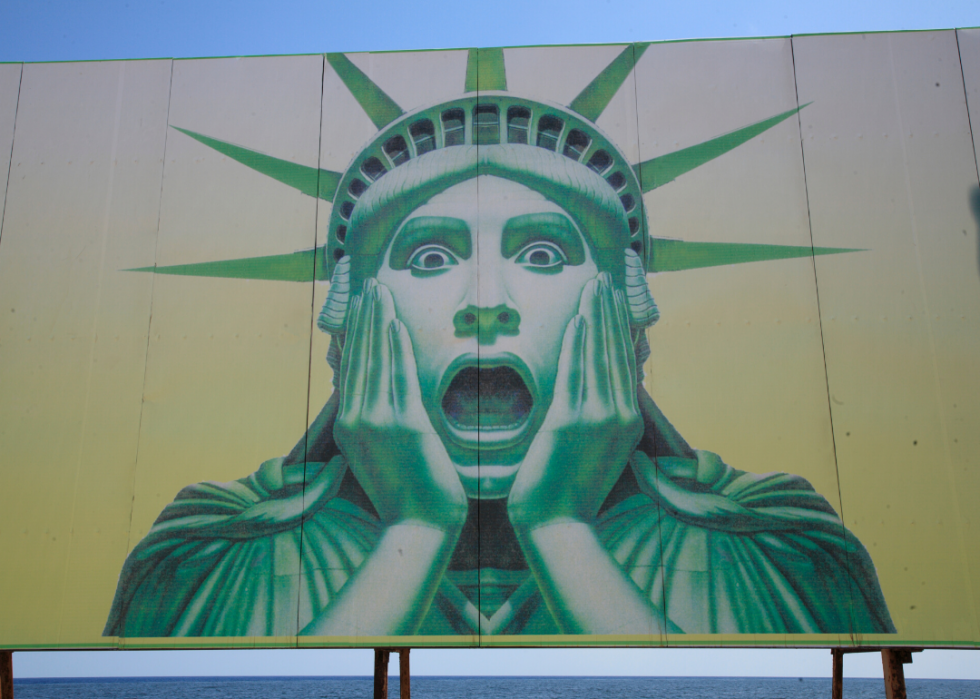
81 / 100
Robert Wallis/Corbis // Getty Images
2007: Malecon seafront billboard
- Artist: Unknown
- Published in: n/a
This Havana billboard shows a Statue of Liberty who's shocked at American foreign policy. The artist had previously depicted Iraqi prisoners at this popular seafront.
[Pictured: A billboard on the Malecon seafront in Cuba photographed in 2007.]
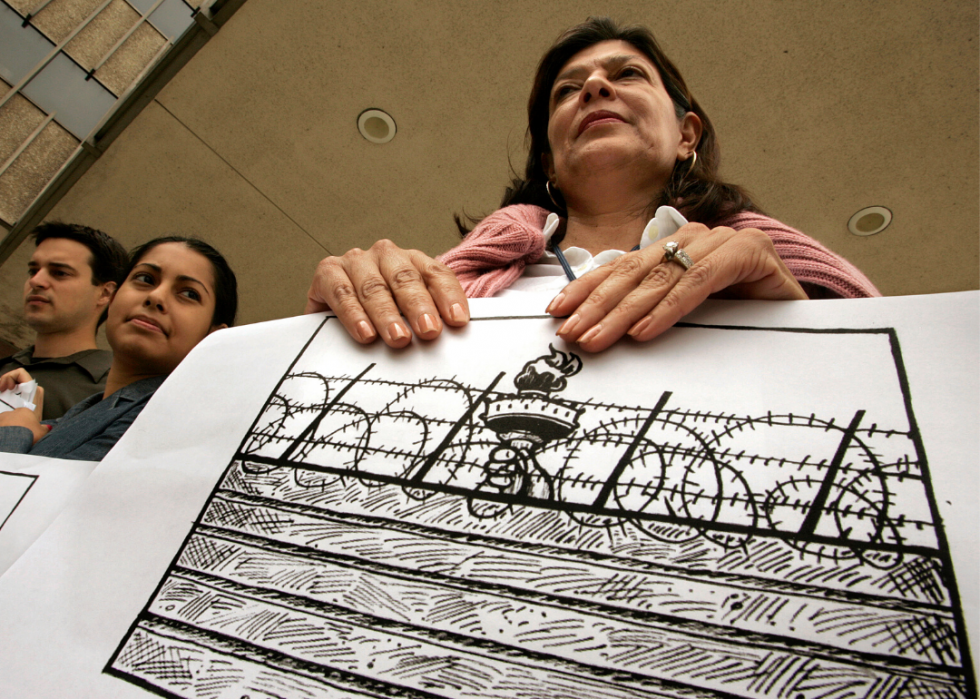
82 / 100
Mel Melcon/Los Angeles Times // Getty Images
2007: Statue of Liberty caught in barbed wire
- Artist: Unknown
- Published in: Unknown
This photo shows a cartoon depicting the Statue of Liberty's torch trapped in barbed wire. This referred to the state of U.S. immigration law. Salvadoran Amalia Molin, who was detained in 1998 for overstaying her visa, can be seen holding the cartoon.
[Pictured: Amalia Molina, a former detainee, holds an unidentified political cartoon at a press conference on May 31, 2007.]
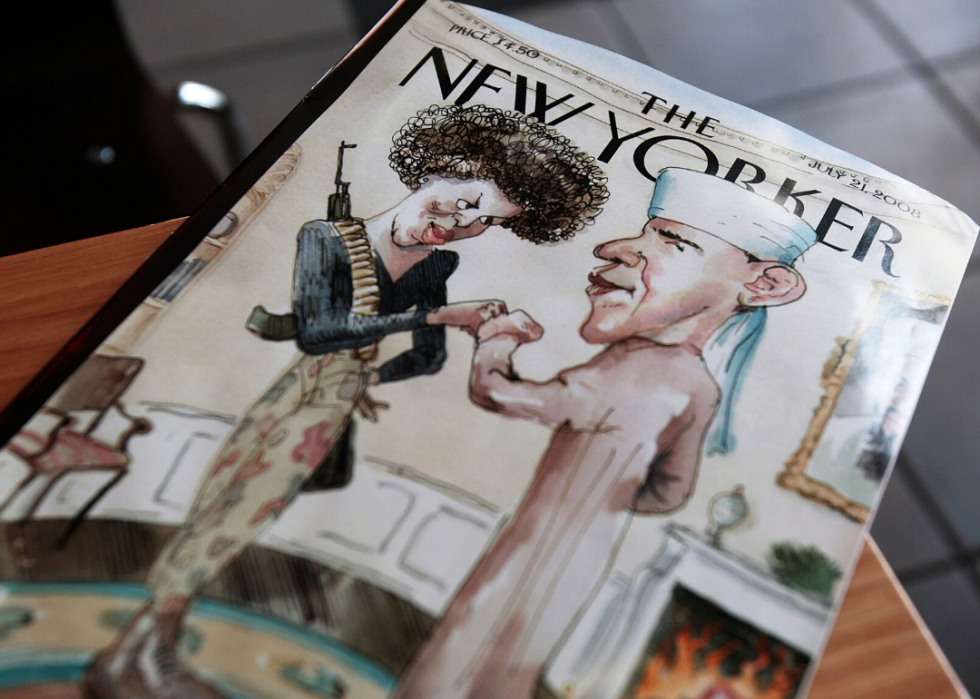
83 / 100
Chris Hondros // Getty Images
2008: Controversial New Yorker cartoon
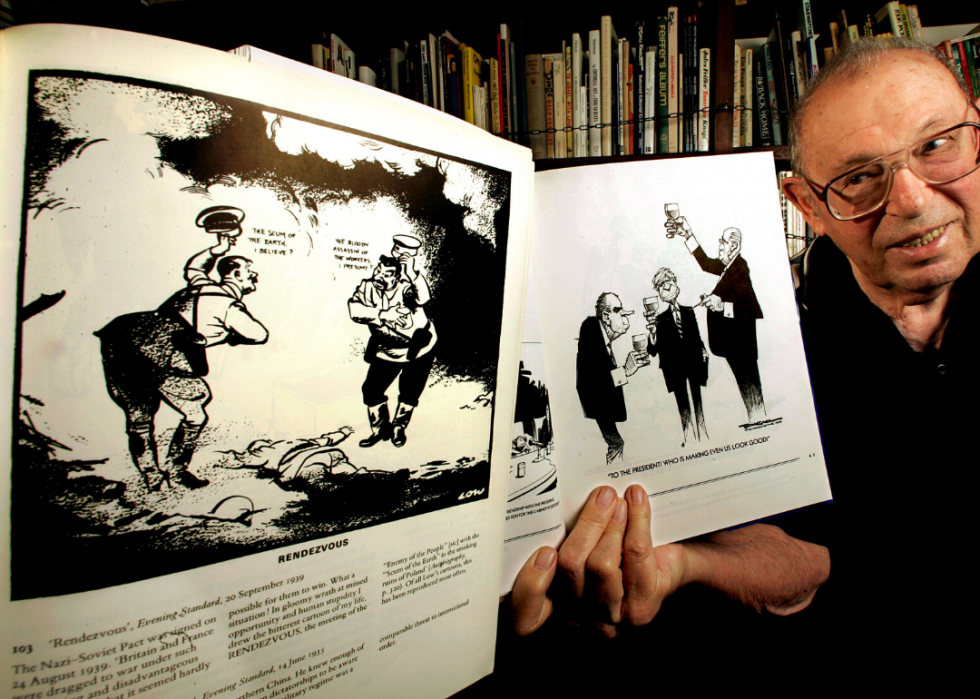
84 / 100
Mel Melcon/Los Angeles Times // Getty Images
2008: Bob Scheibel
This is a photo of political cartoonist Bob Scheibel. On the left is a cartoon of Stalin and Hitler greeting each other, drawn by David Lowe in 1939. On the right, a cartoon from 1988 where artist Paul Conrad drew Gerald Ford, Richard Nixon, and Jimmy Carter drinking together.
[Pictured: Bob Scheibel holds up political cartoons by David Low and Paul Conrad in May 2008.]
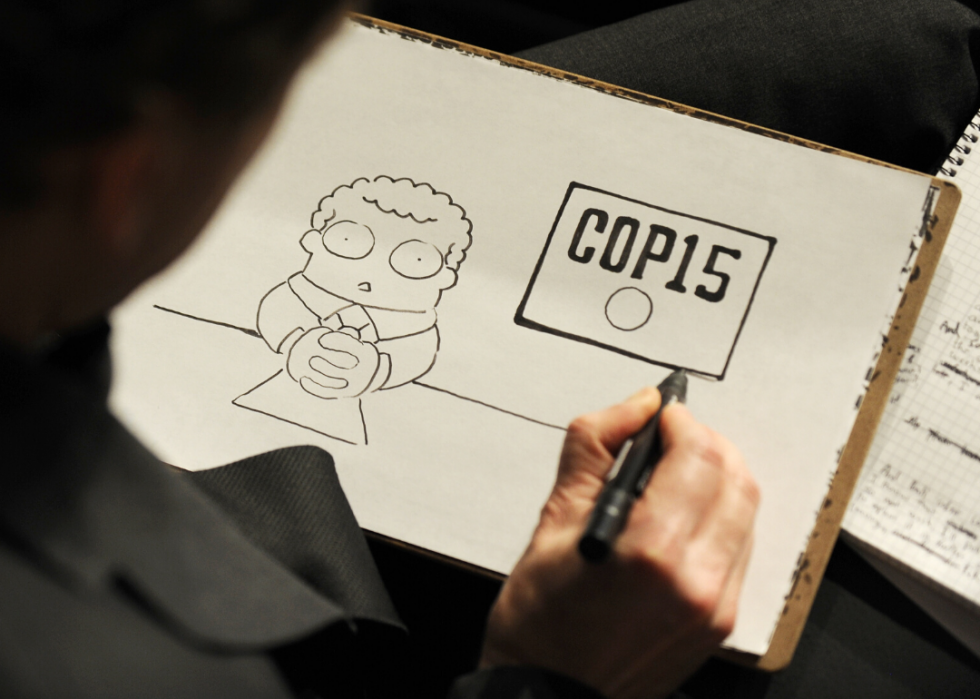
85 / 100
ADRIAN DENNIS/AFP // Getty Images
2009: COP15 UN Climate Change Conference
This photo shows an unknown journalist sketching a man waiting at a desk during the COP15 conference on biodiversity. The photo was taken at the Bella Center in Copenhagen, Denmark.
[Pictured: An unidentified journalist draws a cartoon at the COP15 UN Climate Change Conference in Copenhagen on Dec. 18, 2009.]
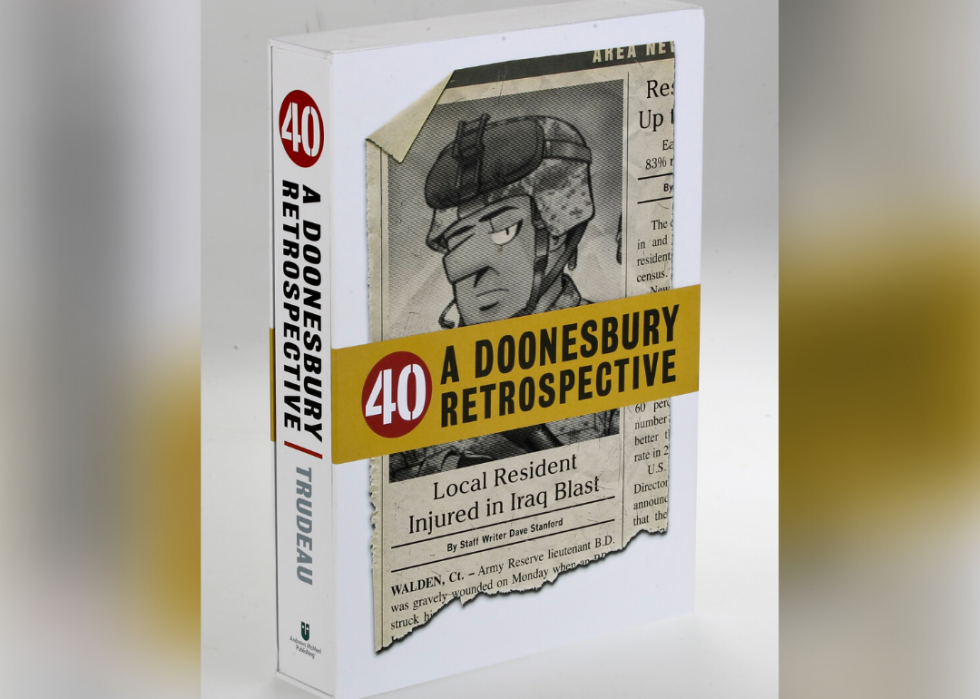
86 / 100
David Cooper/Toronto Star // Getty Images
2010: 'A Doonesbury Retrospective'
Gary Trudeau is an American cartoonist who created "A Doonesbury Retrospective," a comic strip offering a counterculture view with a sharp wit. It's endured in popularity due to its relatable deadpan humor.
[Pictured: A Doonesbury Retrospective by G.B. Trudeau published by Andrews McMeel Publishing 2010.]
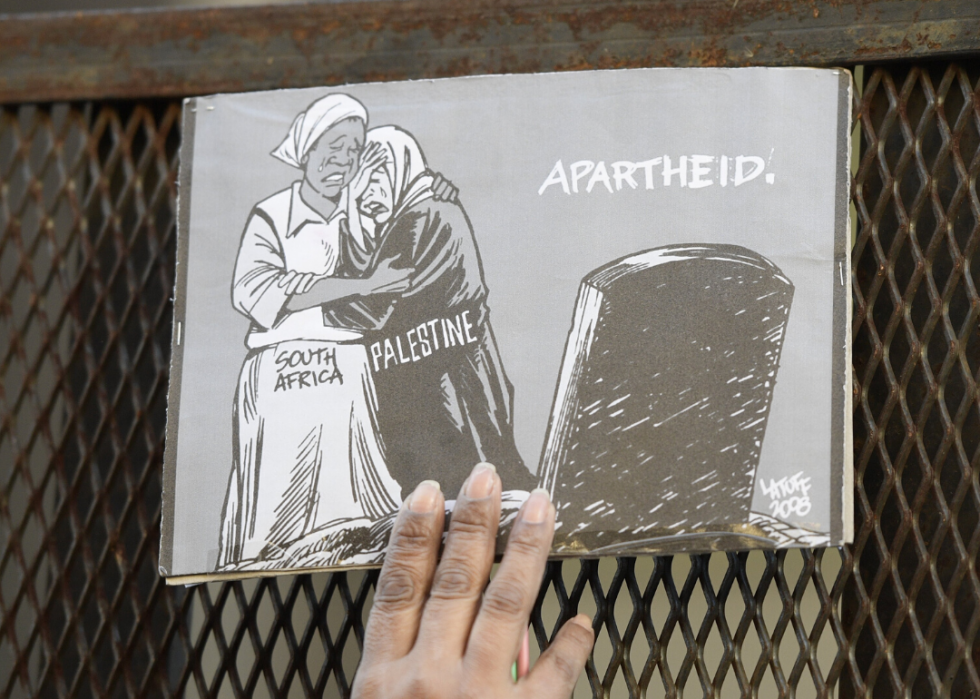
87 / 100
UAN MABROMATA/AFP via Getty Images
2017: Apartheid cartoon
A woman holds up a cartoon of a woman crying in this photo, representing Palestine, while one representing South Africa consoles her. This refers to Israel's policies on the Palestinian territories. The cartoon, titled "Apartheid," was displayed during Israeli Prime Minister Benjamin Netanyahu's visit to Buenos Aires.
[Pictured: A woman holds up an identified political cartoon dated 2008 during a protest in front of the Israeli embassy in Buenos Aires on Sept. 12, 1017. ]
You may also like: How well do you remember 1969?
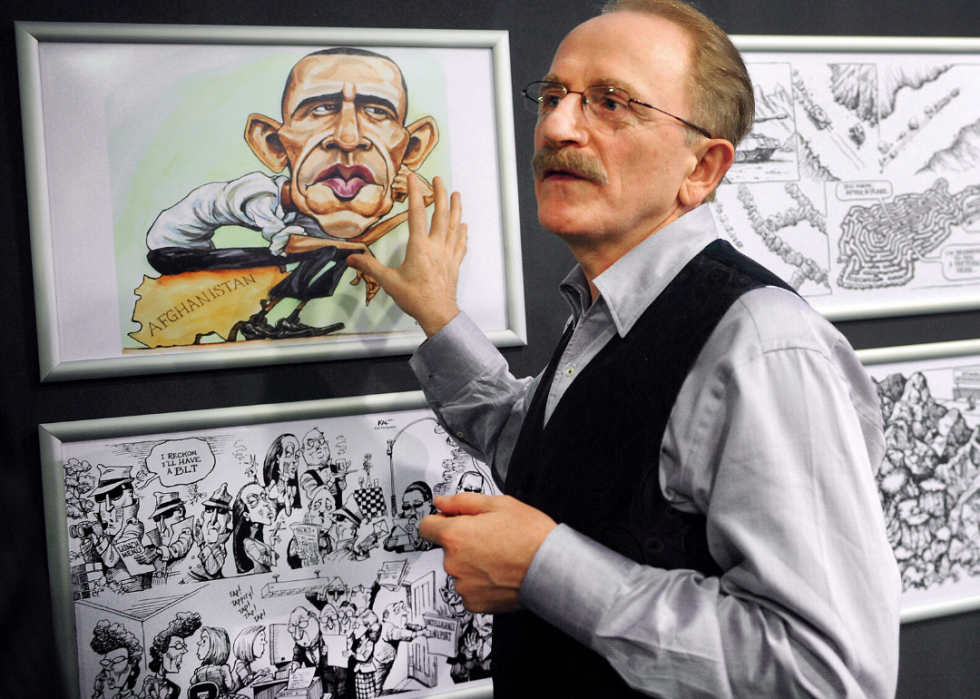
88 / 100
DANIEL MIHAILESCU/AFP // Getty Images
2012: Cartoons on the frontline of freedom
- Artist: Unknown
- Published in: n/a
In this photo, cartoonist Kevin Kal Kallaugher stands next to his caricature of a pensive Barack Obama sitting on a wall that reads "Afghanistan." The photo was taken at the National Museum of Contemporary Art in Bucharest, Romania. Kallaugher alluded to the dangers faced by political cartoonists.
[Pictured: Cartoonist Kevin KAL Kallaugher with his work during an May 2012 exhibition in Bucharest.]
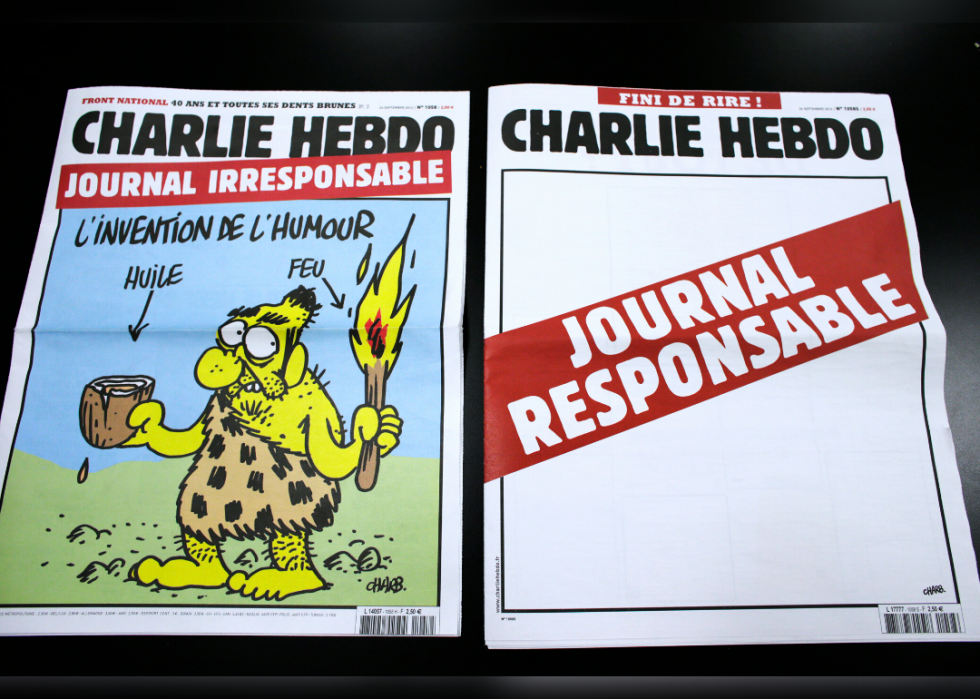
89 / 100
KENZO TRIBOUILLARD/AFP // Getty Images
2012: Charlie Hebdo cartoon
French satirical magazine Charlie Hebdo's two covers for the same issue—Sept. 25, 2012—highlighted the fine line between freedom of speech and blasphemy. In 2015, the magazine was attacked by terrorists who also killed shoppers at a kosher grocery store. 17 people in total lost their lives.
[Pictured: Two editions of French satirical magazine Charlie Hebdo as photographed on Sept. 25, 2012, in Paris.]
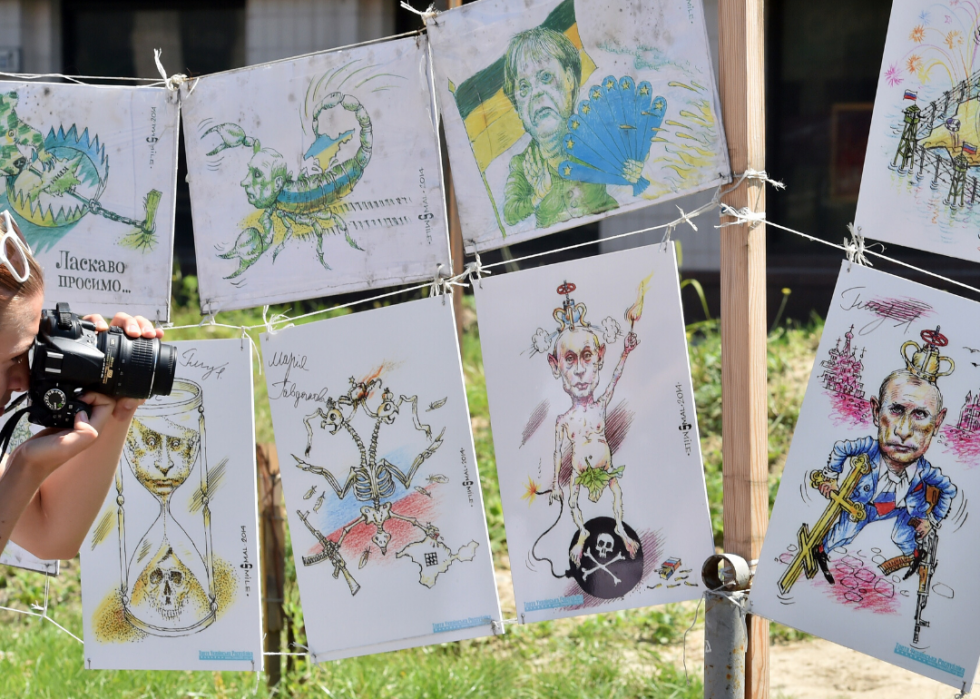
90 / 100
SERGEI SUPINSKY/AFP // Getty Images
2014: Satirical cartoons of Vladimir Putin
This photo by Sergei Supinsky shows a woman photographing journalist and artist Oleh Smal cartoons of Vladimir Putin. The exhibit was held on July 29th, the same day the EU planned to impose economic sanctions on Russia for meddling in Ukraine.
[Pictured: A woman photographs caricatures of Russian President Vladimir Putin at an open-air exhibition by Ukrainian cartoonist, architect and journalist Oleh Smal, in the center of Kiev on July 29, 2014.]
You may also like: 25 terms you should know to understand the health care debate
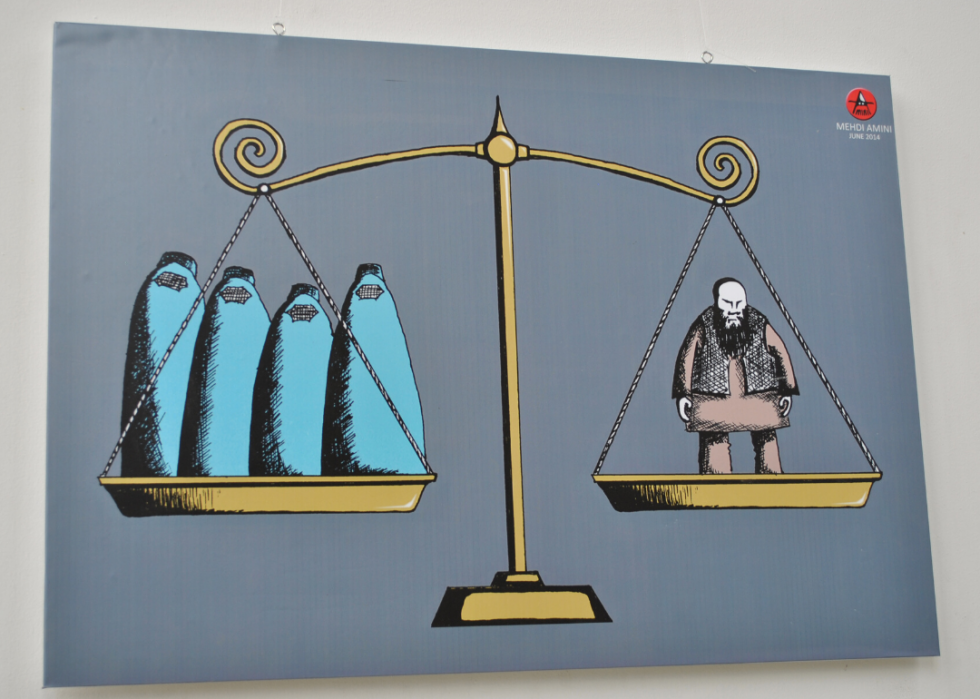
91 / 100
Muhammed Fahim/Anadolu Agency // Getty Images
2014: Caricature exhibition in Afghanistan
This image shows a balancing scale with a bearded man on one side and four women dressed in Islamic garments on the other. The scale is balanced in equilibrium to show that in certain conservative religious societies, such as Afghanistan, one man is considered to be worth the same as four women.
[Pictured: A caricature is displayed at French Cultural Center created by artist and cartoonist Mehdi Amini in Kabul, Afghanistan, on Aug. 30, 2014.]
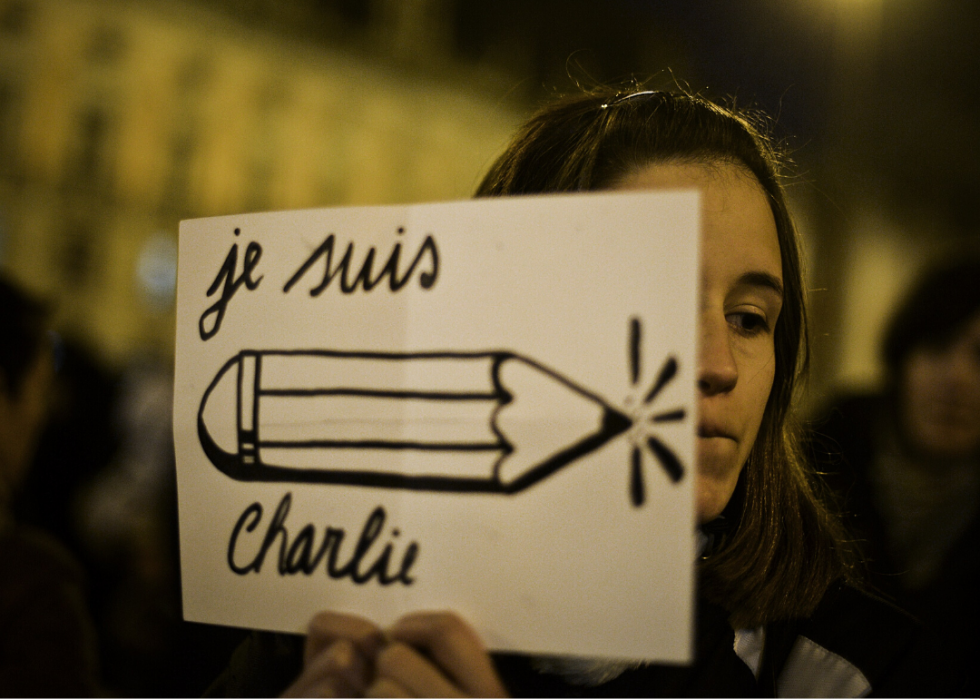
92 / 100
PATRICIA DE MELO MOREIRA/AFP // Getty Images
2015: France attacks media tribute
A woman holds a picture of a pencil above the text "Je Suis Charlie" as part of a protest in the wake of the Charlie Hebdo terror attack. The demonstration came in the midst of public outcry following the deaths of 12 staff members at the office of the controversial French political magazine.
[Pictured: A woman in Lisbon holds a poster reading "Je Suis Charlie (I Am Charlie)" during a tribute for victims of a terror attack on French satirical weekly Charlie Hebdo on Jan. 8, 2015.]
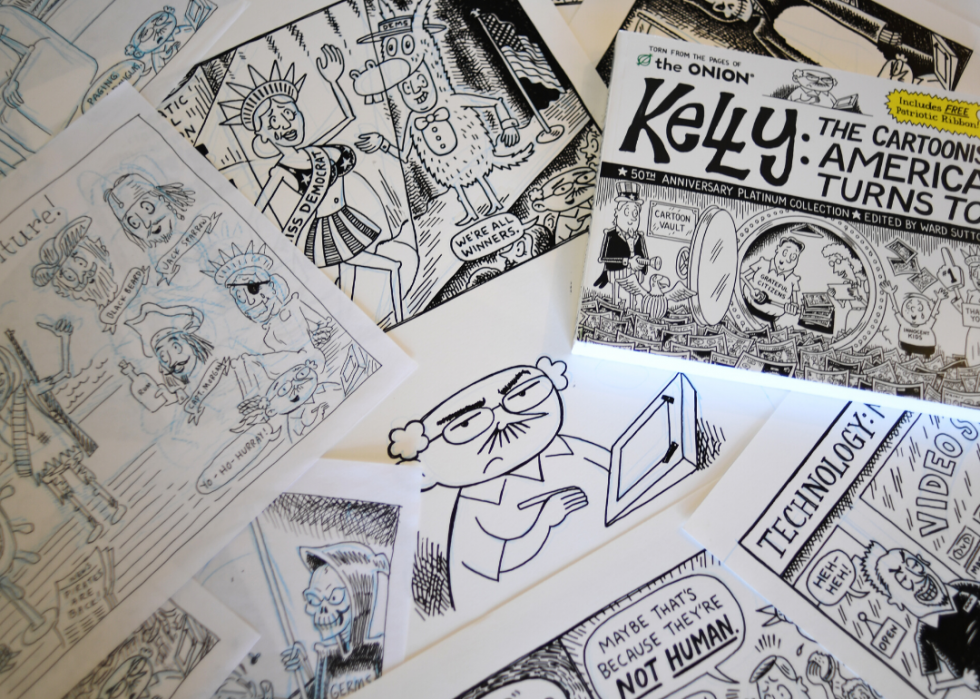
93 / 100
RJ Sangosti/The Denver Post // Getty Images
2016: Ward Sutton cartoons for the Onion
The image shows a selection of cartoons by Ward Sutton, the cartoonist for the satirical online publication the Onion. Sutton's sketches can be found under the alias "Kelly."
[Pictured: Works by the Kelly (Ward Sutton) a political cartoonist for The Onion photographed in 2016.]
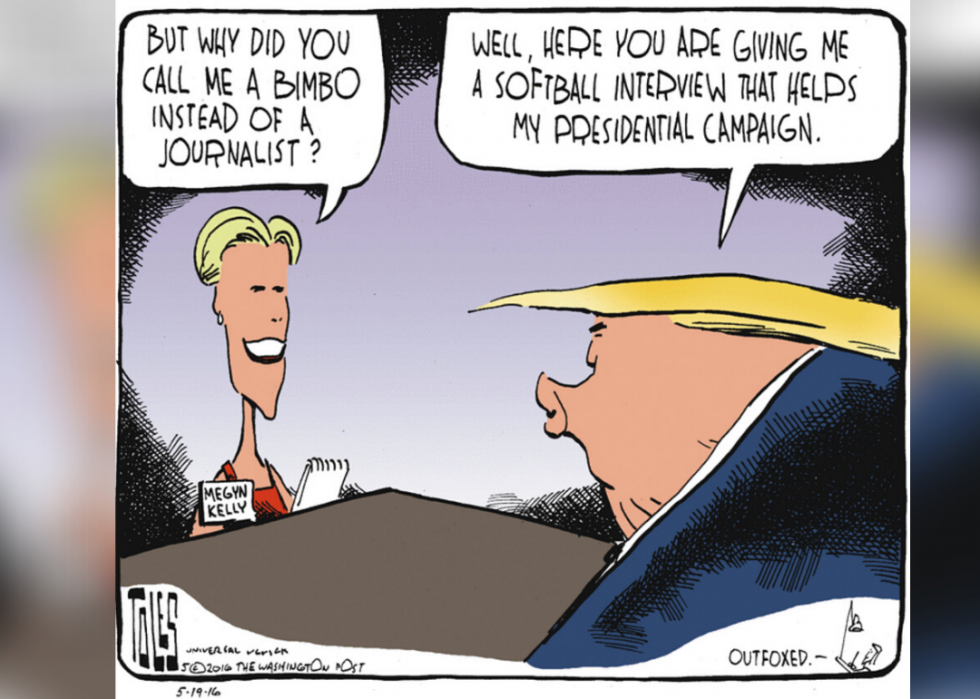
94 / 100
Tom Toles/The Washington Post// Getty Images
2016: Illustration of Donald Trump
This cartoon depicts Fox News host Megyn Kelly interviewing President Donald Trump during the 2016 presidential campaign. Kelly asks Trump why he called her a derogatory name, to which he replies, "Well, here you are giving a softball interview that helps my campaign." Trump and Kelly were involved in heated arguments during the 2016 presidential race.
[Pictured: Cartoon by Tom Toles for the Washington Post dated May 19, 2016.]
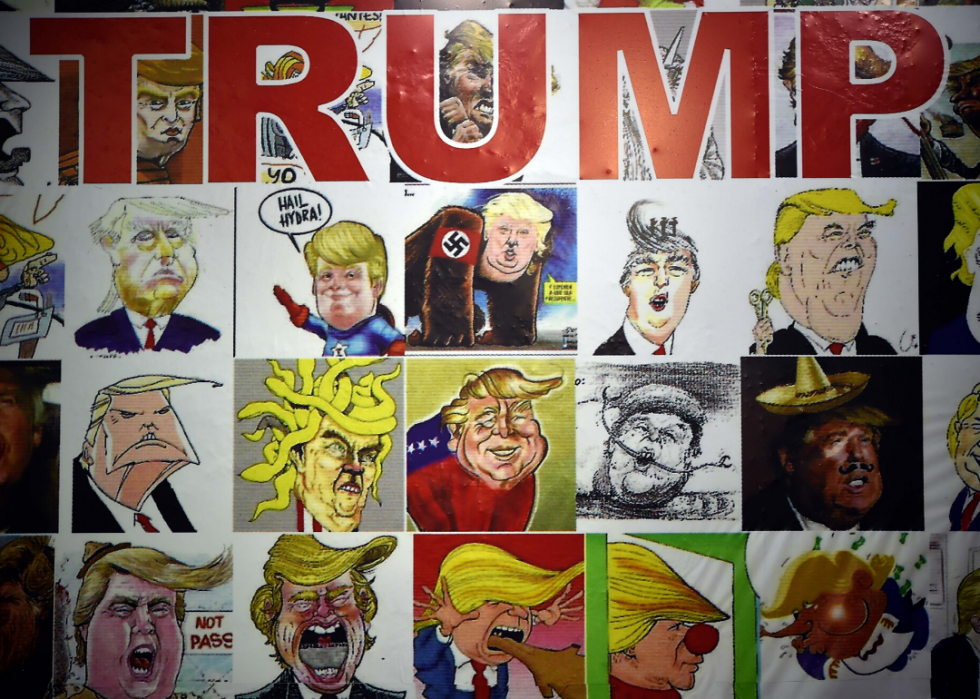
95 / 100
YURI CORTEZ/AFP // Getty Images
2016: A wall of Trump caricatures
This wall is full of caricatures dedicated to then-candidate Donald Trump following a debate with Hillary Clinton. It's an array of depictions from a country Trump has notably disparaged in the public arena.
[Pictured: Caricatures depicting US Republican presidential candidate Donald Trump, are displayed as part of the exhibition "A Wall of Caricatures", at the Caricature Museum in Mexico City on Oct. 17, 2016.]
You may also like: Can you answer these real 'Jeopardy!' questions about politics?
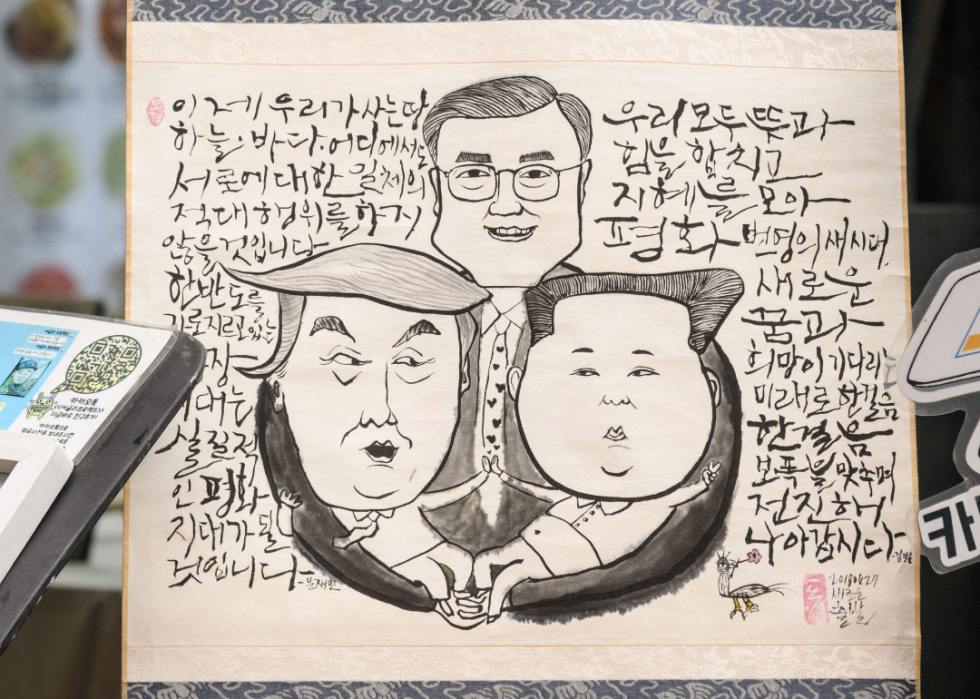
96 / 100
ED JONES/AFP // Getty Images
2018: North Korea-South Korea relations
This sketch shows South Korean President Moon Jae-In embracing and North Korean leader Kim Jong-Un, in reference to recent diplomacy developing between the three countries.
[Pictured: A cartoon depicting South Korea's president Moon Jae-in embracing U.S. President Donald Trump and North Korea's leader Kim Jong Un is displayed outside a shopping center in Seoul on Sept. 19, 2018.]
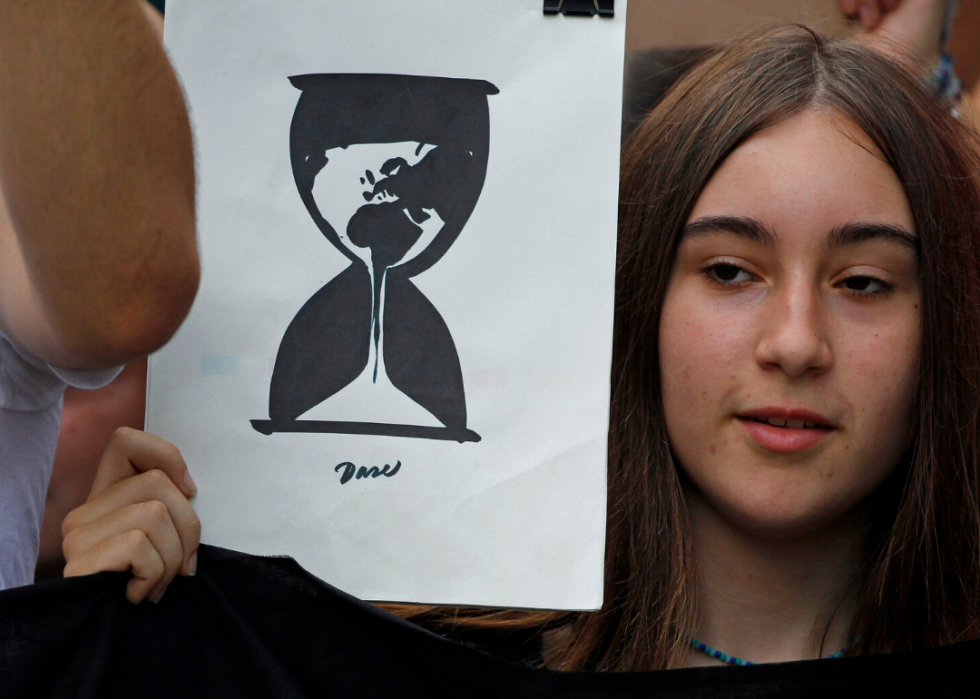
97 / 100
Joan Valls/Urbanandsport /NurPhoto // Getty Images
2019: Fridays For Future
- Artist: Unknown
- Exhibited: Seoul, South Korea
A climate change activist attends the Fridays for Future demonstration. She holds a placard featuring the planet depicted as sand within an hourglass, a strong suggestion that time is running out.
[Pictured: A woman displays an unidentified political illustration at the climate strike in Barcelona on Sept. 27, 2019.]
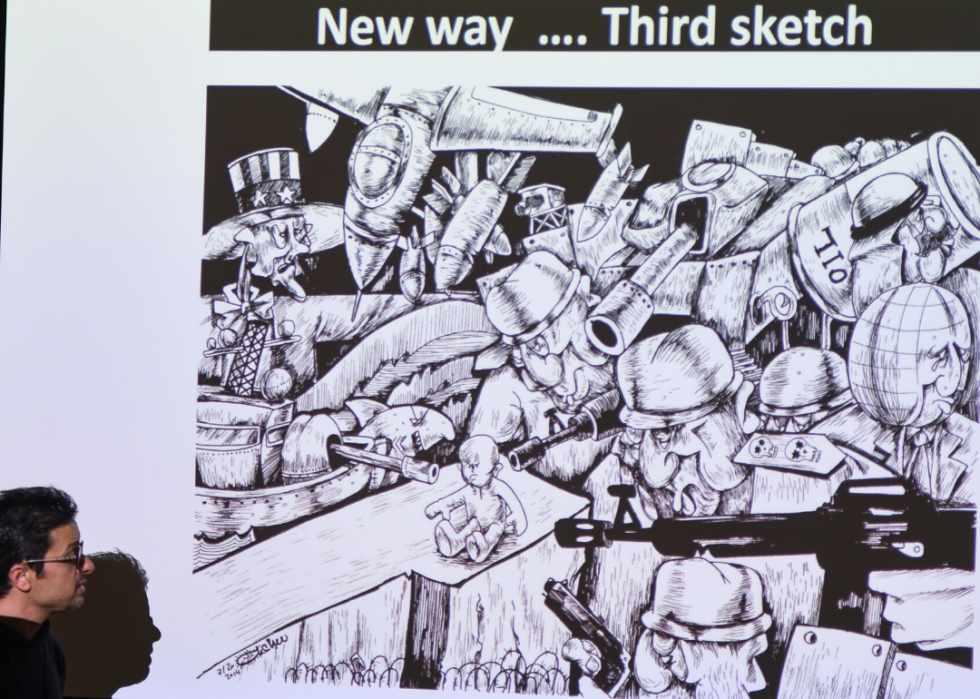
98 / 100
Artur Widak/NurPhoto // Getty Images
2019: 'Art and Resistance in Palestine'
This photo shows Palestinian artist Mohammed Saba'aneh attending an Art and Resistance in Palestine event at Trinity College in Dublin, Ireland. The event was organized by a local branch of the Boycott, Divestment, Sanctions (BDS) movement, which aims to end the Israeli occupation of the West Bank.
[Pictured: Palestinian artist Mohammad Sabaaneh at the event "Art & the Resistance in Palestine" in Dublin in March 2019.]
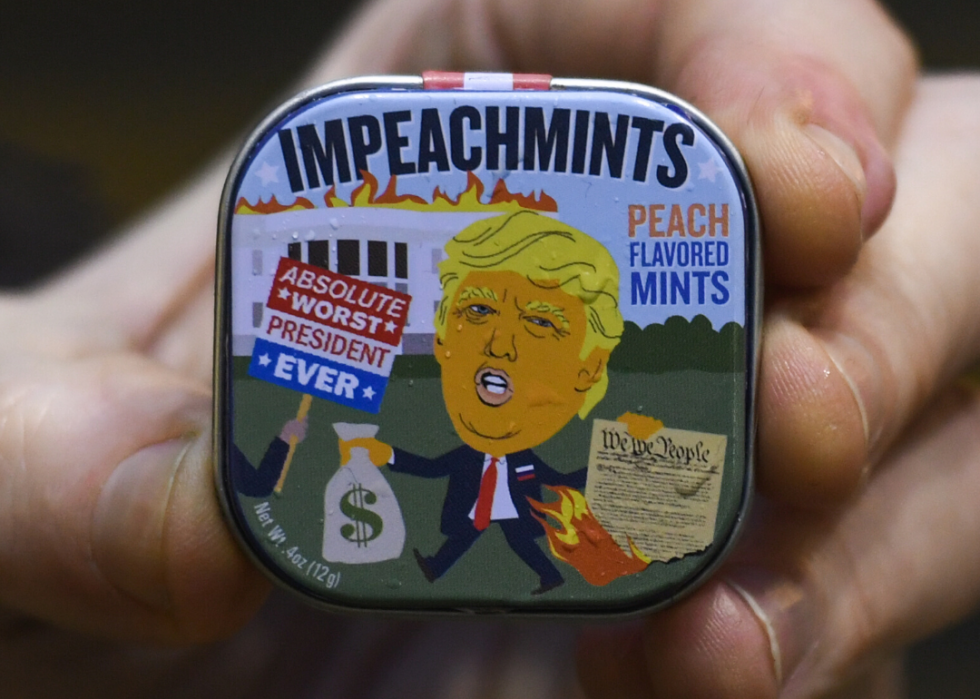
99 / 100
Artur Widak/NurPhoto // Getty Images
2019: A box of 'Impeachmints'
This box is a token given to Balla Ban Art Gallery clients in Dublin. The peach-flavored mints inside allude to the impeachment of President Donald Trump.
[Pictured: A box of "Impeach-mints" on display outside of Balla Ban Art Gallery in Dublin on Dec. 19, 2019.]
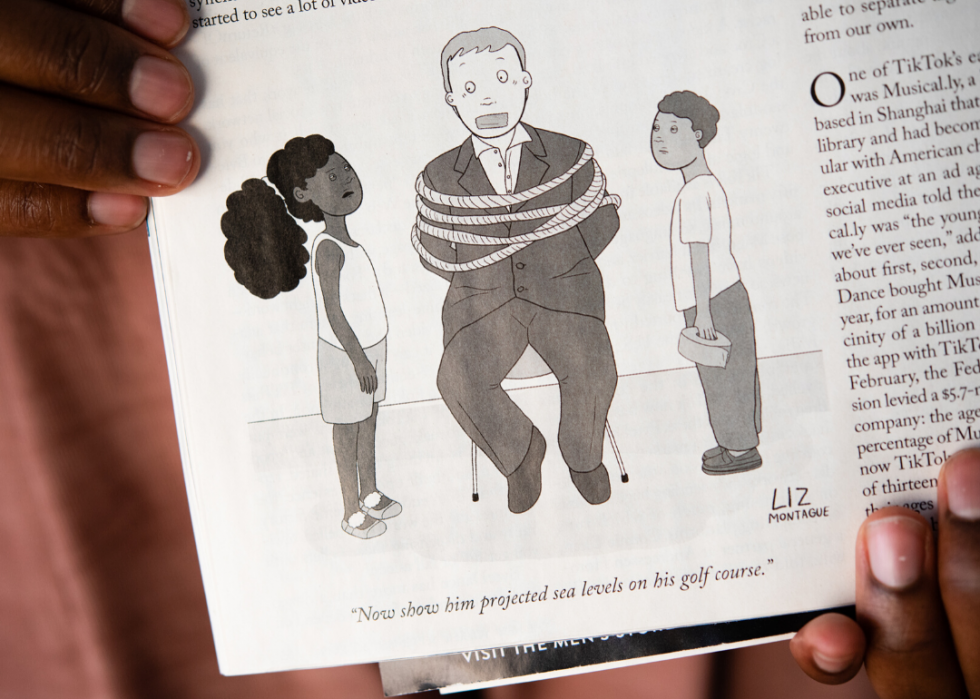
100 / 100
Sarah L. Voisin/The Washington Post // Getty Images
2020: Children warn of climate change risks
Cartoonist Elizabeth Montague is photographed at her apartment in January 2020. Her work has appeared in numerous publications. In this photo, she holds a cartoon that appeared in the New Yorker depicting children warning a restrained businessman of the hazards of climate change.
[Pictured: Elizabeth Montague displays one of her cartoons that appeared in the New Yorker.]
You may also like: The only 7 countries that are on track to meet the Paris Agreement—and how they're doing it
Trending Now
© Stacker 2022. All rights reserved.
Source: https://stacker.com/stories/3939/political-cartoons-last-100-years
0 Response to "Primates Using Tools Funny Political Cartoons"
Enregistrer un commentaire